

Sar Pass Trek
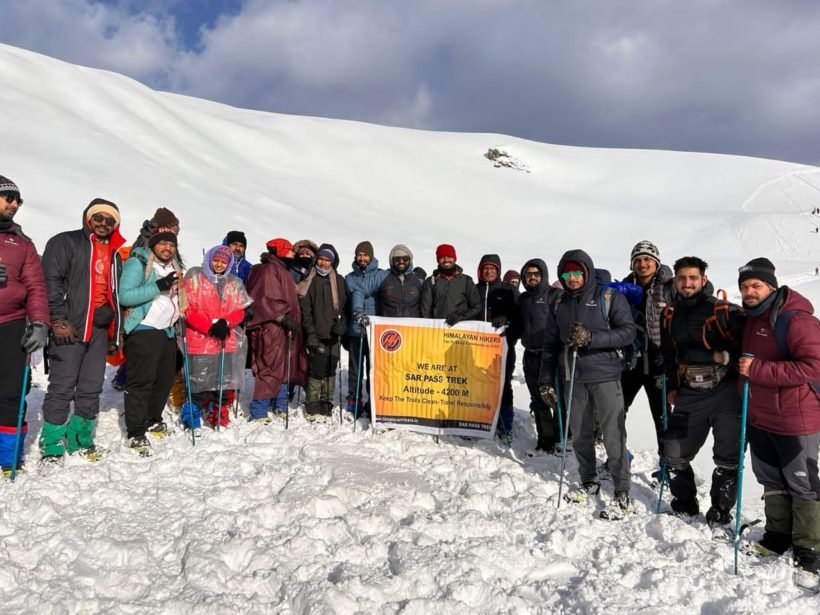
Description
Reviews (0), things to take, available dates, include / exclude, the sar pass trek is a popular trekking route in the parvati valley of himachal kasol – india. -2024- complete information, itinerary, route, map, best season.
Sar Pass Trek is a stunning trek from Grahan village ending in Barhseini in Kullu Valley . The trek is recommended for all those who love adventure, snowy landscapes, and high mountains.
The trek starts from Kasol where you will PASS through pine forests, magnificent meadows, snow-capped mountains, and some of the most jaw-dropping landscapes which make Sar Pass one of the best treks for beginners. You will also PASS by a frozen lake (Called Sar in the local dialect) from where it got its name.
The total trek distance is 37 km. Once you reach the PASS almost close to 14,000ft, the view from the PASS is absolutely breathtaking because of the majestic mountains of Parvati Valley.
Here are some highlights of the Sar Pass Trek:
- Scenic Beauty: The trek takes you through beautiful forests of oak, pine, and deodar trees, offering stunning views of the surrounding Himalayan ranges. You’ll come across enchanting meadows, gushing streams, and charming villages, making it a visual treat for nature lovers.
- Sar Pass: The highlight of the trek is reaching the Sar Pass, which sits at an altitude of approximately 13,800 feet (4,200 meters). The pass offers panoramic views of the snow-clad peaks of the Parvati Valley, Tosh Valley, and the mighty Himalayas.
- Challenging Terrain: The Sar Pass Trek is considered moderately difficult, making it an ideal choice for trekkers looking for a challenge. The trail includes steep ascents, narrow ridges, and tricky descents, which add an adventurous element to the journey.
- Camping Experience: During the trek, you’ll get to experience camping in the serene Himalayan wilderness. Camping sites like Grahan, Min Thach, Nagaru, and Biskeri Thach offer stunning views and a chance to connect with nature.
- Cultural Interaction: The Sar Pass Trek takes you through traditional Himachali villages where you can interact with the locals and get a glimpse into their way of life. It’s an opportunity to learn about the local culture, traditions, and cuisine.
- Adventurous Activities: The Sar Pass Trek also offers opportunities for adventure activities like rappelling and rock climbing. These activities add an extra thrill to the overall trekking experience.
- Hot Springs: After completing the Sar Pass Trek, you have the option to visit the nearby Manikaran hot springs. These natural hot water springs are considered sacred and are believed to have medicinal properties. It’s a perfect way to relax and rejuvenate after the trek.
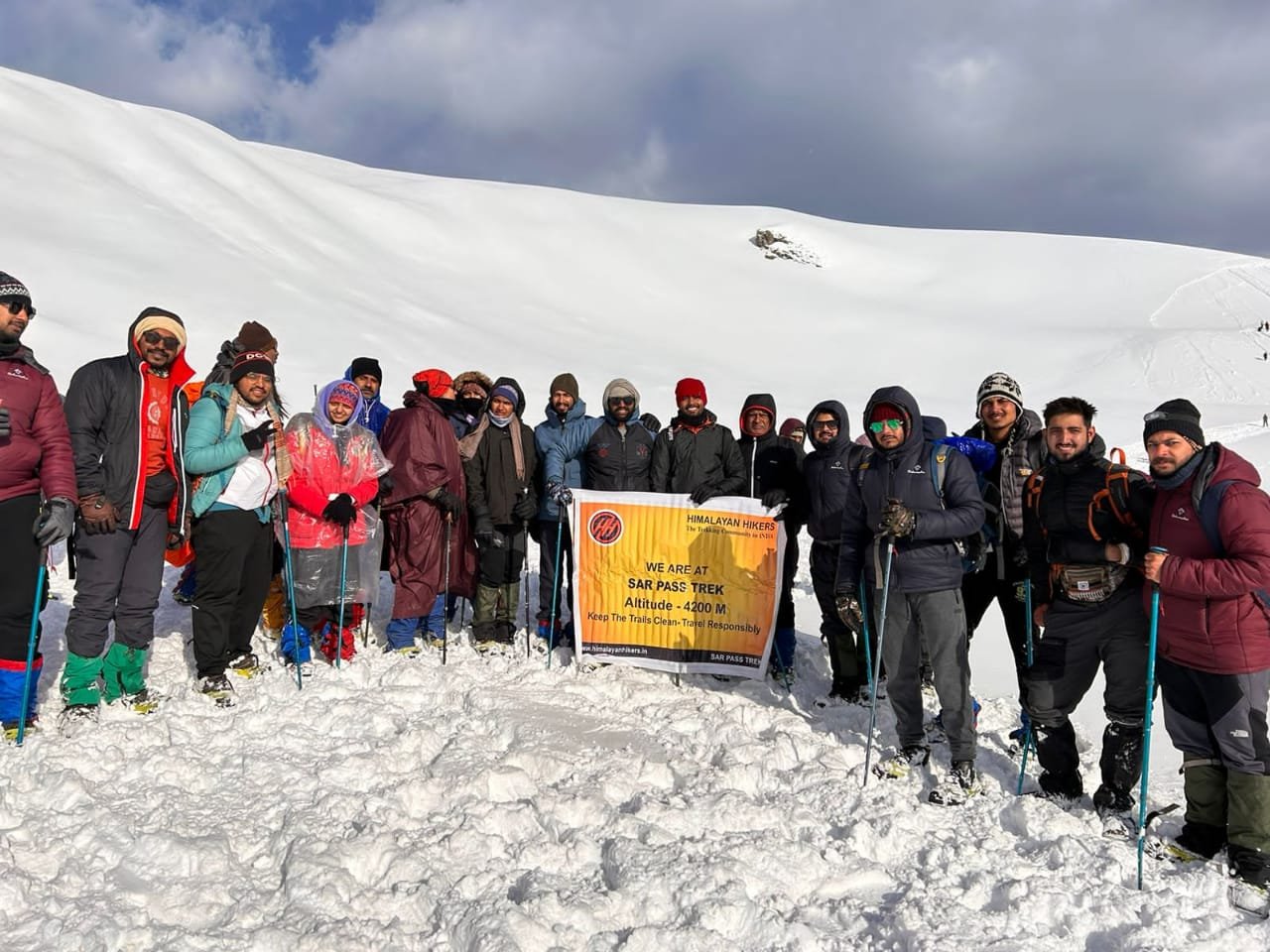
This trek will surely give an Adrenalin rush and thrilling experience adorned with alpine forests, wildflowers, and magical valleys.
Sir Pass Trek is a high-altitude mountain pass trek located in the state of Himachal Pradesh in India. It is considered to be one of the most challenging and scenic treks in the region. The trek begins from the village of Kasol and takes you through the lush green forests, meadows, and valleys of the Parvati Valley.
One of the unique features of Sir Pass Trek is the diverse landscapes and terrain it covers. The trek takes you through pine forests, river streams, and vast meadows, and also involves crossing high-altitude passes covered in snow and ice. This diversity in terrain and landscape makes the trek all the more challenging and exciting for adventure seekers.
Another special aspect of the Sir Pass Trek is the breathtaking views it offers. During the trek, you will get to witness stunning vistas of snow-capped peaks, glaciers, and valleys. The trek also takes you through remote villages and hamlets where you can experience the local culture and traditions.
Overall, the Sir Pass Trek is a unique and challenging adventure that offers a truly unforgettable experience for trekkers and nature lovers.
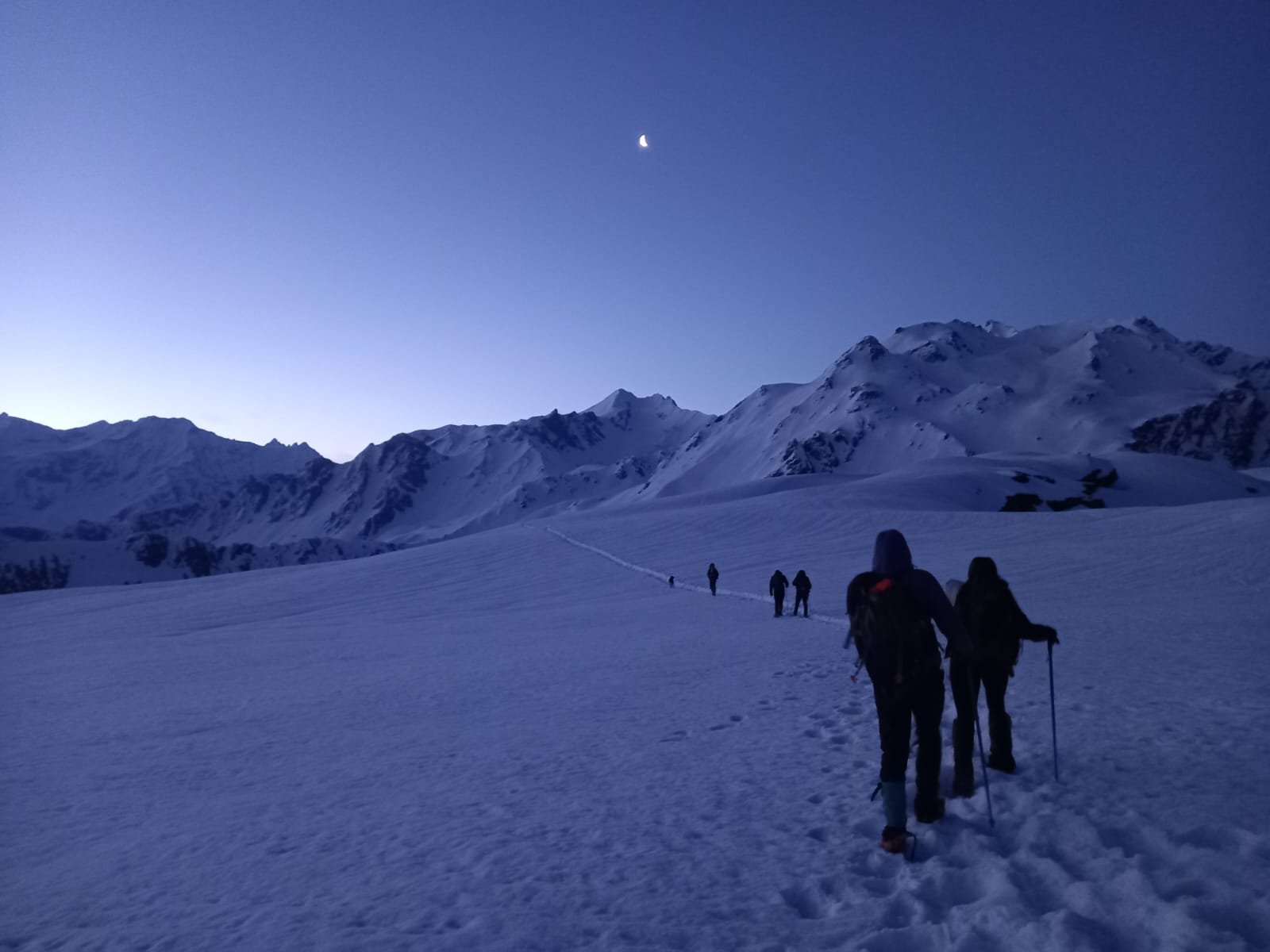
PASS by a glacial Lake SAR Himachal Pradesh
SAR means Lake in the local language, this trek which is at an altitude of 13,816 feet is named Sar Pass because you have to PASS by a glacial Lake “Sar”. It lies in the Parvati valley of Himachal Pradesh and the starting point of this trek is Kasol.
Because of its ease of difficulty, this trek is ideal for first-time trekkers. It’s a classic choice for those who want to explore a variety of terrain all in one trek. This trail provides trekkers with a range of experiences, including forests, meadows, quaint villages, and snow-covered mountains.
- Experience the majestic views and local legends of these spectacular snow-capped peaks.
- Get a chance to explore the wild and exotic vegetation of the Himalayas. Pink rhododendrons painting the trails at various points is a sight not to be missed
- Challenge yourself to explore the thrill of various ascends and descends.
- Immerse yourself in the breathtaking view from the top of Sar Pass.
- The lavish green meadows of Biskeri Thatch would exceptionally persuade you to yearn for more.
- Bring back a lot of souvenirs and memories from this journey.
Sar Pass Trek is an Ultimate Trek for Beginners
One can experience all kinds of trails, and go through Himalayan old fashioned and alluring villages, wide and narrow meadows and forests.
You get to experience terrain varieties on this trek and its starting point is Kasol , away from cities . The people from different areas visit this place and it’s a famous tourist destination.
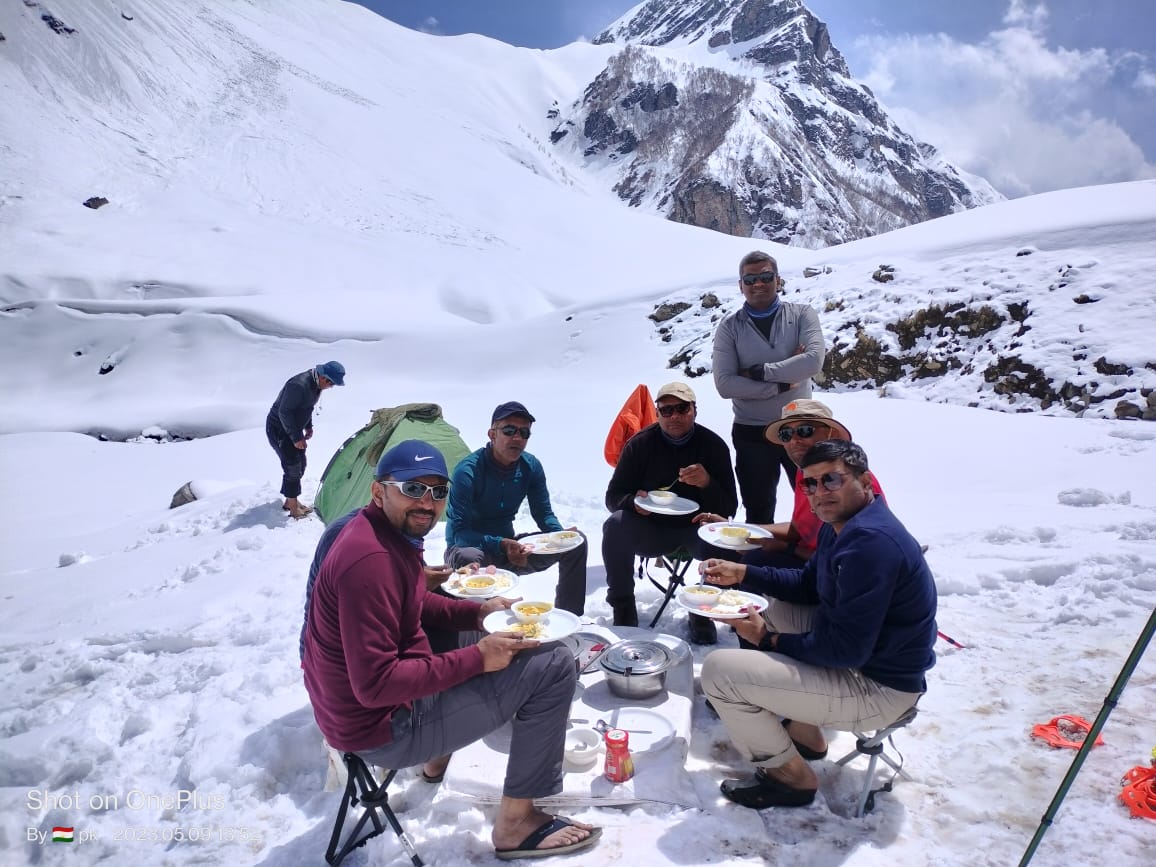
Beauty in Abundance in Sar Pass Trek
Sar Pass has got inherent beauty, peace and adventure, everything! Start from Kasol and trek through rich forest to reach Grahan village .
The views of Parvati valley are spell binding and will leave you speechless.
Trek through Biskeri Thach, a wide meadow and this trek will take you to the heavenly Sar Pass.
Some of the trek highlights
The base camp for this trek is Manali, which is located near the Parvatiriver’s banks in the Parvati valley. The trek to Sar officially begins in Kasol, a town well-known for its pretty coniferous forest and mountain streams. The trek trails through dense forests and progresses to a total snow-covered setting. The trail then further loops through pining forests, charming old-world villages, majestic snow-capped mountains, and some of the most breathtaking scenery.
Rhododendrons abound in the forest near the descent; trekkers can expect to be taken aback by the breathtaking scenery. The Nagaru campsite which is also the highest point during the entire trek is blessed with beautiful mountains across the Parvati valley. It arrives after the shepherds trail of Mung Thatch. During the trek, hikers pass through several small meadows, most of which are grazed by villagers with their livestock
Things to Look out for-
- The trek is certain to provide unrivalled feelings of accomplishment.
- Various villages with many opportunities to interact with the locals will keep you entertained throughout the journey.
- Explore the enthralling forest of rhododendrons.
- Various ascents and descents will encourage you to put your endurance to the test and eventually overcome them.
- The panoramic view of snow-covered trails and peaks from the top is well worth the effort trekkers will expend on their journey.
- Camping under the clear night sky filled with stars is an experience in and of itself
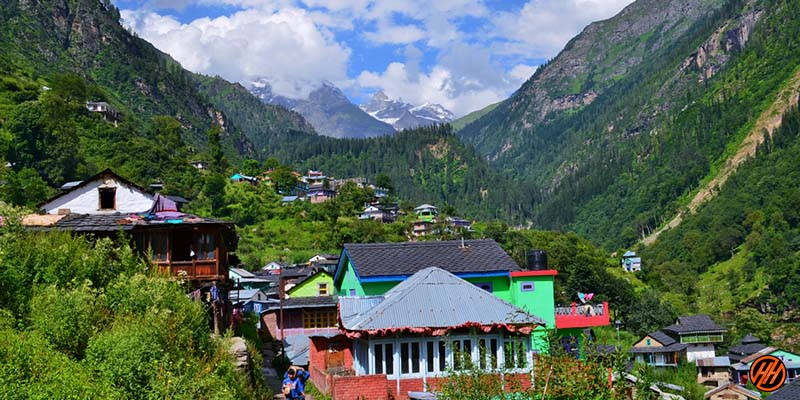
Before heading towards the itinerary, it is really essential to perceive the reason behind choosing the Sar Pass
Sar Pass trek is a high-altitude mountain trek Altitudes is 4200 Meters
The Starting trail is easy to moderate as compare to other treks this is an easy to moderate trek. So, this trek is for beginners, or family or school tour. First time can easily do this trek.
Need proper gear & clothing for sub-zero temperature?
You got to see so many heavenly bodies at one place like the panoramic view of the mountains of Parvati Valley, you can see pine forests, different variety of flora and fauna
I think Do spare time in Interaction with our local’s team, and you will get to know about some of the ancient tales of Indian mythology and our local cultures, this is good ideas for trekkers
Beautiful landscapes so carry proper photo gear & Extra battery backup.
The backpack should not exceed 12 kg only
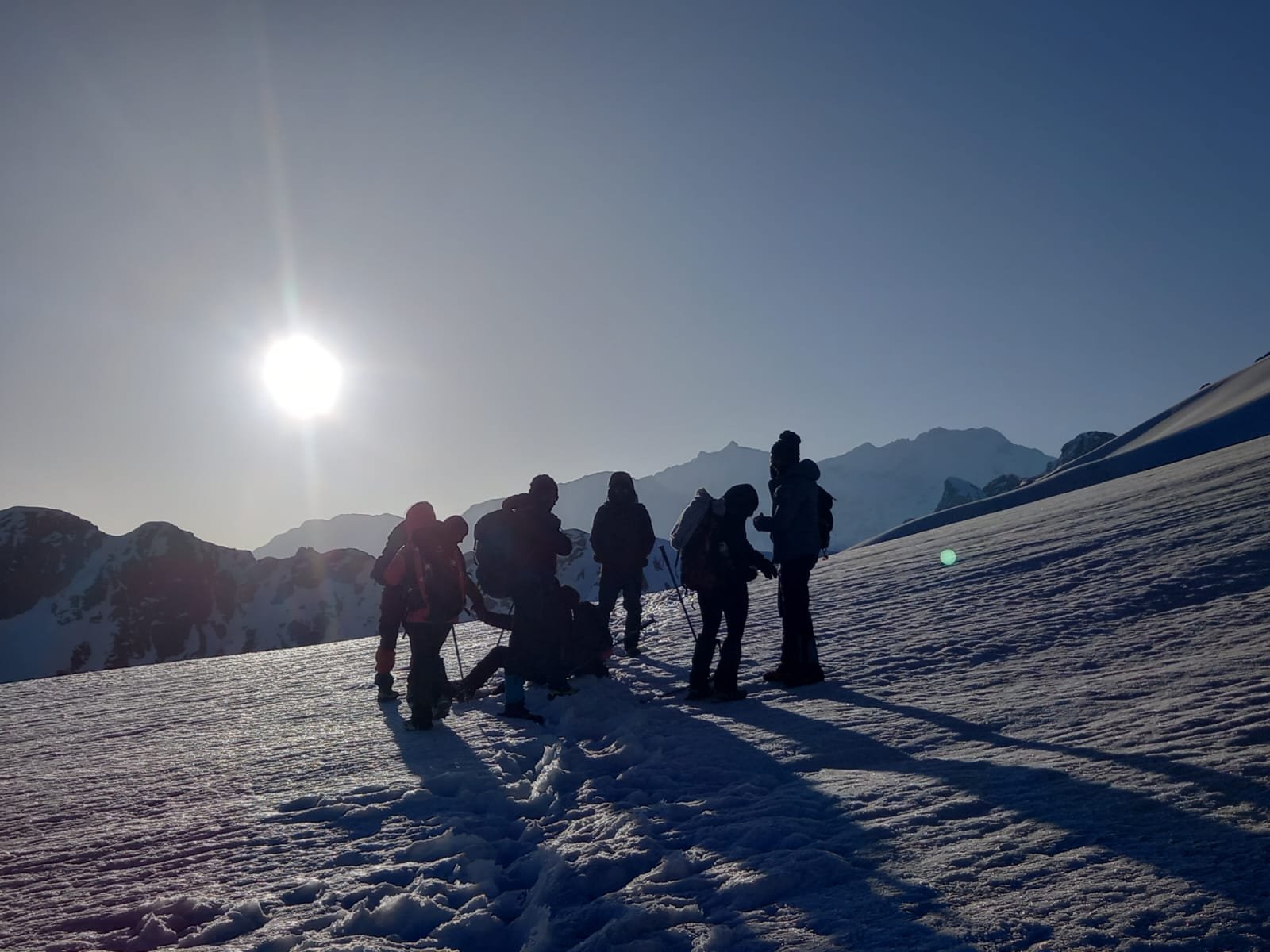
Key Points of Sar Pass Trek
Duration: – 4 Nights 05 days from Kasol to Kasol
Base camp: – Grahan base camp
Summer Temperature: – 13°C to 17°C and Night: 0°C to 7°C
Sar Pass Altitude – 4200 m
Best Time: – April, May, June, 2024
Trek Level: – Moderate
Trek distance: – On foot 37 km – By taxi km by Taxi
Group Size: – A maximum 25 people
The altitude covered in the Sar Pass trek
Grahan base Camp- 2350 m
Mini Thatch- 3400 m
Naguru-3800 m
Sar Pass- 4200 m
Biskeri Thatch- 3350 m
Barsheini- 2400 m
Short Itinerary of Sar Pass Trek
Day 1 : Pickup from Kasol Bus stand Same day Trek Kasol camp to Grahan village (07 km) (5/6 Hours) uphill (2350m)- overnight stay at Grahan village
Day 2 : Trek from Grahan to Mini Thach (07 km) ( 4/5 hours) (3400 m) overnight stay at Camp
Day 3 : Trek from Mini Thatch to Naguru (05 km) (4/5 hours) (3800 m) overnight stay at Camp
Day 4 : Trek from Naguru – Sar Pass- 13875 ft) to Biskeri Thatch (12 km) (6/8hours) (6 hours) (3350 m) overnight stay at Camp
Day 5 : Trek from Biskeri Thatch to Pulga (06 km) (4/5 hours) (2400 m) same day drive to Kasol 22 km by taxi
Best Time to Visit Sar Pass Trek
The best time to undertake the Sar Pass Trek is during the summer and post-monsoon seasons, which typically fall between May and October. Here’s a breakdown of the different seasons and their characteristics:
- Summer Season (May to June): This is the ideal time for the Sar Pass Trek, as the weather is pleasant with mild temperatures during the day and cool nights. The trails are usually clear of snow, allowing for a relatively easier trek. The meadows are in full bloom, offering vibrant landscapes and picturesque views.
- Monsoon Season (July to August): The monsoon season brings heavy rainfall to the region, making the trekking trails slippery and risky. It is not recommended to undertake the Sar Pass Trek during this time, as the chances of landslides and flash floods increase.
- Post-Monsoon Season (September to October): After the monsoon season, the weather starts to clear up, and the landscapes become lush green again. This period is considered the shoulder season for the Sar Pass Trek. The crowds are thinner compared to the summer season, and the weather remains favorable for trekking. However, towards October, temperatures start to drop, especially during the nights, so you should be prepared for colder conditions.
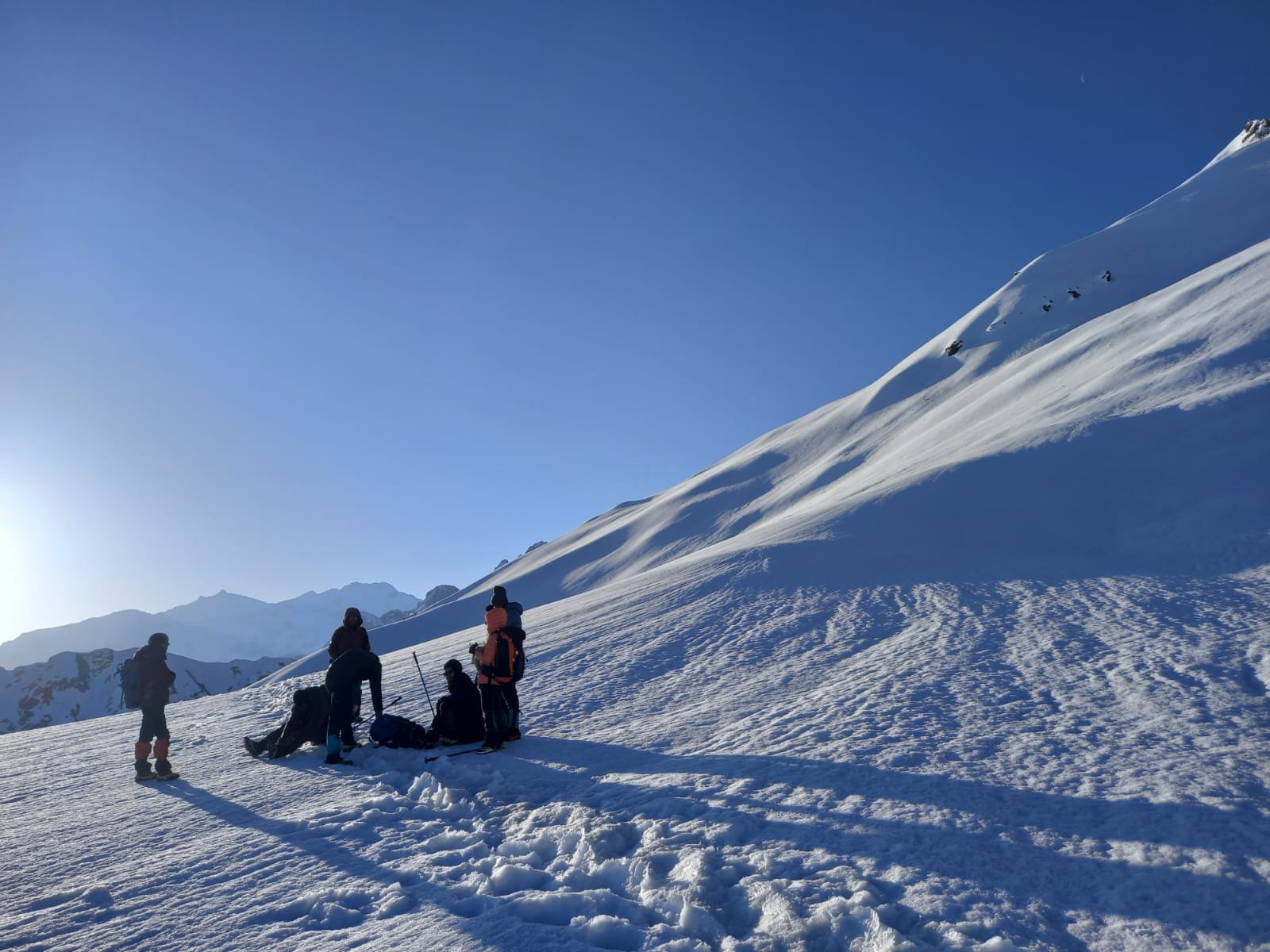
1) Detailed Itinerary
2)Is it safe
3)Difficulty level
4)Weather conditions
5)Things to carry
6)Connectivity and transaction
7)includes and excludes
8)How to reach
Is it safe Trek?
Set amidst the high altitude ranges, concerns regarding Sar Pass trek safety are indeed very valid questions. We have all the possible probabilities calculated if anything goes off the schedule.
At every stop point of the journey, trekkers will be going through a properly guided session informing them about the upcoming terrains. All our professionals strive their best to provide trekkers with the best experience possible.
Difficulty level
The Sar Pass Trek is considered a moderate trek, suitable for trekkers with some prior trekking experience. Here are some factors that contribute to its level of Moderate or difficulty:
- Altitude: The trek reaches an altitude of approximately 13,800 feet (4,200 meters) at Sar Pass. As you ascend to higher altitudes, the air becomes thinner, and the oxygen levels decrease. This can cause altitude-related challenges such as shortness of breath, fatigue, and altitude sickness. It is essential to acclimatize properly, stay hydrated, and listen to your body’s signals.
- Terrain: The trail consists of various terrains, including steep ascents, narrow ridges, rocky sections, and snow patches, especially in the early summer months. You will encounter steep climbs and descents, requiring good physical fitness, balance, and endurance. The terrain can be challenging and demanding at times, requiring careful footing and cautious navigation.
- Weather Conditions: Weather conditions in the mountains can be unpredictable, even during the best trekking seasons. You may encounter rain, snow, and cold temperatures, especially at higher altitudes. It is important to pack appropriate clothing and gear to withstand changing weather conditions.
- Duration and Distance: The Sar Pass Trek usually takes around 04 nights 05 Days days to complete, covering a distance of approximately 37 kilometers Each day involves trekking for several hours, covering varying distances and altitude gains. It requires a good level of stamina and endurance to sustain the trekking duration and distances.
- Camping and Facilities: The trek involves camping in tents at designated campsites along the route. Basic facilities like toilet tents and a limited water supply are available, but you should be prepared for rustic camping conditions.
Weather conditions
Weather conditions depend on the time of the year trekkers are traveling. Months from May to October experience moderate temperatures during the day with substantially colder nights
What to Pack for Sar pass trek clothes?
When packing for the Sar Pass Trek, it’s important to consider the varying weather conditions and the duration of the trek. Here’s a suggested list of clothing items you should pack:
- Moisture-wicking T-shirts: Lightweight and quick-drying shirts to keep you comfortable during the trek.
- Thermal tops: For colder days or nights at higher altitudes.
- Fleece jacket or lightweight down jacket: Provides warmth during chilly mornings and evenings.
- Insulated trousers: To keep your legs warm in colder temperatures.
- Waterproof and windproof jacket: Protects you from rain, snow, and chilly winds. Look for a jacket with a hood for added protection.
- Waterproof and windproof trousers: To keep your legs dry during wet or snowy conditions.
- Quick-drying and comfortable trekking pants or trousers. It’s recommended to carry at least two pairs.
- Sun hat or cap: Provides shade and protects from the sun’s rays.
- Beanie or warm hat: Keeps your head warm during colder days or at higher altitudes.
- Buff or neck gaiter: Versatile accessory that can be used as a neck warmer, face cover, or headband.
- Lightweight gloves: Protects your hands from cold temperatures and wind. Carry an extra pair in case one gets wet.
- Sturdy trekking boots: Waterproof and ankle-supporting boots with good traction.
- Comfortable trekking socks: Carry multiple pairs of moisture-wicking socks to keep your feet dry and blister-free.
- Rain cover for your backpack: Keeps your gear dry during rainy or snowy conditions.
- Sunglasses: Protects your eyes from harsh sunlight and glare from snow.
- Trekking poles: Provide stability and support, especially during steep ascents and descents.
- Thermal innerwear: Optional but helpful for colder temperatures.
Remember to pack lightweight and moisture-wicking clothing to ensure comfort during the trek. Layering is key to adjust to changing temperatures throughout the day. Additionally, carry a small backpack for daily essentials like water bottles, snacks, sunscreen, and a first aid kit.
It’s important to pack according to the season and weather conditions at the time of your trek. Consider checking with local trekking agencies or experienced trekkers for any specific recommendations based on the current conditions.
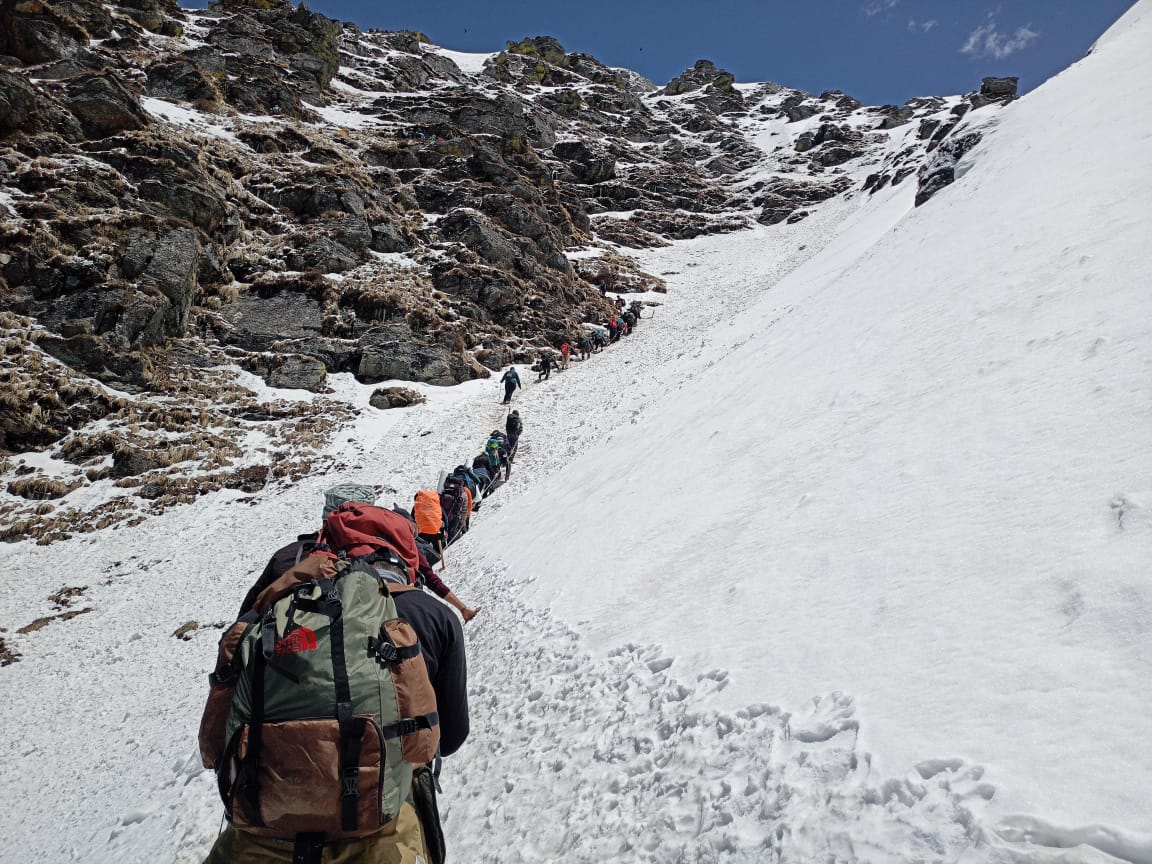
Other trekking Essentials-
Connectivity and Transactions
1) Because connectivity along the route is unpredictable, we urge people to do all of their work ahead of time.
2) Trekkers will be provided with walkie-talkies beforehand in case of emergency
3) Last ATM transactions available will be at Kasol but we recommend travelers to collect cash beforehand or while in Manali as ATM available at other places might not dispense cash at times.
How to Reach Kasol for Sar Pass Trek?
To reach Kasol, the base village for the Sar Pass Trek, you can follow these general directions:
By Air: The nearest airport to Kasol is Bhuntar Airport, located approximately 31 kilometers away. You can take a flight to Bhuntar Airport from major cities like Delhi or Chandigarh. From the airport, you can hire a taxi or take a local bus to Kasol.
By Train: The nearest major railway station to Kasol is Pathankot Railway Station, which is well-connected to major cities in India. From Pathankot, you can take a bus or hire a taxi to reach Kasol. Another option is to take a train to Chandigarh Railway Station and then continue your journey to Kasol by bus or taxi.
By Road: Kasol is well-connected by road and can be reached by bus or taxi from various cities. Here are a few common routes:
- From Delhi: You can take a bus from Delhi to Bhuntar, which is the nearest major town to Kasol. From Bhuntar, you can take a local bus or hire a taxi to reach Kasol, which is approximately 30 kilometers away.
- From Chandigarh: You can take a bus or hire a taxi from Chandigarh to Kasol. The distance between Chandigarh and Kasol is around 275 kilometers.
- From Manali: If you are coming from Manali, you can take a local bus or hire a taxi to Kasol. The distance between Manali and Kasol is approximately 80 kilometers.
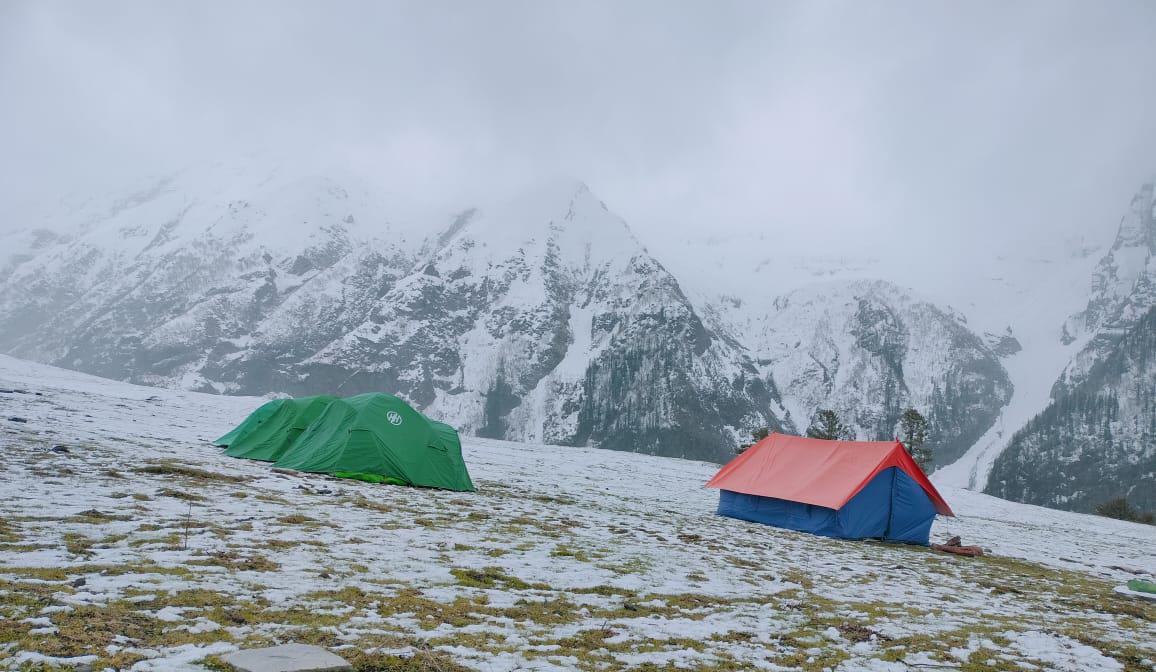
. Some important points to note-
- Please note that we don’t provide timings schedules for transportation before Manali. Subject to various conditions the scheduled timings and availability of particular rides may differ. We recommend trekkers to reach out our teams for any queries. You can drop an email or call us for an initial guided session.
- Our teams will be collecting trekkers at fixed points of airports, railway stations and bus stands.
- It is recommended that unless any delay arrives, trekkers are advised to reach the destinations at least 2 hours prior.
Things Himalayan Hikers recommend
As previously stated, a camera, as well as spare batteries and memory cards, are recommended. We can assure and guarantee that you will be stopping frequently along the trail to observe the grandeur of the trekking experience.
We strongly recommend trekkers to prepare beforehand for the journey ahead. Regular practicing physical fitness and mental endurance will surely assist trekkers in great times.
After the trek, we strongly encourage trekkers to tag us on social media when they post any memories from the trip; this will not only prove invaluable to us with our work but will also serve as a motivational example for all of our experts.
Why you should choose us
We’re here to give you the greatest experience possible through the eyes of highly skilled and qualified specialists who have a passion for adventure sports. We are community members attempting to promote our favorite adventure sports while also supporting local businesses. We, at Himalayan Hikers, dedicate ourselves to providing you with an unforgettable experience.
What do we do for safety in the Sar Pass trek?
First of all, the safety of trekkers is much more for us, if you see in the trek, then there are all the risks, which I do not think about.
Himalayan Hikers worry more about you that no one should ever have any problem in the trek.
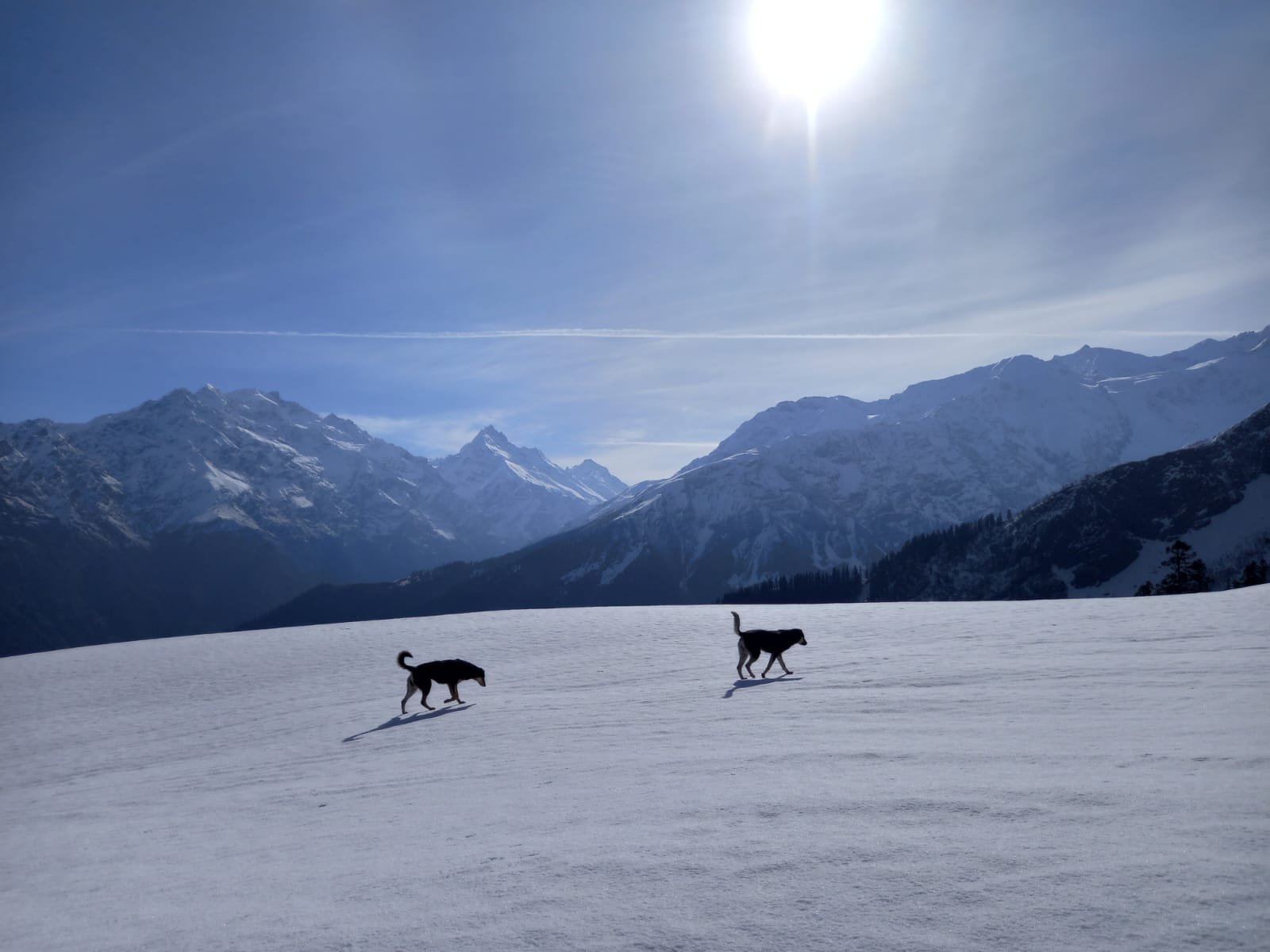
What should we and you keep more safety in the trek
- Whenever you are going for any trek, it is very important that you go completely fit and ready.
- Sar Pass trek is Moderate, if you make your feet and your mind calm and strong, you will find the trek very easy.
- While trekking, keep in mind that you are walking on the right route or not always with your guide.
- Most people look somewhere and where they are walking, this can cause twitching in your legs, which can ruin your entire trek.
- It is important to ask your doctor if you have any medical problems
- I should always keep my medical kit with me, it is very important.
- Himalayan Hikers always keep a medical kit with you, such as oxygen cylinders, medicine to be given in emergency on the trek
- If any trekkers have any more problems, then they are brought back to the base camp by laying them in the stretcher.
- Our Sar pass trek camp is around 6000 ft to 11,000 feet where you can not have any problem of oxygen, this is tree line area
- In case of any medical problem, the help of your guide or well-informed trekkers should be taken
- If there is major health problems in this trek , then Nearest Hospital is in Manali/Bhunter which is about 67 Kms away from Sar pass trek
- Our camps also move forward day by day and our bodies also work with the altitudes that are safe for trekkers
- Along with the trek we keep getting acclimatization
- Himalayan Hikers always take care of their trekkers anyway it is one of our local trek where we live every day
How to get fit for Sar Pass Trek in Himachal Kasol?
Here are some tips to help you get fit for the trek:
- Cardiovascular Fitness: Trekking involves long hours of walking and endurance. Engage in activities that improve your cardiovascular fitness, such as jogging, cycling, swimming, or brisk walking. Start with shorter distances or durations and gradually increase the intensity and duration of your workouts over time.
- Leg Strength and Endurance: Trekking requires strong leg muscles to tackle uphill and downhill sections. Incorporate exercises like squats, lunges, step-ups, and calf raises into your fitness routine. Include both strength training and endurance-building exercises for your legs.
- Core Strength: A strong core is essential for maintaining balance and stability during the trek. Include exercises like planks, Russian twists, mountain climbers, and sit-ups to strengthen your core muscles.
- Stair Climbing: Find a nearby staircase or use a stair-climbing machine at the gym to simulate the uphill and downhill sections of the trek. Regular stair climbing workouts will help build strength and endurance in your legs.
- Backpack Training: As you will be carrying a backpack during the trek, gradually increase the weight of your backpack during your training sessions. Start with a lighter load and gradually add weight to simulate the weight you’ll carry during the trek.
- Flexibility and Stretching: Engage in regular stretching exercises to improve flexibility and prevent muscle stiffness. Focus on stretching your leg muscles, lower back, shoulders, and neck.
- Mental Preparation: Trekking requires mental resilience and determination. Prepare yourself mentally by setting realistic goals, visualizing the trek, and staying positive. Practice mindfulness and relaxation techniques to manage stress and keep a calm mindset during challenging moments.
- Hydration and Nutrition: Stay hydrated throughout your training period and during the trek. Maintain a balanced diet rich in carbohydrates, proteins, and essential nutrients to fuel your body and aid in recovery.
Day 1: Reach Our Base Camp Kasol 8:30 am to 9:00 am Then trek to Grahan Village
- Starting Point: Kasol Bus Stand Base Camp of H.H
- Destination: Grahan Village
- Distance: Approximately 07 kilometers
- Time Required: Around 4-6 hours, depending on your pace and breaks
- Difficulty Level: Moderate
Trek Details:
- Kasol is well-connected by road, and you can easily reach there by bus or taxi from nearby towns like Bhuntar or Manali. Once you arrive at Kasol Bus Stand, you can start your trek.
- The trail starts from Kasol and leads towards Grahan Village. You’ll need to cross the Parvati River and then start ascending through dense forests.
- The initial part of the trek involves a gradual ascent through the forest, with occasional steep sections.
- The trail is well-marked, but it’s recommended to have a local guide or a map with you.
- As you ascend, you’ll pass through lush greenery, pine forests, and possibly encounter some streams.
- After a few hours of trekking, you’ll reach the beautiful Grahan Village, situated at an altitude of around 7,700 feet above sea level.
- Grahan Village is a quaint Himalayan hamlet, offering stunning views of the surrounding peaks and valleys.
- The trek from Kasol to Grahan Village is considered moderate in difficulty.
- While the trail is well-defined, there are some steep sections, especially during the ascent.
- Proper trekking gear, including sturdy hiking shoes, water, snacks, and a rain jacket (depending on the weather), is recommended.
- It’s also essential to pace yourself and take regular breaks, especially if you’re not used to hiking at higher altitudes.
- Start your trek early in the morning to make the most of daylight hours and avoid trekking in the dark.
- Carry an adequate amount of water and snacks to keep yourself hydrated and energized throughout the trek.
- Respect the local culture and environment. Avoid littering and follow the principles of Leave No Trace.
- Check the weather forecast before starting your trek and be prepared for changes in weather conditions.
Day 2 : Trek from Grahan to Mini Thatch
- Starting Point: Grahan Village
- Destination: Mini Thatch
- Distance: Approximately 7-8 kilometers
- Time Required: Around 4-5 hours, depending on your pace and breaks
- From Grahan Village, head towards the trail leading to Mini Thatch. You’ll find signposts or locals who can guide you in the right direction.
- The trail initially ascends through dense forests, similar to the previous segment from Kasol to Grahan.
- You’ll pass through scenic landscapes, lush greenery, and possibly encounter some streams along the way.
- The trek involves a significant ascent as you make your way towards Mini Thatch.
- The trail may become steeper and more challenging compared to the previous segment. Be prepared for some strenuous sections.
- As you climb higher, you’ll be rewarded with breathtaking views of the surrounding valleys and snow-capped peaks.
- Mini Thatch is a beautiful meadow nestled amidst the mountains, offering a tranquil setting for camping or resting.
- The trek from Grahan to Mini Thatch is considered moderate to difficult, primarily due to the steep ascent.
- You’ll need to have a good level of fitness and stamina to tackle the uphill sections.
- Proper trekking gear, including sturdy hiking shoes, trekking poles (if required), water, snacks, and warm clothing, is essential.
- Take regular breaks to catch your breath and enjoy the scenery along the way.
- Start early in the morning to make the most of daylight hours and avoid trekking in the dark.
- Carry sufficient water and snacks to keep yourself hydrated and energized during the trek.
- Be mindful of your surroundings and follow the trail markers or ask locals for directions if needed.
- Take precautions against altitude sickness, especially if you’re ascending to higher elevations.
- Respect the local environment and leave no trace of your visit.
Trekking from Grahan Village to Mini Thatch offers a challenging yet rewarding experience amidst the natural beauty of the Himalayas. Enjoy the journey and embrace the serenity of the mountai
Day 3 : Trek from Mini Thatch to Naguru
Trekking from Mini Thatch to Nagaru is a segment that takes you further into the scenic landscapes of the Parvati Valley, eventually leading you to the base camp for the Sar Pass trek. Here’s a guide for this part of your journey:
- Starting Point: Mini Thatch
- Destination: Nagaru
- Distance: Approximately 5-6 kilometers
- Time Required: Around 3-4 hours, depending on your pace and breaks
- Difficulty Level: Moderate to Difficult
- Depart from Mini Thatch and follow the trail towards Nagaru. The route may be marked with signs or cairns, but it’s advisable to have a local guide or a map to navigate effectively.
- The initial part of the trek involves ascending further through alpine meadows and possibly rocky terrain.
- You’ll continue to enjoy panoramic views of the surrounding mountains and valleys as you gain altitude.
- The trail gradually becomes steeper as you ascend towards Nagaru.
- You may encounter some challenging sections with rocky paths and uneven terrain.
- It’s essential to pace yourself and take regular breaks, especially considering the altitude gain.
- Keep an eye out for any trail markers or signs to ensure you’re on the right path.
- Along the way, you’ll be treated to stunning views of the Parvati Valley below and the towering peaks surrounding you.
- Nagaru itself is situated at a higher altitude, offering breathtaking vistas of the Himalayan landscape.
- The trek from Mini Thatch to Nagaru is considered moderate to difficult, primarily due to the steep ascent and potentially challenging terrain.
- Altitude gain can also be a factor, so it’s essential to acclimatize properly and be prepared for the effects of high altitude.
- Ensure you have the necessary trekking gear, including sturdy hiking shoes, warm clothing, water, snacks, and a first aid kit.
- Start early in the day to make the most of daylight hours and avoid trekking in the dark, especially considering the terrain’s difficulty.
- Stay hydrated and fuel yourself with snacks to maintain energy levels throughout the trek.
- Keep an eye on weather conditions, as they can change rapidly in mountainous regions.
- Follow Leave No Trace principles and respect the environment and local communities.
Day 4 : Trek from Naguru to SAR Pass to Biskeri Thatch
Trekking from Nagaru to Sar Pass and then descending to Biskeri Thatch is one of the most exhilarating segments of the Sar Pass trek, offering breathtaking views and a sense of accomplishment as you traverse high-altitude landscapes. Here’s a guide for this challenging yet rewarding trek:
- Starting Point: Nagaru
- Destination: Biskeri Thatch via Sar Pass
- Distance: Approximately 12-13 kilometers
- Time Required: Around 8-10 hours, depending on your pace and breaks
- Difficulty Level: Difficult
- Begin your trek from Nagaru, situated at a considerable altitude. Ensure you’re properly acclimatized before embarking on this challenging segment.
- The initial part of the trek involves ascending towards Sar Pass. The trail is likely to be steep and rocky, requiring careful footing and endurance.
- As you ascend towards Sar Pass, the trail may become progressively steeper and more challenging.
- You’ll navigate through rugged terrain, possibly encountering snowfields or icy patches, depending on the season.
- Keep an eye out for trail markers or follow the guidance of your guide to stay on track.
- Sar Pass, situated at an elevation of around 13,800 feet, offers breathtaking views of the surrounding peaks and valleys, making the ascent worth the effort.
- Once you reach Sar Pass, take some time to rest and soak in the stunning vistas before beginning your descent towards Biskeri Thatch.
- The descent from Sar Pass to Biskeri Thatch can be equally challenging, with steep gradients and potentially slippery terrain. Use trekking poles for stability if necessary.
- The trail from Sar Pass descends through alpine meadows and forests, providing a contrast to the rugged terrain of the ascent.
- While the descent may be less physically demanding than the ascent, it requires caution to navigate safely, especially on uneven terrain.
- Biskeri Thatch, nestled amidst the mountains, offers a serene camping spot to rest and rejuvenate after the day’s trek.
- The trek from Nagaru to Sar Pass and then to Biskeri Thatch is considered difficult, primarily due to the steep ascent, high altitude, and potentially challenging terrain.
- Proper acclimatization, physical fitness, and trekking experience are essential prerequisites for this segment.
- Ensure you have the necessary equipment, including sturdy hiking shoes, warm clothing, trekking poles, water, snacks, and a first aid kit.
- Start early in the day to allow ample time for the trek and to avoid trekking in low visibility conditions, especially during the descent.
- Stay hydrated and nourished throughout the trek to maintain energy levels.
- Keep a close watch on weather conditions and be prepared for changes in mountain weather.
- Follow Leave No Trace principles and respect the environment and local culture during your trek.
Day 5: Trek from Biskeri Thatch to Pulga road
Trekking from Biskeri Thatch to Pulga Road offers a scenic route through the picturesque landscapes of the Parvati Valley. Here’s a guide for this segment of your trek:
- Starting Point: Biskeri Thatch
- Destination: Pulga Road
- Distance: Approximately 10 kilometers
- Time Required: Around 5/6 hours, depending on your pace and breaks
- Begin your trek from Biskeri Thatch, situated amidst the mountains and alpine meadows.
- The trail initially descends from Biskeri Thatch, gradually leading you towards lower elevations.
- As you descend, you’ll be treated to breathtaking views of the surrounding valleys, lush forests, and distant peaks.
- The trail winds its way through forests, meadows, and possibly small streams, offering a varied and picturesque landscape.
- Along the route, you may pass through or encounter several small villages inhabited by the locals.
- These villages provide a glimpse into the local way of life and may offer opportunities to interact with the residents.
- While the trail is generally well-defined, it’s advisable to have a map or GPS device to ensure you’re on the right path.
- Signposts or markers may guide you along the way, but it’s always helpful to ask locals for directions if needed.
- The trek from Biskeri Thatch to Pulga Road is considered moderate in difficulty.
- While the overall terrain may involve some descents and ascents, it’s generally less challenging compared to higher altitude treks.
- However, be prepared for uneven terrain, rocky sections, and possibly some steep gradients, particularly as you descend towards Pulga Road.
- Start your trek early in the day to make the most of daylight hours and avoid trekking in the dark.
- Carry sufficient water, snacks, and any necessary supplies for the trek.
- Wear sturdy hiking shoes and comfortable clothing suitable for trekking.
- Respect the environment and local communities along the way, and adhere to Leave No Trace principles.
- Check the weather forecast before setting out and be prepared for changes in weather conditions.
- The route from Pulga to Kasol involves driving back along the road you trekked on or taking any alternate routes available. The primary road network connects these two destinations.
- The distance between Pulga and Kasol by road is approximately 15-20 kilometers, depending on the specific route you take.
- The road conditions can vary, but in general, the roads in this region are narrow and winding, often with steep inclines and declines.
- Some sections of the road may be rough or unpaved, especially in more remote areas.
- The driving time from Pulga to Kasol typically ranges from 30 minutes to an hour, depending on traffic, road conditions, and the specific route taken.
- The drive from Pulga to Kasol offers stunning views of the surrounding mountains, valleys, and forests. Be sure to take some breaks along the way to admire the scenery and take photographs.
Mandatory Documents
Please carry the documents given below.
Original and photocopy of government photo identity card- (Aadhar Card, Driving License, Voters ID, etc, Passport and Visa important to foreigners Medical Certificate (First part should be filled by the Doctor and Second part by the Trekker) Declaration Certificates
Note: – Many trekkers commit the same mistake of carrying unnecessary items on a trek which only makes the backpack heavy. It is important to know the right items to carry. It differs from season to season if you are trekking in summers then carry less layers of warm clothing and if you are trekking in winters carry enough layers to protect yourself against chilly cold.
Necessary Items for trekkers

Backpack (50 to 60 liters) A strongly built backpack with good support is compulsory for a trek. (Rain cover is important)
Sturdy Trekking Shoes The shoes should be strong enough with good support. The people ask if sports shoes would be comfortable but it is good to bring the right trekking shoes.
The Clothes You Should Bring On a Trek Avoid keeping extra clothes because it only makes you backpack heavy.
Trek Pants – The jeans are never suitable for a trek so you need at least 2-3 trek pants for treks carry more for longer treks.
Jacket – Jackets are very important to carry on a trek it protects you against the chilly weather. So carry 2 jackets on a week long trek.
Layers of warm Clothing Carry warm woolen layers or fleece. Carry more layers during winter season (at least 2 to 3) and less during summer.
Thermals – The Temperature decreases at night so you might be need thermals for Night.
T- Shirts – Bring those t shirts which dry fast.
Poncho –They are needed if you are trekking on a Rainy day to keep you dry.
Hiking Pole
Water Bottle 2
Cap or Balaclava
Woolen and Waterproof Gloves
Socks (Woolen and Regular)
Torch head light
Personal Toiletry Items – (toothpaste, toothbrush, toilet paper, sanitizer etc.)
Carry Personal Medical Kit
Personal Medical Kit (Carry minimum 5 tablets and maximum 10)
Medicine for Altitude Sickness
Medicine for acidity and discomfort.
Fever and Headache Medicines
Pain Reliever
Motion Sickness Medicine
Medicine for Allergies
Medicine for Diarrhoea
Sprains Cream or Spray
Antiseptic Cream
Stretchable/Elastic bandage
Note:- Please take all medicines only when prescribed by the doctor. In case you face any problem during your trek, discuss and take advice from the Professional guide.
It is important to have some guidelines in place in case something unexpected happens. Here are some general guidelines that may be helpful:
- Have a first-aid kit: Make sure to carry a well-equipped first-aid kit that can be used to treat minor injuries and ailments.
- Follow safety protocols: It is important to follow all safety protocols and guidelines related to the trek. This includes staying on designated trails, avoiding risky or dangerous areas, and staying with your group.
- Have a communication plan: Make sure to have a communication plan in place in case of emergencies. This may include carrying a mobile phone or a satellite phone, or using a walkie-talkie to stay in touch with other members of your group.
- Know the local emergency services: Be aware of the local emergency services available in the area where you will be trekking. This includes knowing the location of the nearest hospital, police station, or rescue service.
- Carry proper gear and equipment: Make sure to carry appropriate gear and equipment for the trek, including proper footwear, warm clothing, and rain gear. This will help you stay comfortable and safe during the trek.
- Follow Leave No Trace principles: Follow Leave No Trace principles and leave the trekking area as you found it. This includes packing out all trash and waste, avoiding damaging vegetation, and respecting wildlife.
- Stay calm and collected: In case something unexpected happens, try to stay calm and collected. Assess the situation and take appropriate action to stay safe and help others in your group.
It’s also a good idea to consult with a local trekking agency or experienced guide before embarking on a trek, as they can provide additional guidance and support to ensure a safe and enjoyable experience.
Are you Looking for Trekking Equipment on Rent?
If any trekker needs trekking equipment on Rent then Himalayan Hikers has the best trekking equipment available on rent.
There are many people behind this who are in great need of it, it is better to hire it at affordable price without spending much money for just a few days.
Rent Costs per Day
1. Hiking shoes Per day Rs. 100/-
2. Hiking Pant Per Day Rs. 100/-
3. Down Jacket Per Day Rs. 100/-
4. Hiking Pole Per Day Rs. 50/-
5. Headlight Per Day Rs. 50/-
6. Trekking Bag 50 to 60 litter Per Day Rs. 50/-
7. Gloves Per Day Rs. 50/-
Trek Equipment You can book directly at the Base Camp of your trek.
April -2024
10 April to 14 April 2024 (Open)
13 April to 17 April 2024 (Open)
14 April to 18 April 2024 (Open) 11 left
15 April to 19 April 2024 (Open)
16 April to 20 April 2024 (Open) 8 left
17 April to 21 April 2024 (Open)
18 April to 22 April 2024 (Open)
19 April to 23 April 2024 (Open)
20 April to 24 April 2024 (Open)
21 April to 23 April 2024 (Open)
22 April to 26 April 2024 (Open)
23 April to 27 April 2024 (Open)
24 April to 28 April 2024 (Open)
25 April to 29 April 2024 (Open)
26 April to 30 April 2024 (Open)
27 April to 01 May 2024 (Open)
28 April to 02 May 2024 (Open)
29 April to 03 May 2024 (Open)
30 April to 04 May 2024 (Open)
01 May to 05 May 2024 (Open)
02 May to 06 May 2024 (Open)
03 May to 07 May 2024 (Open)
04 May to 08 May 2024 (Open)
05 May to 09 May 2024 (Open)
06 May to 10 May 2024 (Open)
07 May to 11 May 2024 (Open)
08 May to 12 May 2024 (Open)
09 May to 13 May 2024 (Open)
10 May to 14 May 2024 (Open)
11 May to 15 May 2024 (Open)
12 May to 16 May 2024 (Open)
13 May to 17 May 2024 (Open)
14 May to 18 May 2024 (Open)
15 May to 19 May 2024 (Open)
16 May to 20 May 2024 (Open)
17 May to 21 May 2024 (Open)
18 May to 22 May 2024 (Open)
19 May to 23 May 2024 (Open)
20 May to 24 May 2024 (Open)
21 May to 25 May 2024 (Open)
22 May to 26 May 2024 (Open)
23 May to 27 May 2024 (Open)
24 May to 28 May 2024 (Open)
25 May to 29 May 2024 (Open)
26 May to 30 May 2024 (Open)
27 May to 31 May 2024 (Open)
28 May to 01 June 2024 (Open)
29 May to 02 June 2024 (Open)
30 May to 03 June 2024 (Open)
31 May to 04 June 2024 (Open)
01 June to 05 June 2024 (Open)
02 June to 06 June 2024 (Open)
03 June to 07 June 2024 (Open)
04 June to 08 June 2024 (Open)
05 June to 09 June 2024 (Open)
06 June to 10 June 2024 (Open)
07 June to 11 June 2024 (Open)
08 June to 12 June 2024 (Open)
09 June to 13 June 2024 (Open)
10 June to 14 June 2024 (Open)
What is Included In This Trek?
Transport Facility Kasol To Kasol
Forest Permit and entrance fee
Accommodation in tents on twin/three share basis
All meals: breakfast, packed lunch, tea, coffee, snacks, soup, and dinner
High-quality Dome tents
Sleeping bags
Separate Toilet tents – Ladies and Gents
Dining Tent
Dining Table
Kitchen team
Radio Walkie-Talkie for Communication
Good Experience Trek Leader guide and Technical guide
Medical Kit
Oxygen Cylinders
Crampons and Gaiters
What is Not Include In This Trek?
Personal Insurance
Medical Certificate
Personal toiletry Items and Personal Medicine kit
On the first day, En Route to base camp Breakfast was Not Included
Last Day En Route Lunch and Dinner are not Included
Porter – if you need porters for your uploading bag – The cost per bag per day is Rs. 800.00 paid to directly our manager at Kasol
There are no reviews yet.
Your email address will not be published. Required fields are marked *
Name *
Email *
Save my name, email, and website in this browser for the next time I comment.
Related Tours
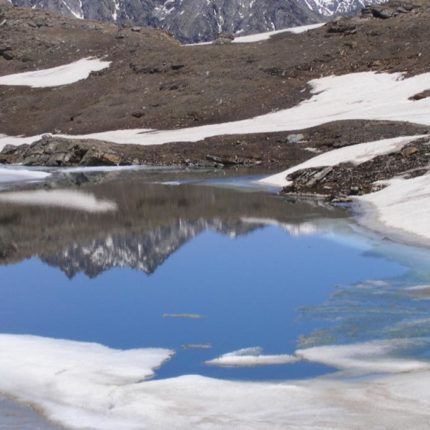
Kanasar Lake Trek
Remote area of Western Garhwal amid Supin and Nalgan valley
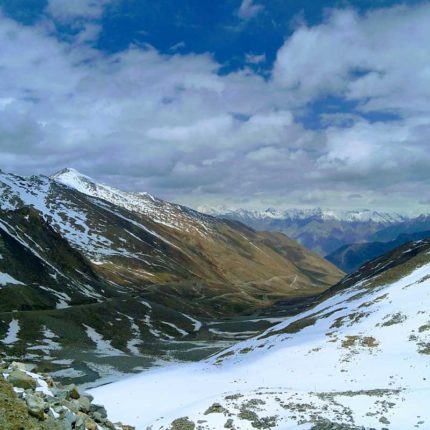
Yunam peak Expedition
Yunam Peak Expedition in Lahaul district of Himachal At an altitude of 6111m.
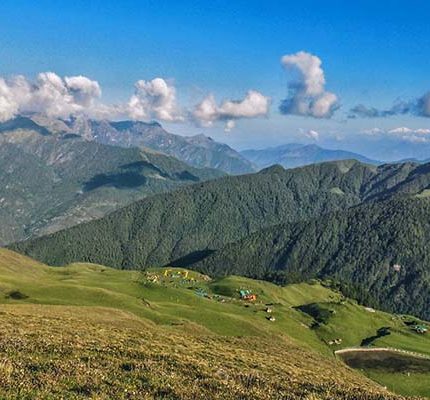
Bedni Bugyal Trek
Bedni Bugyal is a high altitude meadow in Garhwal Himalayas
Price: ₹ 6,500.00
Book the tour
Book your trek.
- Overview Itinerary Dates Include/Exclude
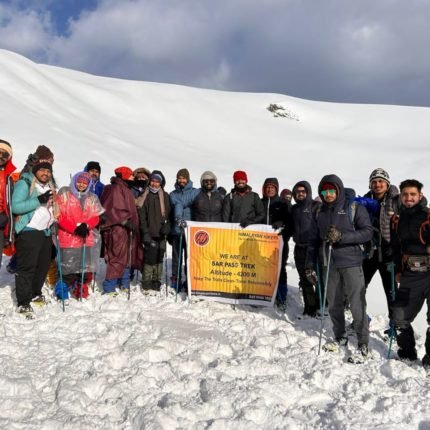
Choose Trek
Customise Trek
Suggest me a trek
Rent a gear
Volunteer Program
Blogs & Articles
Discounts & Offers

Sar Pass Trek
Max Altitude
Trekking KM.
11,300 /Person
- +5% GST (Goods and Services Tax)
- Grahan village to Barshaini
- Rs 175 Insurance (Mandatory) | Rs 1,500 Transportation (Optional) Meeting place : Back in Adventure Base Camp
Help & Support
- +91 9368882322
- 10:00 hrs to 18:00 hrs Monday - Saturday GMT +5:30 Sunday Closed
- [email protected]
- Cost & Cancellation Terms
- Risk & Respond
How To Reach
Trek essential.
- Important Links
Fixed Departure
- Trail Type A cross over trail through passes. The trek starts and ends at Manali
- Rail Head Pathankot is the nearest rail head to the base camp
- Airport Bhuntar, which is 52 km away from Manali
- Base Camp Kasol
- Summer Treks (Mid Apr - Jun)
- Autumn Treks (Sep - Mid Nov)
- Snow More snow in winters
- Services from Grahan Village to Barshaini
- Meals Meals while on trek & at Hotel/Guesthouse (Veg & Eggs)
- Stay Camping (Twin sharing) & Home Stay
- Region - Himachal Pradesh
- Duration - 5 Days
- Grade - Moderate
- Max Altitude - 13800 Ft.
- Approx Trekking Km - 50 Kms.
Why Sar Pass A Must-Do Trek?
Sar Pass is a beautiful Himalayan Trek situated in the state of Himachal Pradesh and starts from the lovely village of Kasol. This trek allows you to witness part of the Himalayas, which is covered in lush green and pristine white. The trek begins with a beautiful start from Kasol, which is a picturesque village situated at an altitude of 5,184 ft in Parvati Valley.
The trek takes you through the lush green forests of Pine, Deodar, and Rhododendrons, you will also pass through Grahan, which is another beautiful village in the Parvati Valley, and from here you can gaze at a beautiful night sky full of a million stars. Camping under a sky full of stars is a life-altering experience.
An interesting thing about this trek is that it starts with lush green vegetation and later is completely whitewashed as you move toward the pass. You will cross different terrains like grasslands, woodlands, and snow patches in this short yet beautiful trek. The simple grade of the trek makes it suitable for beginners and anyone who wish to experience a Himalayan trek. All in all Sar Pass is a wonderful adventure that is a must-do for everyone.
About The Trek?
Sar Pass is situated at an altitude of 13,799 ft and the trek is an easy to moderate grade trek. This 48 km trek passes through Himachal Pradesh starting from Kasol and ending at Barshaini crossing through pine forests, meadows, snow-capped mountains, and various captivating landscapes.
The trek starts from the small settlement of Kasol in Parvati Valley where you will trek to Grahan Village. Both villages are the two most beautiful villages in Himachal Pradesh. From Grahan, we will move on to Min Thach a meadow patch followed by a trek to Nagaru, and then the next day you will trek to another grassland Biskeri Thach.
From Nagaru, we head to Sar Pass , where the landscape is completely whitewashed, and then to Biskeri Thach. On day 5, we will trek from Biskeri Thach to Barshaini and then drive back to Kasol.
What Can You Expect At The Trek?
Since Sar Pass is an easy-grade trek, it is suitable for all levels of trekkers and families as well. On average, you will walk about 7 km to 9 km daily with an average duration of 7 hrs. The temperature at Sar Pass Trek can be as high as 22°C and can fall to -5°C during the nighttime. The changes in temperature at a high altitude can affect your body, so dress in appropriate layers of clothing and follow your trek leader’s instructions to make the most of the journey.
The best time to do Sar Pass Trek is from May to October as the skies are usually clear and you will get to see the amazing panoramic views. During the trek, you can enjoy the hospitality and the friendliness of the people in the Himalayan villages and get a peek into their everyday lifestyle. You will also spot the rich biodiversity of the place. Because of the altitude variations of the place you can spot many diverse plant species. You can see different varieties of Pine, Deodar, Spruce, Fir, and medicinal plants like Brahma Kamal and Hatha Panja. You may also be able to spot wildlife species like Himalayan Tahr, Brown Bears, and bird species like Monal pheasant and Western Tragopan.
This trek is best for those who love adventure and want to see varied mountain landscapes and high snowy mountains. This trek is sure to give an adrenaline rush and thrilling experience!
Who can participate
- Age; 10 years.
- First timer can apply; previous trekking experience is more appreciated.
- The climber must be fit and have sufficient stamina to cover 4 km of distance in 30 minutes without a stress.
- The climber should be able to carry a 10-15 kg backpack.
Health Awareness
- Pulse rate at rest must be in between (60 to 90 beats per minute)
- Blood Pressure Reading must be in between (DIASTOLIC 75 – 85, SYSTOLIC 100 - 130 mm Hg)
- Respiratory rate at rest must be in between (12 to 20 breaths per minute)
- Should not have Liver and kidney issues
- Should not have Diabetes Mellitus, Bronchial Asthma, Epilepsy, Heart problems, Hypertension etc
- No pacemaker implant
- People with the Sinus issues please contact to trek coordinator before booking the trek
- If your BMI is not normal, Please contact our Trek coordinator before Trek booking.
Government Employees {SCL}
Government Employees can avail the benefit of Special Casual Leave (SCL) when you join us for a trekking expedition. As per the rules of the Pay Commission, Special Casual Leave can be availed for up to 30 days in a calendar year for trekking/mountaineering expeditions through a registered organization. Trek The Himalayas is a registered adventure tour operator by Indian Mountaineering Foundation (IMF) and Ministry Of Tourism (MOT) Trekkers have to apply for leave at least 20 days before trek departure date.
- Junior trekkers (below 15 years) should have a company of parent/guardian.
- Trekkers between 15 to 18 years can come solo with the disclaimer form signed by parent/guardian.
- Medical & Disclaimer Form (Mandatory Documents) Click here
- Altitude: Kasol - 1,700 m. Grahan - 2,350 m
- Altitude Gain: 650 m
- Distance: 10 km | Duration: 4 to 5 hrs
- Transportation Amount is not included in the trek cost.
- Meet with a Trek Leader and the team at 11:00 am at Kasol.
- Meeting Point: Back in Adventure Base Camp in Kasol. Address : Near Narayan temple, Kasol, Himachal Pradesh 175105.
- 11:00 am to 12:30 pm documentation and trek briefing and 12:30 pm to 1:30 pm Lunch
- 1:30 pm Start trek, reach the campsite by 4:00 pm
- Drive 8 km from Kasol to Grahan Stop.
- Trek a 2 km steep ascent from Grahan Stop to Grahan Village.
- Dense forest of Rhododendron and Pine tree
- Two water sources are available on the way
- Grahan village is full of apple orchards and surrounded by pine trees
- Stay in Tent
- It is highly recommended to come a day in advance
The trek starts from the beautiful mountain village Kasol in Himachal Pradesh, which is known for its lovely evergreen forests and creeks. It is a picturesque village set beside the gushing Parvati River and the trail takes you to Grahan village, which is another scenic village approximately 10 km from the village of Kasol. Our trek leader and the team will meet you at Kasol and after a round of brief introductions with teammates and some instructions the trek will start.
The trek gradient is very gradual, so it is effortless on your legs and knees and you can effortlessly make the trek today. You will begin with an 8 km drive from Kasol to Grahan Stop, traversing a complete off-road path. This journey typically takes between 45 minutes to 1 hour to reach Grahan Stop. From there, our trek will commence, covering a 2 km steep ascent from Grahan Stop to the Grahan campsite. The initial part of the trail passes through dense coniferous forests and the aroma of the pine trees will invade your senses as you walk through the forest.
After walking through the forested patch for some time, the forests will eventually give way to grasslands and you can see some local vendors with their tea stalls. These stalls also sell Rhododendron syrup, which is mixed with water to make a very refreshing drink. Grahan village is not very far. From here, it is about a steep climb of one hour before you enter the picturesque village setting.
Grahan is situated at the top of a hill and we will camp here for the night. Mobile coverage is sometimes available in Grahan but it is very erratic. The campsite is surrounded by Rhododendron trees making it look even more beautiful. After having a delicious lunch at the campsite, you can go about exploring the quaint village and its surroundings. The pleasantness of the scenery with the beautiful mountain views will captivate you. After a delectable dinner, you will retire to your tents ending the first day of trekking.
- Altitude: 3,400 m
- Altitude Gain: 1,050 m
- Trek Distance: 10 km | Duration: 5 to 6 hrs
- First 9 km steep ascent and last 1 km steep descent
- Water source at Min Thach Campsite (groundwater tap)
- Dense forest of Rhododendrons, Pine trees, Golden oak
- Camping on meadows
- Beautiful view of mountain peaks from the campsite
- Stay in tents
Today we will trek to Min Thach, a beautiful meadow that falls en route to your trek. To reach Min Thach, we will follow the trail that goes north from our campsite at Grahan, this path will lead you to Min Thach. We will start our trek post a hearty breakfast at the Grahan campsite.
After walking for some time, wonderful mountain views begin to open up and the trail to Min Thach will be on your right. The climb to the meadow is a little steep and sometimes the trail becomes a little confusing, follow your trek leader’s instructions during these confusing patches. After walking for a few hours through the dense forests, it will open into a grassy ridge, this is Min Thach clearing and we will find a proper location here and pitch our tents for an overnight stay. Min Thach is usually used by locals to graze their cattle.
On the northwest side, you will get views of Chanderkhani and its adjoining mountain ranges stretching across the horizon. In the southeast, it is lined with dense evergreen forests. Sometimes there are also seasonal vendor stalls that sell tea, coffee, and the like. There’s also a water source in the form of a tap, and you will get potable water here. This is a good place to camp as the ridge protects the tents against strong winds. Also, having a day between Grahan and Nagaru campsite allows for the body to acclimatize well to the weather and the altitude. Sunset and sunrise views are especially beautiful here. Once you reach the campsite, relax and enjoy a beautiful sunset over the snow-clad mountains. After a hot dinner at the campsite, you will end the day and retire in your tents.
- Altitude: 3,800 m
- Altitude: 400 m
- Trek Distance: 6 km | Duration: 4 to 6 hrs
- No water sources on the way
- Nagaru camp site is above the tree line and too windy
- Sometime networks are also available (Jio and Airtel are the best)
- View of snow mountains and meadows from the campsite
From Min Thach, you get glimpses of Nagaru and it doesn’t seem all that far but we are not going to take the straight ridge path to Nagaru, rather the trail entwines up towards the south and follows into the woods. Depending on the time you are visiting the trek, you may find patches of snow on the trail. It’s a good idea to start early as most of the time the weather remains favorable up until noon, post which it can be unpredictable. So, we will start out early today.
After walking some time through the forests, you will climb onto another ridge, this one is quite a bit rocky and overlooks the meadow down below. You have to take the left on the ridge, and it becomes pretty steep here. Nagaru sits atop a cliff that you have to ascend to reach the campsite. Follow the trail, it is pretty well marked here and after some time the tree line recedes and grassy patches begin to open up. If you are trekking in a season when there is snow on the trail then you have to be really careful as the snow can make the trek pretty tricky and slippery. Exercise extra caution and follow your guide’s instructions to avoid any mishap. Waterproof gloves and an ice axe can be helpful in these places.
After a couple of hours of trekking through varied terrains, you will arrive at a flatland on the top of a hill, this is Nagaru. As soon as you reach Nagaru, you will be totally amazed by the sight lying ahead of you. All of a sudden it seems like you have entered a different world from the one you have been trekking in so far! On the northern side, you can see the majestic mountains rising from the Parvati Valley down below. The Chanderkheni Ranges simply look magnificent and the Beas Valley with its greenery is amazing too. On your left, down below, you can see a bird’s eye view of Min Thach and Grahan village and to your south, you can see the vast expanse of snow up to the mountains. This is the direction you will trek in next to reach Sar Pass. The winds are very strong at Nagaru and the temperature drops pretty quickly so it is wise to set up the camps as soon as possible.
The nights here can be very chilly so have the appropriate layers on to protect yourself from the cold. After an early dinner, we will retire into the tents as the winds get stronger at night. Sleep well as tomorrow you will make your summit to Sar Pass.
- Altitude: Sar Pass - 4,200 m; Biskeri Thach - 3,350 m
- Altitude Gain: 400 m
- Trek Distance: 14 km | Duration: 6 to 8 hrs
- 5 km steep and gradual ascent on snow till Sar Pass top
- Can witness the amazing Sunrise
- Views of Parvati Valley and local villages
- Packed lunch will be provided for the day
- Biskeri Thach camp is on a meadow and the last camp of the trek
Today is an exciting day of trekking and also the longest trekking day. Today will head to Sar Pass! We will start the day early and wake up before dawn as we have a distance of 14 km to cover. The climb to the Pass is much like yesterday and you will use the same techniques. We will climb along the ridge line in a southward direction, there will be a couple of steep stretches that would test your physical and mental endurance. Keep a steady pace as you climb these stretches and cross the snow patches.
It is a bit easier to walk on the snow and the strikingly beautiful surroundings will take your tiredness away, and we are always there to motivate you along the way. From Nagaru, you can see a hill, and once you climb the hill another hill comes into view that we need to climb. The ridge becomes sharper and steeper and on one side the ridge falls steeply to the ridge below. Be very careful and cautious here. Crampons and ice axe will make walking on the snow easier.
Once you make it to the top of the hill after an arduous climb, you will forget all the struggles that you have faced because of the view lying in front of you. You have reached the summit at Sar Pass. You will observe a flag tied to a Trishul at the summit indicating that you have arrived at the summit. The pass has derived its name from ‘Sar’ meaning a ‘pond’ which lies at the top. The pond remains frozen till late summer. The beautiful peaks of the Tosh Valley greet you on the one the east and to the south, you can see snow-ensconced mountain peaks. There’s a sharp drop to a beautiful valley ahead of you, which you have to slide down as there is no other way to climb down. Soak in the heavenly beauty of the place before we slide down to the valley below.
The slide is harmless and really fun but also follow the team’s instructions to slide down properly. Keep all your loose materials in a bag and keep your legs tight together and do not dig into the snow. Also, keep your elbows firmly by the side and push your trunk back into the snow. The slide will take about a kilometer into a gentler slope in the valley and after walking for some time you will come across another slope though not as steep depending on the snow accumulated, you can choose to slide down once again till you reach level ground. Another slope will come not long after this. You can again cover this slope by sliding down. You will now reach a narrow valley with a beautiful meadow on the left, this is Biskeri Thach. There are a couple of stream crossings before you reach the meadows. This campsite presents the sublime beauty of pine forests and snow-covered mountains as the backdrop. There are lots of water streams beside the campsite, so you can refill your water here. There’s a water tap as well. You may even find network coverage for some networks as well. Tonight we will stay at Biskeri Thach and return to Kasol the following day.
- Altitude: 2,400 m
- Altitude Loss: 950 m
- Trek Distance: 10 km | Duration: 4 to 5 hrs
- Drive Distance: 15 km | Duration: 40 minutes to 1 hr
- Trek is a complete descent
- Last 2 km trek is on off-road till the power project (Pick-up point)
- On the way to Kasol you can visit Gurudwara Sahib Manikaran and the hot spring, taxi waiting charges will be applicable
- Drive to Kasol is next to the Parvati river
- Reach Kasol by 4-5 pm
Today is the last day of trekking in the mountains and also the last day of your wonderful journey to Sar Pass. Today is also a long walk and we have to cover a distance of 10 km downhill. From Biskeri Thach a steep path goes down below by the side of a stream. The trail ends at a fenced plot of land so you have to go through the land before you hop on the trail again.
Follow the trail and you will enter a dense forest, there are many trails here, follow the one that leads in the north-eastern direction. After walking through the forest for some time you will come across a stream crossing. Getting to the stream is pretty tricky as you have to rappel down some twenty feet of rock with a rope. You will then cross the stream on wooden planks laid across it and then climb up the path that leads to some campsites. The trail follows a water pipeline that takes you to Pulga village. Pulga and Tulga are twin villages that are separated by a stream. From Tulga, you will have to cross another bridge over the Parvati River to reach the village of Barshaini. The river is dammed ahead for a hydroelectric power project.
Barshaini is the last village of Parvati Valley, which is connected by a road-head, albeit a bumpy one, and is often used as the road-head for treks like Kheerganga, Pin Parvati Pass, Matalai Lake, etc. From Barshaini you will drive back to Kasol. Kasol is about 15 km approximately from Barshaini and it takes about 45 minutes to 1 hr to reach Kasol depending on the road conditions. Thus ends this wonderful trek with so many beautiful memories for you to cherish forever.
- Pick Up Place
You have to reach Kasol, Back In Adventure Camp Kasol is our Pickup Point. Address: Near Narayan temple, Kasol, Himachal Pradesh 175105 Location: https://maps.app.goo.gl/XgSkqpaVXynmNeHZA
Kindly Note:- Transportation Amount is not included in the trek cost.
1. Take an overnight bus to Kasol from Delhi or Chandigarh.
-Chandigarh to Kasol Bus: 10 hours.
-Delhi to Kasol Bus: 14 hours.
2. Take an overnight bus to Kullu and then a private taxi/shuttle bus service to Kasol
We always recommend going for the govt. Buses over the private ones outside the bus station as based on the experience we have found that there are very high chances of delay involved with private buses. Also, govt. Buses are always more reliable. Whichever bus you choose, just make sure to reach Kasol at 9 am positively.
Taking a flight to Chandigarh Airport and then traveling by bus to Kasol is the best option.
3. You can even take a flight to Bhuntar Airport but we would not recommend it because of the high prices of the flight and very high chances of cancellations. In case you do reach Bhuntar by flight, Kasol is just a couple of hours away and you can easily get a bus or a private taxi till there. If you do plan to come via Bhuntar, make sure to reach at least a day before the trek starts.
4. You can even come via train, Pathankot railway station is from where you can get direct buses to Kullu/Kasol which is 300 km from there and would take an overnight journey. Even in this case, reach a day before at Kasol.
Trekkers will be dropped at Kasol in between 4 to 6 pm. Taxi waiting charges will be applicable if want to visit Gurudwara Sahib Manikaran and hot spring.
- Cancellation Policy
1. Accommodation. (Camping). • Camping on Day 1 to Day 4 2. Meals while on trek (Veg. + Egg). • From the Day 1st Linch to the Day 5th Lunch 3. Support Team. • 1 Mountaineering qualified & professional trek Leader • Guide (Number of guides depends on the group size) • 1 High Altitude chef • Support Staff 4. First aid. • Medical kits • Stretcher • Oxygen cylinder 5. All necessary entry fees and permits. 6. Porters/mules to carry central equipment.
1. Any personal expenses. 2. Transport from Kasol to Kasol. 3. Food during the transit. 4. Mules or porters to carry personal luggage. 5. Any emergency evacuation charges. 6. Anything not specifically mentioned under the head.
Things can be provided on demand and availability (participant has to pay extra for these things)
1- Satellite phone/setphone - is a type of mobile phone that connects via radio links via satellites orbiting the Earth instead of terrestrial cell sites like cellphones. Therefore, they can operate in most geographic locations on the Earth's surface.
2- Gamow/PAC HAPO Bag (Portable Hyperbaric Bag) - is a unique, portable hyperbaric chamber for the treatment of acute mountain sickness (AMS), also known as altitude sickness.
3- AEDs (Automated External Defibrillators) - are portable life-saving devices designed to treat people experiencing sudden cardiac arrest, a medical condition in which the heart stops beating suddenly and unexpectedly
Insurance is mandatory and can be obtained through TTH or other providers. Non-Indian rates are slightly higher, the trek coordinator will share the balance payment link after booking. If you choose not to book through us, we will refund your insurance fee; email us immediately after booking for the refund.
Normally TTH expects to carry your luggage on your own, if you wish to offload your backpack, you can give it to Mule. Charges of offloading backpack:- INR 4,800/- if you make an online payment, 10 days in advance INR 5500/- if you inform us after reaching Manali The backpack cannot weigh more than 11 kg. The backpack should have a waterproof cover. Suitcases/strollers/ bags will not be allowed.
The fee can be paid by online transfer/Check deposit/Cash deposit/Demand draft. Instruction for payment will be forwarded along with your confirmation email. When your transfer is done, please e-mail us a confirmation mail with your transfer details, so that we can follow up your reservation efficiently.
Cancellation terms:
For the cancellation of services due to any avoidable/unavoidable reasons, Trek The Himalayas must be notified of the same in writing at [email protected] At the time we receive your written cancellation, refunds based on the total fare are as follows.
Cancellations prior to 25 days from the start of the Trip
Refund options
- 5% deduction of trek fee
- 100% cash voucher for any trip till one year
Cancellation between 24 days and 15 days to the start of the Trip
- 30% deduction of trek fee
- 100% cash voucher for same trip till one year
- 85% cash voucher for any trip till one year
Cancellation between 14 days and 10 days to the start of the Trip
- Book the same trek, in the same season, with any other batch
- 50% deduction of trek fee
- 80% cash voucher for same trip till one year
- 70% cash voucher for any trip till one year
Cancellation less than 9 days to the start of the trek
- Transfer your trek (same trek, same batch) to your friend
- No cash refund
- 20% cash voucher for the same trip till one year
- 10% cash voucher for any trip till one year
In the unlikely event that TTH cancels a trek prior to the scheduled departure date:
While it is extremely rare for TTH to cancel a trek, we understand that unforeseen circumstances or natural disasters may occasionally require us to do so before the scheduled departure. These circumstances could include continuous rain or snow, thunderstorms, snowstorms, landslides, floods, earthquakes, or any other natural calamity that poses a risk to the safety of our trekkers. Additionally, unforeseeable events such as local riots, curfews, pandemics, lockdowns, government orders, or any similar situations that compromise the safety of the trekking experience may also necessitate a cancellation.
In the event of such a cancellation, TTH will provide you with a voucher equivalent to the amount you paid for the trek. This voucher can be redeemed for any of our treks within the next year, allowing you to still enjoy an adventure with us at a later date.
- The issuance of a voucher is not applicable in situations where you are required to descend from the trek for any reason. The trek leader may make the decision to send you down from the trek due to factors such as insufficient fitness level, symptoms of Acute Mountain Sickness (AMS), high blood pressure, exceeding the designated turn-around-time, health concerns, or if you are found smoking, drinking, or violating the rules set for the trek. In such cases, the provision of a voucher does not apply.
In the rare event that TTH shifts a trek:
We would like to emphasize that weather conditions in high-altitude areas are highly unpredictable and can undergo sudden changes at any time, irrespective of the day. Additionally, circumstances beyond our control, such as natural disasters, political unrest, pandemics, and lockdowns, may impact the feasibility of conducting a trek. In cases where we are unable to proceed with an event due to such circumstances that are beyond our direct control, we will make every effort to provide you with an alternative trek that is safer and more suitable.
In such situations, we will issue a voucher to offset the cost difference between the originally scheduled trek and the alternative trek. This voucher can be redeemed at any time within one year from the date of issue. Please note that a refund fee or reimbursement of the cost difference is not applicable in these cases.
- Change of trek batch is dependent on the availability of seats in the batch
- In case of transferring a trek to a friend, he/she should satisfy all the mandatory requirements put forward by TTH
- TTH holds the right to change/cancel the policies, without prior notice
- Cash refund is applicable only in case of bookings made without using any promotional offer code or vouchers
Cash Voucher Terms:
- This is a non-transferable voucher
- The voucher cannot be merged with any other offer of Trek The Himalayas
- The voucher is valid for Trek booked directly with Trek The Himalayas in India
- To avail the voucher please use your register phone number or e-mail id
- All the other Terms of booking a trek with Trek The Himalayas are applicable to the voucher
- Trek The Himalayas holds rights to add/remove any of the Terms and Conditions without prior notice
Itineraries are based on information available at the time of planning and are subject to change. "Trek The Himalayas" reserves the right to change expedition dates, people or itineraries as conditions warrant. If a trip must be delayed or the itinerary changed due to bad weather, road conditions, transportation delays, government intervention, airline schedules, sickness, or other contingency for which TTH or its agents cannot make provision, the cost of delays and/or other changes are the responsibility of the participant. TTH reserves the right to decline, or accept, any individual as a trip member for any reason whatsoever.
- Personal Utilities
Fitness regime for:
Calculate Your BMI :
Your BMI value is
Congratulations, your body is in good conditions!
- If your BMI is normal, you can plan your fitness regime as mentioned.
- If your BMI is not normal, consult your trusted physician before you plan your fitness regime.
- If you're suffering from any chronic illnesses consult a medical practitioner.

Similar Treks
Bagini Glacier and Changbang Base Camp
Uttarakhand
Markha Valley Trek
Pangarchulla peak trek, pin bhaba pass trek.
Himachal Pradesh
Pindari Glacier Trek
Winter kuari pass trek, kilimanjaro peak trek expedition.
Kilimanjaro Region
Panwali Kantha Trek
Satopanth lake trek, khopra ridge, ranthan kharak trek, frequently asked questions.
The Sar Pass Trek is a journey through the majestic Himalayas that offers trekkers an opportunity to experience the raw and rugged beauty of nature. The trek takes you through remote mountain villages, dense forests, and snow-capped peaks, giving you a glimpse into the local culture and lifestyle. The trail is a challenging one, with steep inclines, rocky paths, and unpredictable weather conditions. But the reward is worth the effort - stunning views of the Himalayas, including the peaks of Toshainagiri and Chanderkhani. The highlight of the trek is the Sar Pass , a high-altitude mountain pass that requires you to traverse steep slopes and negotiate snow-covered terrain. But the sense of accomplishment upon reaching the summit and taking in the breathtaking views is truly unmatched. The Sar Pass Trek is a journey of self-discovery, pushing you beyond your limits, and immersing you in the grandeur of nature.
Sar Pass Trek is a moderate-grade trek
The best time to do the Sar Pass Trek is during summer (Mid Apr-Jun) and autumn (Sep - Mid Nov) .
Sar Pass Trek takes 5 days to complete the trek.
The cost of Sar Pass Trek is 12,800 INR per person.
The maximum altitude of Sar Pass is 13,800 ft .
Throughout the Sar Pass Trek, you will cover a total distance of 50 km .
Yes, it is safe to do Sar Pass Trek with an expert organization. However, it is always advisable to take necessary precautions and follow safety guidelines issued by the Trek Leaders and guide while trekking in the mountains.
Here are some of the essentials you should carry for the trek: 1. Trekking shoes: A good pair of trekking shoes is essential for a comfortable trek. Make sure your shoes are well-fitted, sturdy, and provide good grip on the trail. 2. Warm Clothing: The weather can be unpredictable in the mountains, so it's important to carry warm clothing, including thermal innerwear, fleece jackets, down jacket, and waterproof jackets. 3. Trekking pants: Carry comfortable and quick-drying trekking pants that are suitable for weather conditions. 4. Backpack: A good quality backpack with a capacity of 40-50 liters is ideal for carrying your essentials during the trek. 5. Sleeping bag: A good quality sleeping bag is essential for a comfortable stay during camping nights. 6. Headlamp/Flashlight: Carry a good quality headlamp or flashlight with extra batteries for trekking during early morning or late evening hours. 7. Water bottle: Carry a reusable water bottle and stay hydrated throughout the trek. 8. Snacks: Carry energy bars, dry fruits, and snacks for instant energy during the trek. 9. First aid kit: Carry a basic first aid kit, including band-aids, antiseptic cream, pain relief spray, and medicines for altitude sickness. 10. Sun protection: Carry sunscreen lotion, sunglasses, and a hat to protect yourself from the harsh sun rays. 11. Trekking poles: Trekking poles can help in maintaining balance and reduce the strain on your knees while trekking
Yes, it is recommended to hire a professional trekking expert for the Sar Pass Trek , especially if you are a beginner or unfamiliar with the region.
The Sar Pass Trek is a moderate to difficult level trek, and it is recommended that you have prior trekking experience before attempting it. The trail involves steep inclines, rocky paths, and unpredictable weather conditions, which can be challenging for beginners. It is important to be physically fit and mentally prepared for the trek to ensure a safe and enjoyable experience. However, with proper preparation, guidance from experienced trek leaders, and a positive mindset, even first-time trekkers can successfully complete the Sar Pass Trek.
During the Sar Pass Trek , you will stay in tents (twin-sharing).
For the Sar Pass Trek, our meeting point is the Back in Adventure Base Camp in Kasol. The address is near Narayan temple, Kasol, Himachal Pradesh 175105. Location:https://maps.app.goo.gl/XgSkqpaVXynmNeHZA

Sar Pass Trek, Kasol
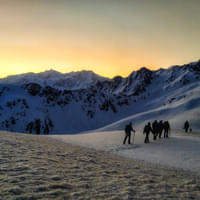
Trip Highlights
Experience a beginner-friendly trail to Sar Pass that passes through forests, meadows, quaint villages, and snow-covered mountains.
Trek up to a view that stretches as far as the eye can see with snow-capped giants like Deo Tibba, Indraasthaan, and the Pir Panjal range.
Get a magical camping experience that might allow you to witness the Milky Way Galaxy in all its glory, a sight often enveloped by city lights.
Get a sense of accomplishment standing at the top, where the world seems to spread out before you at a 4,200-meter high pass.

Know Before You Go
- Climatic conditions in the high altitudes vary from the plains; take adequate time to get acclimatized to high altitudes.
- The management reserves all the right to modify the trek during any emergencies or natural calamities.
- The trek takes place through an eco-friendly zone; do not encourage littering the local sites or campsites. Travellers littering may be fined.
- Water is very precious, so conservation is appreciated.
- Avoid using plastic bags and maintain the ecological balance of the destinations.
- The exact location will be shared with you post-booking.
- Neat and clean vehicle for the journey with experienced driver especially for hilly terrains available.
- Carry dry snacks/food from home (you will save a lot of money). Carry water bottles with you, so that you can refill.
- Avoid using earphones during the trek; this might hinder your audibility.
- In case, the trek needs to be cancelled, the authorities should be informed beforehand.
- All the activities depend upon the weather.
- Mobile & laptop charging points may/may not be available on campsites at a common point.
- Keep your luggage minimum; the more you carry, the more you hassle.
- Pay heed to the trek leader and guide in order to enjoy a safe and sound trek.
- Professional Treak Leaders are available to ensure high safety and more information and personal attention which are necessary to appreciate a trek.
- Camping is very basic in nature. One must not expect luxuries. Electricity will not be available at any campsite.
- It is recommended to carry enough warm clothes and the right kind of shoes for the Sar Pass trekking.
- Any personal expenses, items of personal nature, meals not mentioned, etc. will not be in part of the Sar Pass trek package.
- Itineraries are based on information available at the time of planning and are subject to change. "Thrillophilia'' reserves the right to change expedition dates, people or itineraries as conditions warrant If a trip must be delayed or the itinerary changed due to bad weather, road conditions, transportation delays, government intervention, airline schedules, sickness, or other contingency for which Thrilllophilia or its agents cannot make provision, the cost of delays and/or other changes are the responsibility of the participant. Thrillophilia reserves the right to decline, or accept, any individual as a trip member for any reason whatsoever.
- Liability for change in itinerary due to reasons beyond our control like a change in flight and train schedule, cancellation of flights/1trains, political disturbances, natural phenomenon, roadblocks, etc. will not be accommodated in the package cost. No bill will be reimbursed for any missed service/facility.
- During a trip, in case the roads are blocked due to landslides or a reason that is beyond control, Thrillophilia will rearrange the itinerary for the travellers real-time, however, the cost of alternative accommodation will be borne by the customer as the hotels pre-booked execute their cancellation policies and are nonrefundable.
- Because of any reason natural or personal, if the Trek or a particular activity is not completed, no refund will be processed.
- The difference in the cost shall be borne by the client in case of any amendment in the package due to change in the number of guests, hotel change, itinerary change, etc.
- If in case any traveller wants to or decides to leave the trip in the middle, all the expenses from that point onwards will be borne by the traveller. Neither the operator nor Thrillophilia will be held responsible for such decisions or for any refund.
- The refund or compensation is also not issued if for any reason you have to come down from the trek. The trek leader may send you down from the trek, owing to reasons like lack of fitness, AMS, blood pressure, turn-around-time, health issues, or if you are found smoking/ drinking, or breaking the rules of the trek. refund or compensation are issued only when the whole trek is cancelled or called off on behalf of Thrillophilia.
- At Thrillophilia, we almost never call off or cancel our treks. But in the rare event we might have to call off or cancel a trek due to any unforeseen natural catastrophes like continuous rain or snow, thunderstorms, snowstorms, landslides, floods, earthquakes, or any other natural calamity or other issues like local riots, curfews, pandemics, lockdowns, government orders, or any such situations that might prevent a safe trekking experience. In such cases, Thrillophilia will issue a Credit note summing up to the same amount as your trek fee that can be redeemed on any of the treks over a period of the next year.
Additional Information
About Sar Pass Trek:
Perched at 13,800 ft. above sea level, Sar Pass offers the magnificence of a beautiful verdant landscape and is a heaven for photographers, artists, and nature lovers. Set against a curtain of majestic Himalayan peaks wrapped in snow, the Sar Pass trek passes through some of the most scenic views ranging from forests to the meadows to the ice blankets.
While trekking across the path from Tila Lotni to Biskeri Ridge, one has to pass by a small, usually frozen lake which means "Sar" in the local language of Himachal. Hence the name, Sar Pass! The trail passes through the thick forest and takes you to a winter wonderland that makes it fascinating.
Sar Pass Trek Quick Facts:
Start Point/End Point: Kasol Base Camp. (It is 2 km away from the Kasol Bus Stand)
Duration: 4N/5D
Maximum altitude: 13,800 ft.
Sar Pass Trek Distance: 48 Kms
Temperature: 22 ° C (Max. During Day Time) to -5 ° C ( Min. During Night Time)
Best Time for Sar Pass Trek: April to Mid July
Sar Pass Trek Package Inclusions:
➔ Accommodation – You will be staying in tents for 4 days of the trek (3 people/tent). Room/Tent is separate for the male and female participants.
➔ Meals – (Breakfast, lunch, snacks, and dinner). We provide simple, nutritious veg/Jain food on all days of the trek.
➔ Camping charges – All trekking permits and forest camping charges are included.
➔ Trekking equipment – High-quality tents and sleeping bags in all the camps. Sleeping bags can withstand temperatures as low as -10 ºC.
➔ Safety equipment – First aid kit, oxygen cylinders, oximeter, etc. will be with guide/trek leader and at the campsite as well to deal with emergencies.
➔ Expert trek Leaders – All our trek leaders are at least qualified in basic/advanced mountaineering and first aid course.
➔ Expert Trek support team – The mountain staff on Sar Pass trekking consists of certified guides, cooks, helpers, and porters.
Available Group Departure Dates:
March: 26,27
April: 1,2,3,8,9,10,15,16,17,22,23,24,29,30
May: 1,6,7,8,13,14,15,20,21,22,27,28,29
June: 3,4,5,10,11,12,17,18,19,24,
July: 3,5,10, 12,17,18,19,24,
Note: Customisation available on request
How To Reach Kasol:
By Air: The nearest airport is Bhuntar Airport which is well connected with all major airports via Delhi and Chandigarh. The distance between Kasol and Bhuntar Airport is 32 km, so from Bhuntar, you can board the government/private bus, or can hire a private tourist cab to reach Kasol.
By Train: The nearest Railway station is Chandigarh which is 310 km away. From here one can easily get a government/private bus to Kasol. Another option is to hire a private cab, but that will be a bit expensive option.
By Road: Reaching Kasol by road is the most convenient option. You can easily get a bus to Bhuntar from all major cities like Chandigarh, Delhi, etc. And from Bhuntar, you can board the government/private bus, or can hire a private tourist cab to reach Kasol.
Related Products
Kasol tour faqs, what is the best time to go for sar pass trekking.
The best time to go for the Sar Pass trek is during the spring, and summer seasons. Although the trek takes place in the monsoon season, it is recommended to carry proper equipment and supplements as there are chances of landslides and slippery tracks. During this time, the trail is lined by lush green forests and you can also find blankets of snow at the higher altitudes. The temperature remains pleasant, aiding you to climb an altitude of almost 13,500 ft. In winters, the entire route gets jammed with extreme snowfall, thereby restricting trekking possibilities.
How much does the Sar Pass Trek cost?
The cost of a trek to Sar Pass can range between INR 5,000 to INR 9,000 per person which depends on the number of days included and the distance covered. The whole price is also dependent on the inclusions of the package like the meals, the travel assistance, the extra charges of entry to the reserved areas, and other additional expenses.
How is the weather during the Sar Pass trek?
The weather is generally cool and soothing during the Sar Pass trek in Kasol. The temperatures can range from 20 to 22 degree Celsius during the day time, and 0 to -5 degree Celsius during the night time. The spring and summer season is ideal to go for this trek, as the conditions remain near-perfect. During the monsoon season, there is a possibility of heavy rain that can hinder the progress and make the trek slippery, especially at steeper ascents. This trek does not take place in the winter season.
What is the total distance of Sar Pass Trekking?
The Sar Pass trekking distance is 40 to 50 KM in 5 days from the starting point of Kasol and back to the base again. Situated at an elevation of 13,800 feet, the Sar pass trek is an ideal trek for beginners in the Kull region of Himachal Pradesh.
What is the difficulty level of Sar Pass trek?
The difficulty level of Sar Pass trek ranges between easy to moderate level of difficulty, and no prior trekking experience is required. Since the 'easy-moderate' tag is relative to other difficult treks in the Himalayas, Sar Pass commands a moderate level of fitness from all trekkers. The treks include a near-vertical incline at the top and an equally steep descent. The air above 12,000 ft. is very thin, and the oxygen levels are considerably lower, which increases the level of difficulty. It is mandatory to follow a regular fitness regime to ensure your body adapts well to the lower oxygen on the trek.
Is Sar Pass Trek dangerous?
The Sar Pass trek is a relatively moderate trek than other Himalayan treks. Beginners can easily commence upon this trek with guides who are accustomed with the trail. Since this is an adventure activity, one needs to be cautious and take proper precautions while undertaking any trek. Thrillophilia’s Sar Pass trek packages are inclusive of all essential needs like meals, sleeping, bags, medical kits, and professional guides, thereby ensuring the safety and security of beginners. However, it is suggested to prepare for the trek from at least a month before and be physically fit.
How can I get Sar Pass from Delhi?
Kasol is an overnight journey from Delhi which takes around 11 hours. The trek to Sar pass begins from the base camp of Kasol. One can take a flight from Delhi to Kullu followed by a bus journey to Kasol. There is also a train to Bhunter from Delhi where you can catch a local bus till Kasol.
Can we do Sar Pass trek anytime of the year?
The best time recommended for doing Sar Pass trek is between May-July if you wish to experience both pleasant summers and snow-covered peaks. Sar Pass trek is usually not conducted during the winter months of October- December to avoid the chances of rough weather with hailstones and blizzards.
Can we do Sar Pass trek in winters?
Sar pass trek is mostly not arranged by companies during the winter season as the weather can be unpredictable between October- December. The chances of hailstorms and blizzard increases during the winter season and the trail also tends to get covered with the heavy snow in the Sar Pass trek.
What should I carry for Sar Pass trekking?
You need to be well-prepared for the Sar Pass trek.
1. Equipment and gears-
- Trekking pole
- Snow-friendly gloves
- Trekking shoes
- Backpack with rain cover
- Sleeping bag and camp (optional)
2. Clothing-
- Jackets (preferably those that cover sub-zero temperatures)
- Trekking pants
- Quick-dry socks
- Neck-warmer
3. Other essentials-
- Dry tissue paper and non-alcoholic wet tissues too.
- Sunscreen (preferably SPF 50+)
- Heavy moisturizer
- Cleanser/face-wash
- Smaller backpack to carry immediate stuff.
- Water bottle
What level of fitness is expected from trekkers for the Sar Pass Trek?
The Sar Pass trek is an easy to moderate level trek which holds some steep ascent, requiring good stamina. Naturally, this implies that trekkers must have a decent amount of fitness. You should be able to jog for 5 km in about 35 to 40 minutes to increase cardiovascular endurance.
Make your muscles stronger by doing 3 sets of squats with 15 reps per day, and some yoga asanas. This will aid acclimatization, and facilitate adaptability to lower oxygen levels on high altitudes.
Which type of shoes should I buy for Sar Pass trekking?
We recommend carrying trekking shoes with high ankle support, and good quality material that is water-resistant. Since the terrain is uneven and rugged, it is imperative that your trekking shoes have a good grip, which will be less prone to slipping. When buying new shoes, we insist that break them in at least 2-3 weeks before the trek to avoid chafing and blisters. Please avoid carrying sports shoes, as they are not meant for trekking, and can cause fatal slips. Also, carry at least 3-4 pairs of cotton socks.
How do I get to Sar Pass?
You can get to Sar Pass base camp which is in Kasol easily via public as well as private transit systems available.
By Bus- You can take a bus from Delhi, Chandigarh, or nearby major cities to Bhuntar. Kasol is 32 kilometres from Bhuntar, and this distance can be covered by taking a cab, or a public bus offered by Himalayan Road Transport Corporation.
By Train- The nearest railway station to Kasol is Joginder Nagar Railway Station in Mandi, which is easily connected to the major cities of Pathankot and Chandigarh. Some of the major trains running on this route are Pathankot - Jwalamukhi Road Express Special and Pathankot-Baijnath Paprola Express Special. Alternatively, a more convenient route is to travel to Chandigarh via train, and then take a cab or bus from there till Kasol, covering around 260 kilometres in 7-8 hours.
By Air- There are several direct flights from Delhi to Bhuntar airport that take hardly an hour to reach. Alternatively, you can avail of connecting flights from all major cities of India like Chandigarh, Amritsar, Jaipur, Kolkata, Bangalore, and others. From Bhuntar, Kasol is 32 kilometres away, taking 1-2 hours to reach via a private car, a cab, or a public bus.
Is there snow in Sar Pass in May?
Yes, You can witness snow in the Sar Pass Trek in May at the higher altitude places like the Sar Pass (top), Nagaru, and Biskeri Thach. Thrillophilia’s Sar Pass trek itinerary includes all these spots, where we provide camp stays for an enriching experience. During the peak summers in May, you can expect lush and vibrant valleys in the lower altitudes, thereby experiencing a varied range of landscapes and geographical wonders along the route.
Can I go for sar pass trek in November?
No, November marks the start of the winter season and there are high chances of snowfall that can block the route. Since the trek covers a high elevation, the temperatures can drop below -15 degrees Celsius, making it impossible to trek the 48-kilometer trail. Even if it does not snow in November, it is not safe to undertake the trek due to unpredictable weather conditions during this time. Thrillophilia’s Sar Pass trek package is non-functional in November.
What is the height of Sar Pass?
The height of this dramatic mountainous Pass is around 4220 m and 13,850 ft above sea level. The height can be reached by trekking for around five days in which you get to enjoy various splendid sceneries as well as a chance to pass through some of the most thrilling as well as adrenaline-rushing terrains.
Where does the Sar Pass trek start from?
The Sar Pass Trek begins from Kasol, from where you are required to trek to Garhan Village for 5 to 6 hours. From here, a 4 to 5 hour long trek is followed to Mung Thach and then to more 6 hours to Nagaru. From Nagaru, a 6 or 8 hour long trek is done to Biskeri Thatch via Sar Pass.
How is the Sar Pass trek experience?
Huddled 13,700 ft. above sea level in the Kullu district of Himachal Pradesh, sits a snowy dream world that beckons herds of adventurers into its folds every year. Sar Pass is one of the most beautiful treks in India and promises a medley of thick forests, sylvan meadows, and roaring streams. Your first stop is Kasol, which is the base village for the trek. It is a beautiful hamlet reflecting Israeli culture, which makes it every backpackers' dream destination.
The initial part of the Sar Pass trek is housed within stunning woods that seem like something right out of a fantasy movie. The scenery shifts from grassy meadows to the Winterland of Narnia midway through the trek! Patches of green and brown are veiled under a layer of powdery snow. The last hour or two of the trek to the main Sar Pass is the most thrilling part, as the incline of the slope is nearly 90 degrees!
As daunting as it sounds, the surrounding Himalayan beauty overpowers your fear and fatigue. The highlight of the Sar Pass trek is the descent from Sar Pass, which can't be traversed by trekking, give the steep incline. You have to slide down the slope! It feels like a roller coaster ride, only better. Experience your heart racing, and soul rejoicing as the little child in you comes shrieking alive!
Which are the other best Himachal treks that we can book from Thrillophilia?
Here is the list of best treks in Himachal that you can book from Thrillophilia:
- Hampta Pass Trek
- Kareri Lake Trek
- Bhrigu Lake Trek
- Beas Kund Trek
- Prashar Lake Trek
- Buran Ghati Trek
- Shrikhand Mahadev Trek
More on Kasol Tourism
- Skip to main content
- Skip to secondary menu
- Skip to primary sidebar

Indian Backpacker-Exploring India,Himalayas and Travel Technology
Sar Pass Trek | Best Himalayan Trek for Beginners in May-June
May 23, 2020 By Monish 12 Comments
Sharing is Caring!
Sar Pass Trek is no doubt one of “The Best Himalayan Trek for Beginners ” in the Shivalik ranges of Parvati Valley (Kasol, Himachal Pradesh, India) due to its scenic beauty and the trail. It’s also one of the most famous treks offered by YHAI (Youth Hostel Association of India) and it has a huge demand as well. I fell in love with one of the campsites of Sar Pass trek, which I will reveal later in the post and I completed this trek twice just to have a pleasant stay at that campsite. I hope you will be more interested to know the campsite and experience the same. Here I will help you with some information about Sar Pass Trek and share my experience throughout. Let us start our Trek!
Page Contents
About Sar Pass
Sar in local language means “Lake” . There are a lot of “Passes” in the Himalayan ranges. Basically, a Mountain Pass is nothing but a navigable shortcut through mountain ranges or ridges used by the local people to trade or move to the nearby villages. Sar Pass is one such pass used by the local people from the past. Now, this had turned to be a trail for trekkers in the Parvati valley. Sar Pass offers a very good view and the trails are blissful to eyes. Also, this Sar Pass trek is famous for the Snow Slide, where one can slide in Snow for almost 500 meters based on the snowfall.
Basic Information about the Sar Pass trek
Altitude: 13,800 ft from the sea level. Difficulty Grade: Moderate. Hours of Trek Per Day: 6 – 7 hours. Base Camp: Kasol, Himachal Pradesh, India. Number of Days: 10 Nights / 11 Days (Based on the Organizer 2 or 3 days can be reduced). Best Time: May-June.
Even though the trek has been rated with Moderate difficulty, from my experience I had witnessed this trek can be done even by a beginner. We as a group of 15 friends trekked Sar Pass in the year 2017 and our group completed the trek without any trouble. Our group had a mix of fit and partially fit people, who did some basic workouts before the trek for a month and completed it. Also, I want to say when we were on our trek, we encountered 87-year-old gentlemen trekking Sar Pass (He was not allowed to the summit, whereas he returned back from 3rd campsite). So in short, age doesn’t matter if you are fit and fine with a positive mindset.
I prefer YHAI for Sar Pass trek due to various reasons and I had penned down the reasons why should one consider trekking with YHAI . Booking for the YHAI Sar Pass trek starts around October or November with 50 – 60 slots per day. To book for the trek you can watch out this space often.
I will be writing this complete article based on the YHAI’s itinerary.
Day 1: Reporting Base Camp
Like YHAI, most of the trekking organizers, as well as private local guides, mark Kasol as the base camp. I have written a detailed article about Kasol and how to reach Kasol, here .
You will be asked by the organizers to report to your base camp within 8.00 PM. On your arrival, all the documents related to your trek like Medical Certificate, YHAI membership, Booking Receipt will be validated and once the process gets completed, you will be allocated with a Tent and provided with an Admit Card. Nothing much on Day 1, it’s time to socialize with people.
Day 2: Acclimatization, Orientation, and Training
Get ready to change your Biological Clock! Yes, its time to fine-tune your body to mountain culture and YHAI helps you to do it perfectly. You will get a Wake-up call at 5.00 Am. Only in base camp you will find normal washrooms and in all other camps,its tented washrooms with water except the Nagaru Camp. Hot tea will be ready by then and once that’s done get ready for your Physical Training Class. It all starts with some basic exercises and dynamic Stretches. Focus on your lower body will be emphasized more. Once you are back from the Physical Training class, it is time for your breakfast. Followed by an Acclimatization walk. It can be either to the river bank or to Manikaran. You will enjoy this walk with your trek mates.
You will be back to your base camp by afternoon and its time for your Lunch followed by Orientation about Do’s and Dont’s, YHAI history, etc. You will get some leisure time in the evening followed by Dinner and Campfire which you can enjoy.
Day 3: Rock Climbing ,Rappelling and Kit Inspection
The same routine of Physical Training follows on Day 3 as well. Followed by Rock Climbing and Rappelling session, this completely depends on the weather. If it’s rainy, then its time for the same acclimatization walk followed by Lunch. On Day 3, you will be packing your rucksack for the trek, and deposit the extra luggage in the Base Camp. Once your rucksack is packed, it will be inspected and weighed. Based on the Field Director’s advise you will be given heads up or asked to reduce the weight of the rucksack.
Dinner followed by the campfire as usual. Now, You are ready for the trek, and tomorrow you don’t have to wake up early as you will be starting your trek to higher camp!!
Day 4: Flag off and Trek to Grahan
On Day 4, around 8.00 Am in the morning your entire batch will be assembled in the base camp and flagged off to the next campsite. You will be cheered by the next batch, that’s a positive feeling which words can never describe but you should experience it.
Trek Time: 5-6 hours Altitude above sea level: 7700 Ft Difficulty from Kasol to Grahan: Moderate
Trek to Grahan is through the forest and you will be following the river for most of the distance. This trail has markings everywhere and one can easily navigate till the village. You might encounter deviations en route, but all the routes will lead to Grahan. You can encounter local people selling fruits like Fala Fal, Flower syrups on the trail. Ensure it’s never missed.
Grahan is the last civilized village on the way to Sar Pass trek. This is a small beautiful village where you can visualize a peaceful life lead by local people. When we had a chance to interact with local people, we got to know the pain and trouble they undergo staying in such a village that doesn’t have connectivity to the rest of the world. The small farms and the houses of local people, surrounded by huge mountains are definitely a visual treat to one’s eyes. You can take a tour around the village, where you can see the school, a volleyball court for the village, a gigantic temple carved in wood and architecture of houses made of wood. Also when we were on the trek, we got a chance to try local food of Himachal called Siddu. Local people will be very happy to serve you, just try it!
Important Note: Kids of Grahan will be expecting Candies from you, never disappoint them. Mobile networks will be partially available. You can try star gazing here.
Day 5: Trek to Padri Campsite
Trek Time: 6-7 hours Altitude above sea level: Approx 9000 Ft. Difficulty from Grahan to Padri: Easy
The trail to Padri is almost a flat one. Most of the organizers won’t camp in Padri, but YHAI has their campsite in Padri. This a beautiful campsite, which has one huge waterfall nearby. You are really gifted to see and enjoy the waterfall if it rains. This is one of the biggest campsites and you can have fun with your troop here. Do wander around this campsite and enjoy the scenic beauty here. From Padri you will be able to see the Nagaru Campsite and during the night. Just try showing your torchlight signal for which you can expect a response.
Important Note: No Mobile network. Exercise caution when you are near horses, you might get a kick.
Day 6: Trek to Min Thatch
Trek Time: 7-8 hours Altitude above sea level: 11,200 Ft Difficulty from Padri to Ming Thatch: Moderate to Difficult
Padri to Min Thatch is a never-ending trek. This seems to be a bit longer and you will be having your lunch at an awesome viewpoint. Post lunch the trek will be a bit difficult and you need to be safe in this trail. Thatch in the local language means “Grass Land”. All the campsites are in grassland and most of the cattle grazers have their stay in these grasslands during the night. When we were on a trek, at this campsite we had our Kabbadi match and it helps you to get warmed up fastly.
Important to note: Next campsite at Nagaru will not have water and you need to carry sufficient amount of water for you from Min Thatch.
Day 7: Trek to Nagaru
Trek Time: 5 hours Altitude above sea level: 12,500 Ft Difficulty from Ming Thatch to Nagaru: Moderate
You will be gaining less altitude, but this trek is considerably easy than your yesterday’s trek. Easy doesn’t mean that you can be fast. One should be very careful in this trail, as it’s very dangerous and riskiest. These trails are very slippery when there is a snowfall. You should ensure that a firm foothold is established before taking your next step. You will be almost reaching the ridge of the mountain and within a few meters, you will be reaching the flat hilltop, where the campsites would have been established.
Stargazing and sunset at Nagaru is a must-try one. You will be experiencing huge wind and cold at Nagaru. Often tents are blown away from this campsite due to heavy wind and when I was on the trek, we were holding the tents firmly for almost an hour. Never miss the fantastic view from this camp, as most of them would be tired and wish to stay inside the tent because of the climate. If you are trekking through YHAI, you will get Hot Gulab Jamoon as sweet at that altitude, which is a great treat for your tongue, after days.
Day 8: Summit Day and Trek to Biskeri Thatch:
Trek Time: 6-7 hours Altitude above sea level :13,800 Ft Summit Height Difficulty from Nagaru to Biskeri Thatch: Moderate to Difficult
As today will be your summit day, you will be starting your trek around 4.00 am. You will be reaching the maximum altitude of your trek 13,800 Ft and you can see the beautiful peaks around from Sar Pass. Do get in touch with your trek guide and ask about the surrounding peaks and they will explain to you in detail. Once you cross Sar Pass, you will be trekking mostly in snow and this trek will be also a never-ending one.
In this trail, you will get to experience the Snow Slide where you will be sliding in snow for almost 500 meters and Sar Pass trek is famous for this slide as well. One might experience mild headache before reaching the Biskeri Thatch as this is normal.
Day 9: Trek to Bandhak Thatch
Trek Time: 5 hours Difficulty from Biskeri Thatch to Bandhak Thatch: Easy
Here comes the campsite that “I LOVE THE MOST”. A flat grassland, with few tents, huge rock, surrounded by snow cap mountains and pine trees. I hope you can imagine the beauty of this location. One should enjoy this location peacefully and trust me, you will love this campsite. Most of the organizers and even some trekkers from YHAI tend to skip this campsite due to their leave concerns. If you are planning in such a way, I request you to enjoy this campsite rather than worrying about your leaves.
Day 10: Trek to Barshaini
Trek Time: 2 hours Difficulty from Biskeri Thatch to Bandhak Thatch: Easy
This is a small trek and you will be doing it yourself without any guide. On your way to Barshaini from Bandhak Thatch, you will be passing a few villages like Tulga, Pulga. Again you are back to civilization and now your feeling will be like “Why I am back here?”. You will get to see all the technology, transportation in Barshaini and you are back to normal life. Now its time to take a bath, you will be doing it after a long time. On the way back to your base camp by bus, you can have a dip in natural hot water spring at Manikaran and relieve your body pain.
Once you are back to base camp, you can participate in your last campfire, collect your certificates, bid goodbye to your friends and I know you will be leaving those mountains heavy-hearted.
These mountains will be calling you back forever and you would have made some lifetime friends. These treks teach us lots and lots of stuff, which we wish to follow in our life, once we are back to routine life. One who follows those lessons will lead a peaceful and healthy life, no doubt in it.
Packing Checklist for Sar Pass- The Best Himalayan Trek for Beginners
I hope you had enjoyed Sar Pass – The Best Himalayan Trek for Beginners artistically and you are thinking to experience this trek. If you are a beginner, you might be confused about the expense and things to take for the Trek. Please read this article on Essential Things to Carry for the Himalayan Trek to get your packing checklist. I am waiting to hear the campsite that you loved the most. Please do comment below about the same and share your experience below. If you feel, this article might be helpful for your friends, kindly share this with them.
If you feel this article might be useful, please “Pin the below Image” to your Pinterest board. You can do it just by clicking the save button while you hover the image or click the image.
Reader Interactions
May 25, 2020 at 9:57 am
Wonderful .. will go thru all your posts. All the best
May 25, 2020 at 5:45 pm
Thanks Chari. Please keep following
May 25, 2020 at 11:06 am
Very nice moni…best camp is minthach
Thanks a lot Anto! Definitely Minthatch is also one of the best campsites
June 18, 2020 at 4:56 am
Nice write up….I also did The Sarpass trek with yhai for 2 times…..first time it was in 2004 and second in 2008 ….it was awesome experience…when I visited Kasol first time, it was so beautiful and calm village…but in bare 5 yrs it was changed. Can’t imagine how it is now…I have goosebumps reading some of part of ur article…as u said…all those mountains call again…m waiting for my call….thanks for sharing.
June 18, 2020 at 5:08 am
Thanks Meeta for your time on reading this article.. Glad you enjoyed it. Do subscribe to our new letter to get upadate on new destinations😊
June 21, 2020 at 1:06 am
Hey Monish, I like the way you describe this whole trek day wise, so beautifully. I have been to kheerganga twice, to rasol, chalal, tosh, pulga and malana. Looking at the campsite site and beauty I will definitely do this with YHAI. Thanks for putting in all information about this trek so nicely.
June 21, 2020 at 1:43 am
Thanks Pankaj! Glad you enjoyed the article.. Please do share your experience here once you complete the trek. Also follow us on Instagram @duskydawn_official, I have added some beautiful pics of this trek 😊❤
July 16, 2020 at 4:52 am
Nice post Monish getting back all memories..😀
July 16, 2020 at 6:33 am
Thanks Selva… Glad you loved this article. Please do subscribe to our newsletter
July 16, 2020 at 9:26 am
Hey Monish, Nice writeup.. After reading the detail blog I am eager to do Sarpass.
July 16, 2020 at 9:44 am
Thank you Dr sir… Hope you are doing good… Sure we will do it together
Leave a Reply Cancel reply
Your email address will not be published. Required fields are marked *
Save my name, email, and website in this browser for the next time I comment.

- Trekking & Travel Events
- Travel Organizations
- Himalayan Treks
- Maharashtra Treks
- Karnataka Treks
- Travel Guides
- Weekend Getaways
- Trekking Tips & Advice
Sar Pass Trek: A Complete Guide (Updated 2024)
- Trekking Destinations
Are you seeking an exhilarating trekking experience amidst the breathtaking Himalayan landscapes? Look no further than the Sar Pass Trek.
This trek is a favourite among outdoor enthusiasts and nature lovers. It offers a perfect blend of natural beauty and adventure.
In this article, we will dive into the details of the trek, including the distance, best time to visit, difficulty level, essential gear, and a comprehensive itinerary to help you plan your unforgettable journey.
Table of Contents
Overview of Sar Pass Trek
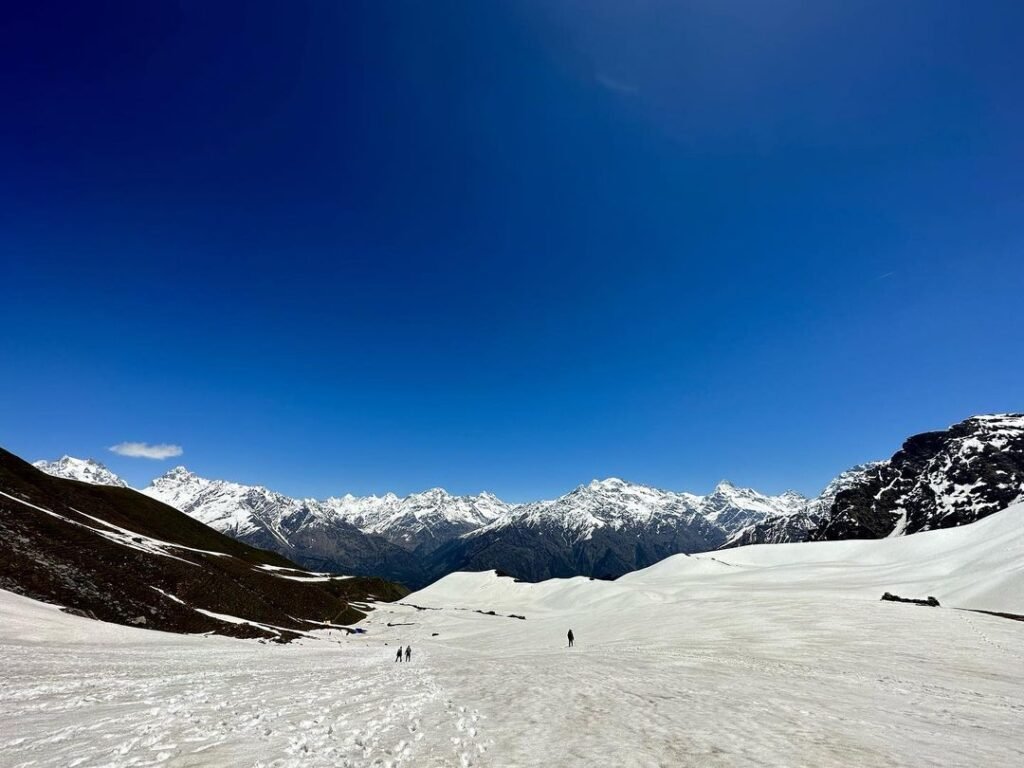
The Sar Pass Trek is a popular Himalayan trek in the Parvati Valley of Himachal Pradesh, India. The distance of the trek is approximately 48 kilometres; this trek offers a thrilling and picturesque adventure for nature lovers and adventure enthusiasts.
The trek begins from the quaint village of Kasol, known for its scenic beauty and serene atmosphere. Trekkers from Kasol traverse through dense pine forests, crossing gushing streams and charming meadows. The trail gradually ascends, leading trekkers to higher altitudes.
One of the highlights of the trek is the crossing of the Sar Pass itself, situated at an altitude of about 4,220 meters. This challenging section requires traversing steep slopes and snow-covered terrain, offering trekkers a sense of accomplishment upon reaching the pass.
The journey also includes mesmerizing views of snow-capped Himalayan peaks, including Sar Pass, Tosh Glacier, and Parvati Valley. Trekkers are treated to breathtaking panoramic vistas throughout the trek, creating unforgettable memories.
Depending on the chosen itinerary, the trek usually takes 5-6 days to complete. Campsites along the route provide a tranquil setting for trekkers to rest, enjoy bonfires, and soak in the beauty of the surroundings.
With its stunning landscapes, thrilling challenges, and a glimpse into the local culture, the trek is a remarkable adventure that allows trekkers to immerse themselves in the natural beauty of the Himalayas.
- Max Altitude: 13,800 Ft.
- Average Trekking Fees: INR 7000 – INR 12,000 + GST (Per Person)
- Distance: 48 – 50 kms
- Difficulty: Moderate
- Duration: 5-6 days
- Ideal For: Experienced Trekkers
- Best Season: April – June
- Region: Himachal Pradesh
Additional Information of the Sar Pass Trek
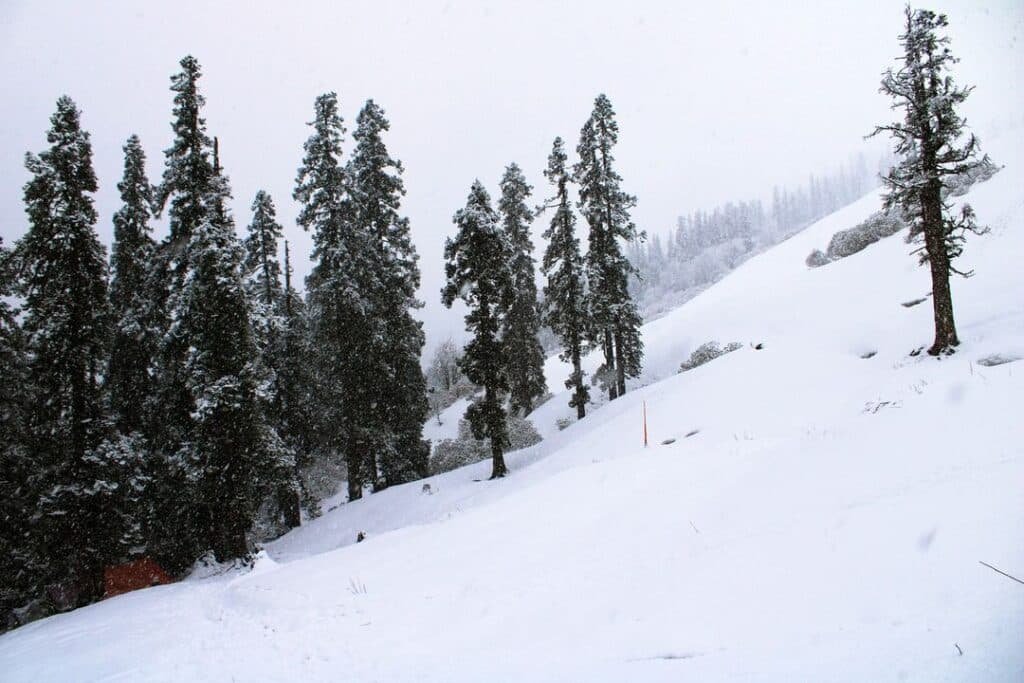
Trek Distance
The Sar Pass Trek covers a total distance of approximately 48 kilometres (30 miles) . It is usually completed over 5-6 days, depending on the pace and acclimatization of the trekkers. Each day’s distance varies, ranging from 6 to 12 kilometres (4 to 7.5 miles) , offering a perfect balance of trekking challenges and exploration.
Best Time to Do Sar Pass Trek
The best time to embark on the trek is from May to June and September to October . During these months, the weather conditions are relatively stable, with clear skies and comfortable temperatures. The summer months of May and June provide pleasant trekking conditions with moderate temperatures, while September and October offer the enchanting beauty of autumn colours.
Difficulty Level
The trek is rated as a moderate trek in terms of difficulty . It presents a reasonable challenge to trekkers, requiring good physical fitness and stamina. The trail involves steep ascents and descents, traversing through snow patches and rocky terrains. Prior trekking experience is not mandatory, but it is recommended to have basic fitness and endurance training before attempting this trek.
Acclimatization and Fitness Preparation
Acclimatization is crucial while trekking in high-altitude regions to prevent altitude sickness. Before starting the trek, spending a day in Kasol or nearby villages is recommended to acclimatize to the elevation. Engaging in light activities and staying hydrated during this period will help your body adjust to the changing altitude.
Preparing physically for the trek is advisable by engaging in regular exercises such as jogging, cycling, or swimming. Building stamina through cardio workouts and leg-strengthening exercises will greatly enhance your trekking experience.
Costing & Budget for the Sar Pass Trek
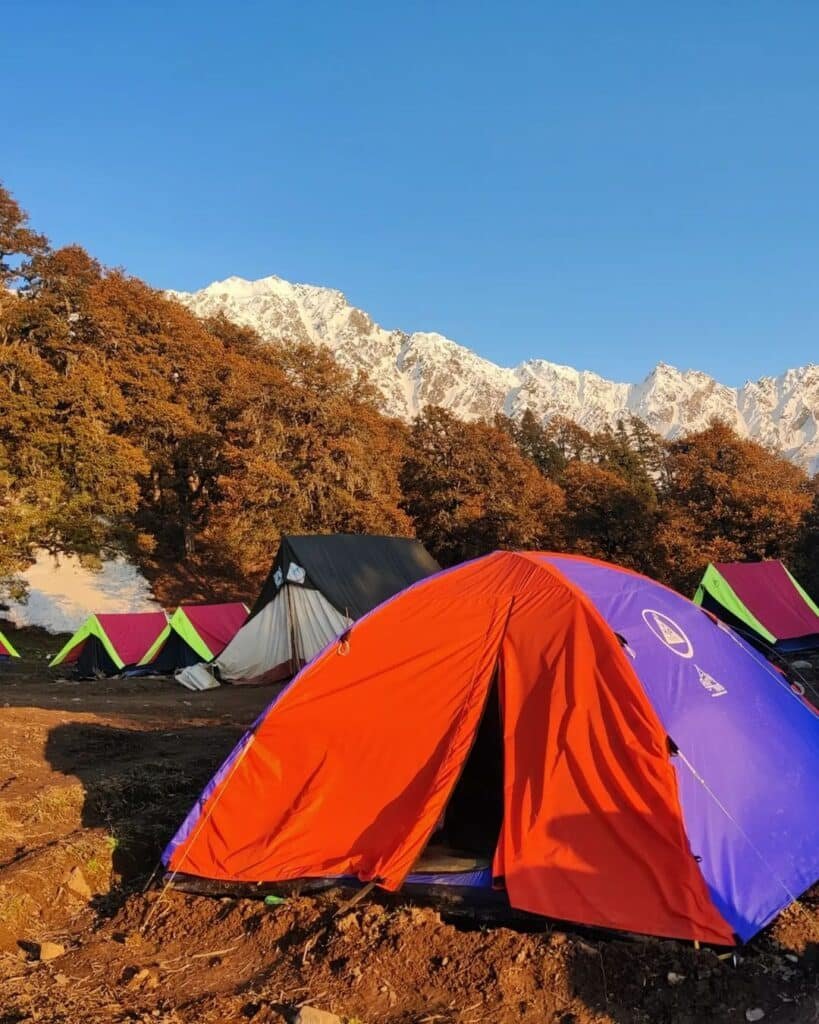
When planning for the trek, it is important to consider the cost and budgeting aspects to ensure a smooth and enjoyable experience. Here are some key factors to keep in mind:
Trekking Packages: Various trekking agencies and tour operators offer packages for the trek. These packages typically include transportation, accommodation, meals, trekking permits, and a guide. The cost of these packages can vary depending on the inclusions, duration of the trek, and the operator’s reputation. It is advisable to compare prices and read reviews before choosing a package.
Average Trekking Fees Charged By Organisations: INR 7000 – INR 12000.
Travel Expenses: Apart from the trekking package, you must consider travel expenses to reach the base camp. Kasol is usually the starting point for the trek, and you may need to budget for transportation from your place of origin to Kasol. This can include bus or taxi fares.
Equipment and Gear: Ensure you have appropriate trekking gear, such as sturdy hiking boots, warm clothing, a backpack, a sleeping bag, trekking poles, and other essentials. If you don’t already own these items, factor in the cost of purchasing or renting them.
Food and Water: Most trekking packages include meals during the trek, but carrying some extra snacks and energy bars is a good idea. Additionally, budget for bottled water or water purification tablets to ensure a safe drinking supply.
Miscellaneous Expenses: It’s advisable to set aside a small amount for unexpected expenses or emergencies during the trek, such as additional meals, medical supplies, or extra days if the weather conditions pose challenges.
In conclusion, the total cost of the trek depends on various factors, including the trekking package, travel expenses, equipment, food, and miscellaneous expenses. Planning ahead, researching prices, and allocating a reasonable budget for a comfortable and memorable trekking experience are recommended.
How to Reach Kasol?

The starting point of the trek is typically in the village of Kasol, which is well-connected to major cities in India. Here are the common modes of transportation to reach Kasol:
By Air : The nearest airport to Kasol is Bhuntar Airport, approximately 31 kilometres away. Regular flights operate from major cities like Delhi and Chandigarh to Bhuntar. You can hire a taxi or take a bus from the airport to reach Kasol.
By Road: Kasol is well-connected and can be reached by bus or private taxi. Regular buses operate from Delhi, Chandigarh, and other major cities to Bhuntar or Manali. You can take a local bus or hire a taxi to reach Kasol. The road journey offers scenic views of the mountains and valleys.
By Train : The nearest railway station to Kasol is Joginder Nagar Railway Station, approximately 144 kilometres away. However, it is a narrow-gauge railway station, and not all trains connect directly to Joginder Nagar. An alternative option is to take a train to Chandigarh or Pathankot and then continue the journey by road via bus or taxi.
Once you reach Kasol, you can start the trek from there. Reaching Kasol a day before the trek is advisable to rest and acclimate to the altitude. You can find local transport options like shared cabs or hire a local guide to reach the exact starting point of the trek within Kasol.
Detailed Itinerary of Sar Pass Trek
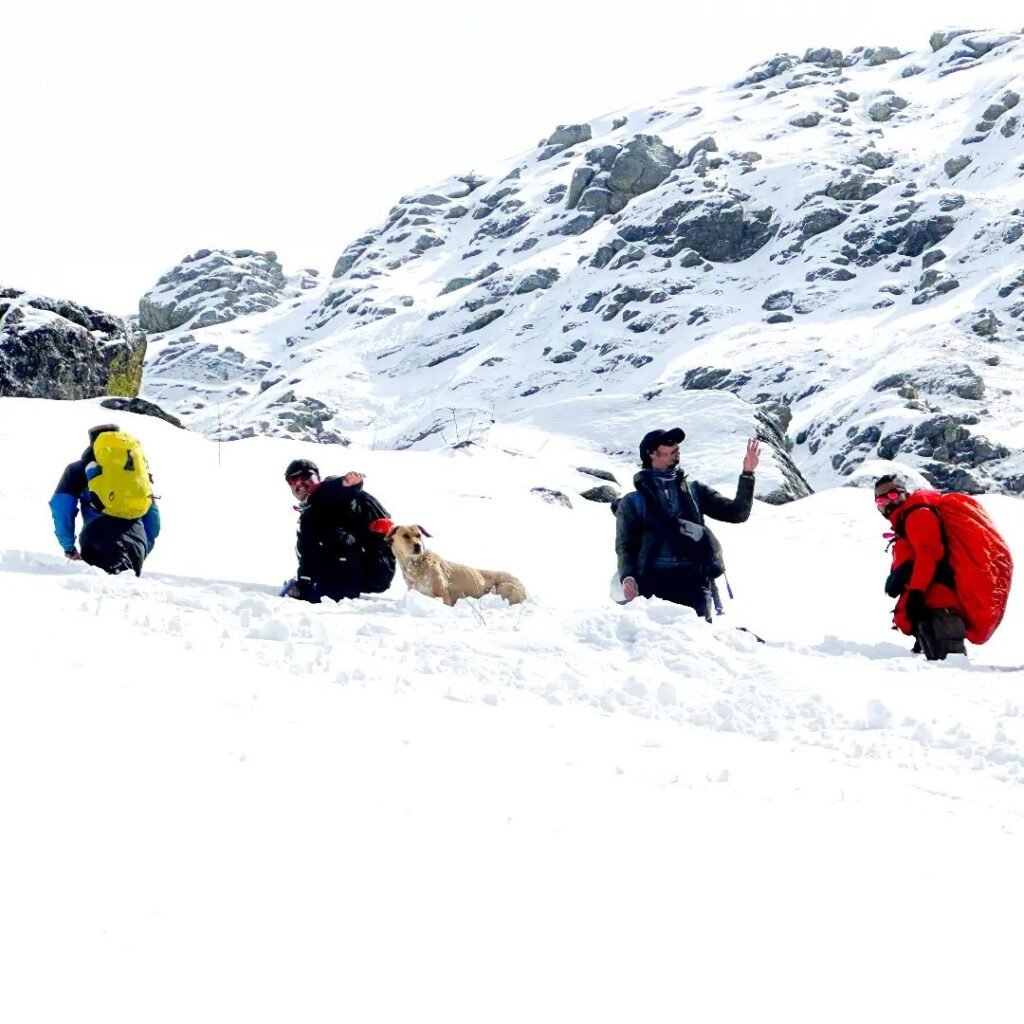
Here is a day-by-day breakdown of the trek itinerary:
Day 1: Arrival in Kasol
- Arrive in Kasol, a picturesque village nestled in the Parvati Valley.
- Explore the local markets and immerse yourself in the serene surroundings.
- Attend a briefing session by the trek leaders and get acquainted with fellow trekkers.
Day 2: Trek from Kasol to Grahan Village
- Start from Kasol, crossing the Parvati River and ascending through dense forests.
- Reach Grahan Village, a quaint Himalayan village known for its traditional architecture.
- Camp overnight in Grahan Village, surrounded by towering mountains and starry skies.
Day 3: Trek from Grahan Village to Min Thach
- Begin the day’s trek, passing through scenic meadows and blooming rhododendron forests.
- Ascend towards Min Thach, enjoying panoramic views of the valley and snow-capped peaks.
- Set up camps at Min Thach, relishing the tranquillity of the pristine surroundings.
Day 4: Trek from Min Thach to Nagaru
- Embark on a steep ascent from Min Thach to Nagaru, reaching an altitude of approximately 3,700 meters (12,100 feet).
- Experience the thrill of crossing snow patches and witnessing the mesmerizing landscape unfold.
- Camp overnight at Nagaru, with the starlit sky above and the grandeur of the mountains surrounding you.
Day 5: Summit Day – Trek from Nagaru to Biskeri Thach via Sar Pass
- Start early for the challenging trek to Sar Pass, about 4,220 meters (13,845 feet).
- Traverse through snowfields and conquer the past, experiencing a sense of accomplishment and awe-inspiring views.
- Descend towards Biskeri Thach, where you will camp amidst picturesque meadows and stunning vistas.
Day 6: Trek from Biskeri Thach to Barshaini and Return to Kasol
- Descend from Biskeri Thach through thick forests and charming trails.
- Reach Barshaini, where the trek concludes.
- Board a vehicle from Barshaini to Kasol and celebrate the successful completion of your trek.
Please Note: This is a general itinerary, followed by most of the trekking groups in India. However, there might be slight differences in the itinerary depending on the trekking group you opt to go with.
Highlights of the Sar Pass Trek

The trek offers a multitude of breathtaking highlights that make it a must-visit destination for adventure enthusiasts. Here are some of the key highlights of the trek:
- Majestic Mountain Views: Trekkers are treated to awe-inspiring views of the mighty Himalayan peaks throughout the trek. The panoramic vistas of snow capped mountains, including Sar Pass, Tosh Glacier, and Parvati Valley, create a stunning backdrop and leave trekkers spellbound.
- Dense Pine Forests: The trek takes you through dense pine forests that exude a tranquil atmosphere. Walking amidst the towering pine trees provides a refreshing experience and a respite from bustling city life.
- Picturesque Campsites: The trek presents picturesque campsites nestled amidst nature’s bounty. These campsites, situated near gurgling streams and lush meadows, provide a perfect setting for trekkers to unwind, enjoy bonfires, and soak in the peaceful ambience of the surroundings.
- Challenging Pass Crossing: Crossing the Sar Pass is a trek highlight. With an elevation of around 4,220 meters, it offers a thrilling adventure as trekkers navigate steep slopes and snow-covered trails. The sense of achievement upon reaching the pass is unparalleled.
- Frozen Lake and Snowfields: During certain months, trekkers can witness a frozen lake and traverse snowfields along the trek. The pristine beauty of the frozen lake and the glistening white snowfields create a surreal experience, adding to the charm of the trek.
- Local Culture and Hospitality: Interacting with the friendly locals along the trek route provides a glimpse into the unique culture and lifestyle of the region. Trekkers can engage with the warm-hearted villagers, savour local cuisine, and learn about the traditions and customs of the area.
Overall, the Sar Pass Trek offers a perfect blend of natural beauty, adventure, and cultural experiences, making it a memorable journey for trekkers seeking to explore the enchanting landscapes of the Himalayas.
Safety Tips & Precautions
While embarking on any trek, safety should always be a top priority. Here are some essential safety tips to keep in mind during the Sar Pass Trek:
- Trek with an experienced guide and follow their instructions.
- Stay hydrated and carry an adequate supply of water.
- Pack light and carry only the essential items.
- Dress in layers to adapt to changing weather conditions.
- Respect the environment and maintain cleanliness.
- Inform someone about your trekking plans and expected return.
- Stay updated about weather conditions and local regulations.
- Avoid alcohol and smoking during the trek.
Unlock the Adventure: Subscribe Now for Exclusive Deals, Insider Tips, and Epic Trekking Guides Delivered to Your Inbox!
Essential Gear and Equipment for Sar Pass Trek
Before embarking on the trek, it is essential to pack the right gear and equipment to ensure a safe and comfortable journey. Here is a list of items you should consider carrying:
- Good quality Trekking shoes with good ankle support
- Backpack with rain cover
- Trekking gaiters
- Warm and waterproof clothing layers
- Sleeping bag suitable for sub-zero temperatures
- Trekking poles for better stability on uneven terrains
- UV-protected sunglasses and sunscreen
- Water bottles and water purification tablets
- Headlamp or flashlight with extra batteries
- First aid kit with essential medications
- Portable power bank for charging electronic devices
The Sar Pass Trek is a thrilling adventure that takes you through the pristine beauty of the Himalayas. With its easy to moderate difficulty level, mesmerizing landscapes, and the joy of conquering Sar Pass, this trek offers an experience of a lifetime. So, pack your bags, prepare yourself physically, and get ready to embark on this unforgettable journey in the lap of nature.
The Sar Pass trek is moderately difficult and suitable for experienced trekkers due to steep ascents, rocky terrain, and changing weather conditions.
Sar Pass trek is in the Parvati Valley of Himachal Pradesh, India and the start point of the trek is Kasol.
The trek from Kasol to Sar Pass covers a distance of approximately 48 kilometres.
There can be snow on the Sar Pass trek in June, particularly at higher altitudes. It is advisable to be prepared for snowy conditions and carry appropriate gear.
Kuari Pass , Bhrigu Lake , Brahmatal Trek , Shrikhand Mahadev Trek , Buran Ghati Trek , Bali Pass Trek , Kareri Lake Trek , Rupin Pass , Tarsar Marsar Trek
- trekking guides
- No comments yet.
Add a comment
Leave a reply · cancel reply.
Your email address will not be published. Required fields are marked *
This site uses Akismet to reduce spam. Learn how your comment data is processed .
- Share via...

Love for snow and high mountains?
Sar pass trek, ₹9999 + 5% gst, june to september, via kasol (4223 m), ₹9999+ 5% gst, kasol to kasol, + rs. 1800 backpack offloading + rs. 757 mandatory insurance, difficulty level - 3, himachal pradesh - 6 days - 50 kms, up to 15% off in may-jun batches for a limited period ✨, june to september 2023.
The Sar Pass Trek is a popular trekking route located in the Parvati Valley of Himachal Pradesh, India. It is considered a moderately challenging trek suitable for both beginners and experienced trekkers. Here's some information about the Sar Pass Trek:
1. Duration: The Sar Pass Trek typically takes around 5 to 6 days to complete. The actual duration may vary depending on factors such as the trekking speed, weather conditions, and the itinerary chosen.
2. Difficulty Level: The Sar Pass Trek is graded as a moderate trek. While it does not require any technical climbing skills, it does involve trekking through steep ascents, traversing snow patches, and walking on uneven terrain. Prior trekking experience and a moderate level of fitness are recommended.
3. Route and Highlights: The trek starts from Kasol, a popular tourist destination, and takes you through beautiful pine forests, meadows, and scenic landscapes. Some of the highlights of the Sar Pass Trek include camping at scenic spots like Grahan, Min Thach, Nagaru, and Biskeri Thach, crossing the Sar Pass (located at an altitude of approximately 4,200 meters or 13,800 feet), and enjoying panoramic views of snow-capped peaks such as Tosh Glacier, Pin Parvati Pass, and the Pir Panjal Range.
4. Best Time to Visit: The best time to undertake the Sar Pass Trek is during the summer months of May to June and the post-monsoon season of September to October. During these periods, the weather is generally favorable with mild temperatures and clear skies. The trek is not recommended during the monsoon season (July and August) due to heavy rainfall and the risk of landslides.
5. Permits and Guide: Trekkers are required to obtain a trekking permit from the Forest Department or the local authorities before embarking on the Sar Pass Trek. It is also advisable to trek with an experienced guide or join organized trekking groups for safety and to enhance the overall trekking experience.
6. Facilities and Accommodation: Along the trek route, basic facilities such as guesthouses, tea houses, and tented accommodations are available at various camping sites. It's important to note that these facilities may vary in terms of amenities, so it's advisable to carry essential supplies and camping equipment such as tents, sleeping bags, and cooking utensils.
The Sar Pass Trek offers a wonderful opportunity to explore the scenic beauty of the Parvati Valley and experience the thrill of high-altitude trekking. It's important to prepare adequately, including physical fitness training, carrying appropriate trekking gear, and being mindful of safety guidelines while on the trek.
Duration: 4-5 days Maximum Altitude: 4,223 meters Difficulty Level: Easy Best Season: June to September
Sar Pass is a breathtaking mountain pass located in the enchanting Parvati Valley of Himachal Pradesh, India. Nestled amidst the majestic Himalayan ranges, Sar Pass offers a mesmerizing trekking experience to adventurers from around the world. This popular trek is renowned for its scenic beauty, diverse landscapes, and a moderate level of difficulty.
At an elevation of approximately 4,220 meters (13,845 feet), Sar Pass presents a challenge that is both exhilarating and rewarding. The trek begins in the quaint village of Kasol, a popular base camp for trekkers. As you embark on this remarkable journey, you leave behind the hustle and bustle of city life and enter a world of serene natural beauty.
The trekking route to Sar Pass covers a distance of about 48 kilometers (30 miles) and takes around 5 to 6 days to complete. The trail meanders through dense pine forests, picturesque meadows, and charming villages, offering a glimpse into the local culture and way of life. As you ascend higher, the landscape transforms, revealing stunning vistas of snow-capped peaks, gushing streams, and alpine meadows adorned with vibrant flowers.
The Sar Pass trek presents a moderate level of difficulty, making it accessible to both beginners and experienced trekkers. While it doesn't require technical climbing skills, it demands a certain level of physical fitness, endurance, and mental resilience. The trail involves steep ascents and descents, crossing rivers and streams, and navigating through snow patches. However, with proper preparation, the Sar Pass trek is well within the reach of trekkers with basic fitness levels and some prior experience.
The best time to undertake the Sar Pass trek is during the summer months of May to June and the post-monsoon season of September to October. During these periods, the weather is generally favorable, with mild temperatures and clear skies. The trail is less affected by heavy rainfall or snowfall, making it safer and more accessible. It's important to note that trekking during the monsoon season (July and August) is not recommended due to the risk of landslides and difficult trail conditions.
As you embark on the Sar Pass trek, you are greeted by a mesmerizing landscape at every turn. The trail takes you through dense forests of deodar, pine, and oak trees, providing shade and a refreshing ambiance. The sound of gurgling streams and the chirping of birds accompany you on your journey, creating a serene and tranquil environment.
One of the highlights of the Sar Pass trek is reaching the Sar Pass itself. As you ascend to the pass, you are welcomed by panoramic views of the surrounding Himalayan peaks, including the mighty Parvati Valley. The sight of the snow-covered landscape and the sense of achievement upon reaching the pass make for a truly unforgettable experience.
Throughout the trek, you have the opportunity to interact with the warm and hospitable locals who inhabit the villages along the route. Their simple way of life and rich cultural heritage add a unique charm to the trekking experience. Camping at night under the starlit sky, sharing stories and laughter around a bonfire, and enjoying delicious local cuisine are moments that create lasting memories.
While the Sar Pass trek is a remarkable adventure, it is important to prioritize safety and responsible trekking practices. It is recommended to trek with an experienced guide or join organized trekking groups that ensure proper guidance, safety measures, and support. Carrying essential trekking gear, such as sturdy trekking shoes, warm clothing, a waterproof backpack, a tent, and sleeping bags, is crucial for a comfortable and enjoyable experience.
Itinerary of Bara Bhangal Trek
The Sar Pass trek is a 5-6 day adventure that takes you through the mesmerizing landscapes of the Parvati Valley in Himachal Pradesh, India. Here is a detailed itinerary for the Sar Pass trek:
Day 1: Arrival in Kasol
On Day 1 of the Sar Pass trek, you will arrive in Kasol, which serves as the starting point of the trek. Here's what you can expect on this day:
- Arrival in Kasol: Reach Kasol, a small village nestled in the Parvati Valley, either by road or by taking a bus from nearby towns like Bhuntar or Manali. Kasol is known for its scenic beauty and serene atmosphere, attracting backpackers and nature enthusiasts from all over.
- Acclimatization: Spend the day in Kasol to acclimatize to the altitude, especially if you have arrived from lower elevations. It's essential to give your body time to adjust to the altitude to minimize the risk of altitude sickness. You can take a leisurely stroll around Kasol, explore the local market, and soak in the stunning views of the surrounding mountains.
- Accommodation: Check-in at a guesthouse or campsite in Kasol where you will spend the night. Kasol offers a range of accommodation options catering to different budgets and preferences.
- Relaxation and Preparation: Use this time to relax, rejuvenate, and prepare for the upcoming trek. Ensure that you have all the necessary trekking gear and equipment, such as sturdy trekking shoes, warm clothing, a backpack, and other essentials.
- Orientation and Briefing: If you have joined an organized trekking group, there may be an orientation session or briefing by the trek leaders. They will provide information about the trek, and safety guidelines, and answer any questions or concerns you may have. Pay attention to the instructions given to ensure a smooth and enjoyable trekking experience.
- Rest and Sleep: Get a good night's sleep to ensure you are well-rested and ready for the trekking adventure that awaits you the next day.
Day 1 of the Sar Pass trek in Kasol serves as a transition day, allowing you to acclimatize and prepare yourself physically and mentally for the trek. Take the opportunity to enjoy the serene ambiance of Kasol and recharge for the exciting days ahead.
Day 2: Kasol to Grahan Village
On Day 2 of the Sar Pass trek, you will embark on your journey from Kasol and make your way toward Grahan Village. Here's a detailed overview of what to expect on this day:
- Trek Start: After an early breakfast, gather your belongings, and meet your trekking group or guide. The trek starts with a gradual ascent from Kasol, gradually leaving behind the village and entering the lush green surroundings of the Parvati Valley.
- Pine Forests and Scenic Views: As you trek further, you'll pass through dense pine forests, which provide shade and a refreshing ambiance. Enjoy the fragrance of the pine trees and the soothing sound of nature. The trail offers glimpses of the stunning mountain vistas and panoramic views of the valley.
- River Crossings: During the trek, you may come across streams and rivers that need to be crossed. Depending on the water level, you may use makeshift bridges or step on stones to cross them. Take caution and follow the instructions of your trek leader while crossing the water bodies.
- Villages and Local Culture: En route to Grahan Village, you'll pass through picturesque hamlets and interact with the locals. Immerse yourself in the local culture, observe their traditional way of life, and interact with the friendly villagers. It's a great opportunity to learn about the local customs, traditions, and daily routines.
- Grahan Village: After a few hours of trekking, you will reach Grahan Village, a charming village nestled amidst the mountains. The village is known for its rustic beauty, traditional wooden houses, and terraced fields. Set against the backdrop of snow-capped peaks, Grahan Village offers a peaceful and serene atmosphere.
- Campsite Setup: Upon reaching Grahan Village, set up your campsite for the night. Depending on the trek arrangements, tents may already be set up, or you may need to pitch your own tents. Enjoy the tranquility of the surroundings and soak in the beauty of nature.
- Evening Activities: Spend the evening exploring Grahan Village, interacting with the locals, or simply relaxing at the campsite. Engage in conversations with fellow trekkers, share stories, and enjoy a warm and hearty meal prepared by the trekking team.
- Rest and Sleep: As the day comes to an end, unwind and get some rest. Ensure you have a good night's sleep to recharge for the next day's trek.
Day 2 of the Sar Pass trek takes you from the starting point in Kasol to the picturesque Grahan Village. It offers a blend of natural beauty, cultural experiences, and the joy of trekking through the enchanting Parvati Valley. Embrace the serenity of Grahan Village and prepare for the adventures that lie ahead on this incredible journey.
Day 3: Grahan V illage to Min Thach
On Day 3 of the Sar Pass trek, you will continue your journey from Grahan Village and make your way toward Min Thach. Here's a detailed overview of what to expect on this day:
- Morning in Grahan Village: Wake up early in the morning, breath in the fresh mountain air, and enjoy a hearty breakfast at the campsite. Pack your belongings, ensure you have enough water and snacks for the day, and get ready for another day of trekking.
- Departure from Grahan Village: Bid farewell to the charming Grahan Village as you start your trek towards Min Thach. The trail initially descends before gradually ascending through the enchanting forests and meadows of the Parvati Valley.
- Lush Green Meadows: As you ascend, you'll pass through lush green meadows adorned with colorful flowers, creating a picturesque landscape. Take in the panoramic views of the surrounding mountains and valleys as you make your way through this scenic section of the trek.
- River Crossings: During the trek, you may encounter streams and rivers that need to be crossed. Be prepared to navigate across them using makeshift bridges or by stepping on stones, depending on the water level. Exercise caution and follow the guidance of your trek leader.
- Ascending towards Min Thach: The trail gradually climbs uphill, providing a moderate level of challenge. As you ascend, you'll witness the changing landscape with a mix of forests, meadows, and occasional glimpses of snow-capped peaks in the distance.
- Reaching Min Thach: After a few hours of trekking, you will reach the scenic campsite of Min Thach. Nestled amidst the mountains, Min Thach offers breathtaking views of the surrounding landscapes. Set up your campsite and take some time to relax, soak in the beauty of nature, and rejuvenate for the next day's trek.
- Evening Activities: Spend the evening exploring the campsite surroundings, taking photographs, or simply unwinding amidst nature's tranquility. Engage in conversations with fellow trekkers, share experiences, and relish a warm and nutritious meal prepared by the trekking team.
- Rest and Sleep: As the day comes to an end, rest and recharge for the next day's adventure. Enjoy a peaceful night's sleep in the midst of the mountains, surrounded by the sounds of nature.
Day 3 of the Sar Pass trek takes you from Grahan Village to the beautiful campsite of Min Thach. This leg of the journey offers a m ix of natural beauty, including lush meadows, forests, and the thrill of trekking in the mountains. Embrace the serenity of Min Thach, connect with nature, and prepare for the exciting days ahead on this remarkable trek.
Day 4: Min Th ach to Nagaru
On Day 4 of the Sar Pass trek, you will continue your adventure from Min Thach and make your way towards Nagaru, a high-altitude campsite. Here's a detailed overview of what to expect on this day:
- Morning at Min Thach: Wake up early in the morning to witness the beauty of the sunrise illuminating the surrounding mountains. Enjoy a hearty breakfast at the campsite, pack your belongings, and prepare for the day's trek.
- Ascending to Nagaru: The trail from Min Thach to Nagaru is a challenging and steep ascent. As you trek higher, the terrain becomes rocky and the vegetation becomes sparse. This section of the trek requires stamina and endurance, as well as careful footing.
- Snowfields and Alpine Scenery: As you ascend towards Nagaru, you will start encountering snowfields, especially during the winter months. Traverse through the snow-covered landscapes, taking in the breathtaking alpine scenery and panoramic views of the surrounding peaks.
- Altitude Gain: Nagaru is situated at a significantly higher altitude compared to the previous campsites. The climb can be physically demanding, and it's crucial to maintain a slow and steady pace to acclimatize properly. Listen to your body, take breaks when needed, and stay hydrated throughout the trek.
- Nagaru Campsite: Upon reaching Nagaru, set up your campsite and take some time to rest and relax. The campsite at Nagaru offers awe-inspiring views of the snow-capped mountains and the valley below. Embrace the serenity of the high-altitude surroundings and savor the accomplishment of reaching this point.
- Sunset Views: Nagaru is renowned for its stunning sunset views. As the day draws to a close, find a vantage point to witness the magical hues of the setting sun painting the sky and mountains. Capture this breathtaking sight in your memories and photographs.
- Evening Activities: Spend the evening at the Nagaru campsite, enjoying the camaraderie of fellow trekkers and engaging in conversations. Share stories, and experiences, and marvel at the starry night sky, far away from the hustle and bustle of city life.
- Rest and Sleep: As the night falls, have a warm dinner and rest well in your tents. Ensure you stay warm and cozy, as the temperatures can drop significantly at high altitudes.
Day 4 of the Sar Pass trek takes you from the picturesque Min Thach to the high-altitude campsite of Nagaru. It's a challenging day of trekking that rewards you with stunning snow-covered landscapes and magnificent mountain views. Embrace the spirit of adventure, relish the sense of achievement, and prepare for the next phase of the trek on this unforgettable journey.
Day 5: Nagaru to Biskeri Thach via Sar Pass
On Day 5 of the Sar Pass trek, you will embark on the most thrilling and anticipated part of the journey - crossing the Sar Pass. Here's a detailed overview of what to expect on this day:
- Early Start: Wake up before dawn to ensure an early start for the day's trek. Have a light breakfast and pack your daypack with essentials such as water, snacks, and extra layers of clothing.
- Sar Pass Ascent: The trek from Nagaru to Sar Pass involves a steep climb over snow-covered terrain. You will navigate through narrow trails and ascend gradually, using trekking poles and following the footsteps of your guide. The climb requires physical stamina, mental determination, and careful footing.
- Sar Pass Summit: Reach the summit of Sar Pass, which stands at an altitude of around 13,800 feet. Celebrate this milestone achievement and take a moment to absorb the awe-inspiring panoramic views of the surrounding peaks and valleys. Capture photographs to preserve the memories of this significant accomplishment.
- Descending from Sar Pass: After spending some time at the summit, begin the descent towards Biskeri Thach. The descent can be challenging, as the trail may be slippery due to snow or loose scree. Take it slow and steady, using trekking poles for balance and stability.
- Biskeri Thach Campsite: As you descend, you will reach the scenic campsite of Biskeri Thach. Set amidst lush meadows and surrounded by towering mountains, Biskeri Thach offers a tranquil and picturesque setting. Set up your campsite and enjoy the rest of the day in this serene environment.
- Evening Activities: Spend the evening at Biskeri Thach exploring the surroundings, engaging in conversations with fellow trekkers, and relishing a well-deserved meal. Share stories, laughter, and appreciate the beauty of nature all around you.
- Rest and Sleep: As the day comes to an end, rest and rejuvenate in your tents. Take in the tranquility of the campsite and appreciate the accomplishment of crossing Sar Pass. Ensure you have a good night's sleep to recharge for the remaining days of the trek.
Day 5 of the Sar Pass trek marks the highlight of the journey as you conquer the Sar Pass and make your way to the beautiful campsite of Biskeri Thach. It's a day filled with adventure, breathtaking views, and a sense of triumph. Embrace the spirit of exploration, cherish the memories created, and prepare for the remaining days of this remarkable trekking experience.
Day 6: Biskeri Thach to Barshaini and Departure
On Day 6 of the Sar Pass trek, you will conclude your journey by trekking from Biskeri Thach to Barshaini, the endpoint of the trek. Here's a detailed overview of what to expect on this day:
- Farewell to Biskeri Thach: Wake up in the morning to the beautiful surroundings of Biskeri Thach. Enjoy a hearty breakfast at the campsite, pack your belongings, and bid farewell to this serene mountain haven.
- Descending to Barshaini: Begin your descent from Biskeri Thach towards Barshaini, which is the endpoint of the trek. The trail will take you through lush green forests, meadows, and occasional streams. Take your time to soak in the last views of the mountains and valleys along the way.
- Serene Nature and Local Villages: As you descend, you'll be surrounded by the serene beauty of nature. The trail may pass through small villages where you can catch glimpses of local life and interact with the friendly villagers. Immerse yourself in the local culture and appreciate the simplicity of mountain living.
- Arriving at Barshaini: After several hours of trekking, you will reach Barshaini, a small village located at the confluence of the Parvati and Tosh rivers. Take a moment to celebrate the completion of the Sar Pass trek as you arrive at this picturesque village.
- Farewell and Departure: Once you reach Barshaini, bid farewell to your trekking companions, guides, and support staff who have been part of this incredible journey. Take some time to reflect on the experiences and memories you have created during the trek.
- Exploring Barshaini: If time permits, you can explore the village of Barshaini and its surroundings. You may visit the nearby Tosh village or enjoy a relaxing moment by the riverside. Alternatively, you can head to nearby towns like Kasol or Manikaran to unwind and reflect on your trekking adventure.
- Departure: Arrange for transportation from Barshaini to your next destination. Whether you are heading back to Kasol, Manali, or any other place, plan your departure accordingly. Reflect on the incredible journey you have just completed as you leave the mountains behind.
Day 6 of the Sar Pass trek marks the end of your exhilarating adventure. It's a day of bidding farewell to the mountains, reflecting on the incredible experiences, and cherishing the memories made along the way. As you depart from Barshaini, carry the spirit of the mountains with you and treasure the sense of accomplishment from completing this remarkable trek.
Please note that this itinerary is a general outline and can be subject to variations based on weather conditions, the pace of the trekking group, and the preferences of the trek organizers. It is always recommended to trek with an experienced guide or join organized trekking groups to ensure safety and enhance your overall trekking experience.
What is included in package?
Veg Food (Day 1 Lunch till Day 6 Breakfast). Three Meals a day.
Forest Permits/Camping Charges/Permits, Trek Permit Fee/IMF Permission (up to the amount charged for Indian nationals).
Camping tents, Temp rated sleeping bags, mattress
Safety Equipment includes static rescue rope, seat harness, carabiners, pulleys
Mountaineering course certified Trek Leader with Wilderness Emergency Responder & Rescue.
First Aid Certified Local guide, cook, helpers
Porters or mules for carrying common luggage
Last day transportation from Barshaini to Kasol
What is not included in package?
Meals during road journeys
Offloading of personal bags
Any kind of Insurance
Any expense of personal nature
Any expense not specified in the inclusion list
What is the difficulty l evel of the Sar Pass trek?
The Sar Pass trek is considered a moderately difficult trek. It is suitable for beginners who have a basic level of fitness and some prior trekking experience. The trek involves traversing through varied terrains, including steep ascents and descents, rocky trails, and snowy sections (depending on the season).
The total distance of the Sar Pass trek is around 48 kilometers (30 miles) and is usually completed in 5 to 6 days. Each day involves an average of 5 to 6 hours of trekking, with some days requiring longer hours and higher altitude gains. The maximum altitude reached during the trek is approximately 13,800 feet (4,200 meters) at the Sar Pass summit.
While the trek does require a certain level of physical fitness and stamina, it is achievable for individuals with proper preparation and a positive mindset. It is recommended to engage in regular exercise and cardio workouts before the trek to build endurance. Additionally, acclimatization to higher altitudes is crucial, and trekkers should be aware of the symptoms of altitude sickness and take necessary precautions.
It's important to note that weather conditions and snowfall can significantly impact the difficulty level of the trek. During the winter season (December to March), the trek becomes more challenging with colder temperatures, heavy snowfall, and the need for specialized equipment like crampons and ice axes.
Overall, while the Sar Pass trek is considered moderately difficult, with proper preparation, fitness training, and the assistance of experienced guides, it can be a rewarding and memorable adventure for trekkers of varying skill levels.
How long does it take to complete the Sar Pass trek?
The Sar Pass trek is typically completed in 5 to 6 days, depending on the itinerary and the pace of the trekking group. Here's a general breakdown of the trek duration:
Day 1: Arrival in Kasol - This is the starting point of the trek. Trekkers usually spend a night in Kasol to rest and prepare for the trek.
Day 2: Kasol to Grahan Village - On the second day, trekkers hike from Kasol to Grahan Village, which takes around 5 to 6 hours.
Day 3: Grahan Village to Min Thach - The trek from Grahan Village to Min Thach takes approximately 6 to 7 hours.
Day 4: Min Thach to Nagaru - On this day, trekkers hike from Min Thach to Nagaru, which is a higher campsite. The trek usually takes around 6 to 7 hours.
Day 5: Nagaru to Biskeri Thach via Sar Pass - This is the most challenging and crucial day of the trek. Trekkers cross the Sar Pass and descend to Biskeri Thach. The entire day's trek can take around 8 to 9 hours.
Day 6: Biskeri Thach to Barshaini and Departure - On the final day, trekkers descend from Biskeri Thach to Barshaini, which takes approximately 4 to 5 hours. From Barshaini, trekkers usually arrange transportation to their next destination.
It's important to note that the duration mentioned above is an approximate estimate and can vary depending on factors such as the group's pace, weather conditions, and the overall fitness level of the participants. Some trekking itineraries may also include additional rest days or buffer days to account for unforeseen circumstances or to allow more time for acclimatization.
It's always recommended to check with your trek operator or refer to the specific itinerary provided by the trekking company for the most accurate and up-to-date information on the duration of the Sar Pass trek.
What is the best time to do the Sar Pass tr ek?
The best time to do the Sar Pass trek is during the summer and post-monsoon seasons, which are considered the ideal months for trekking in the region. The recommended time frame for the Sar Pass trek is from May to June and September to October. Here's a breakdown of the seasons:
1. Summer Season (May to June): - This period offers pleasant weather with mild temperatures during the day and cool temperatures at night. - The snow starts to melt, making the trail more accessible and less challenging. - The landscapes are lush green, with blooming flowers and vibrant meadows. - The views of the surrounding peaks and valleys are clear and breathtaking.
2. Post-Monsoon Season (September to October): - After the monsoon season, the weather stabilizes, and the skies clear up, offering excellent visibility. - The temperatures are cooler than in summer, making it comfortable for trekking during the day. - The landscapes are still lush, and the vegetation is rejuvenated after the monsoon rains. - Autumn brings vibrant colors to the forests, adding to the beauty of the trek.
During these seasons, the weather conditions are relatively stable, with lower chances of heavy rainfall or snowfall. However, it's always essential to keep track of the weather forecasts and consult with local authorities or trekking agencies before planning your trek.
It's worth noting that the Sar Pass trek during the winter season (December to March) is also an option for experienced trekkers seeking a more challenging adventure. However, winter trekking requires specialized equipment, such as snow boots, crampons, and proper knowledge of snowcraft and avalanche safety.
Ultimately, the choice of the best time for the Sar Pass trek depends on your preferences, trekking experience, and comfort level with different weather conditions.
Are there any age restrictions for the Sar Pass trek?
There are no specific age restrictions for the Sar Pass trek. However, it is important to consider the physical fitness and stamina required to undertake the trek, as well as the potential risks and challenges involved.
The Sar Pass trek is classified as a moderately difficult trek, involving steep ascents, descents, and long hours of walking each day. It reaches an altitude of approximately 13,800 feet (4,200 meters) at the Sar Pass summit. Therefore, it is recommended that participants have a good level of physical fitness and stamina to endure the trekking distances and cope with the changing terrain and altitude.
While there is no set age limit, it is advisable for participants to be in good health and consult with their healthcare provider before undertaking the trek, especially if they have any pre-existing medical conditions or concerns.
It's important to note that the trek can be p hysically demanding and may involve long hours of walking, carrying a backpack, and navigating uneven terrain. Additionally, high-altitude trekking comes with risks such as altitude sickness, which can affect individuals differently. Adequate acclimatization and following proper safety guidelines are essential.
For children or elderly individuals who wish to participate in the trek, it is recommended to assess their fitness levels and consult with trek organizers or experienced guides who can provide guidance on the feasibility and safety of the trek for them.
Ultimately, the decision to undertake the Sar Pass trek should be made based on an individual's physical fitness, health condition, and consultation with healthcare professionals and experienced trekking guides.
What permits are required for the Sar Pass trek?
Permits are required for the Sar Pass trek as it is located in the Kullu district of Himachal Pradesh, India. Here are the permits that you need to obtain:
1. Forest Entry Permit: Since the trek passes through forested areas, you will need a Forest Entry Permit. This permit allows you to enter and trek through the forested sections along the Sar Pass trek route. It is usually obtained at the starting point of the trek or at the forest check post.
2. Trekking Permit: The Sar Pass trek falls within the jurisdiction of the Parvati Valley, and you may need to obtain a trekking permit. The permit is issued by the Forest Department or the local administration, and it is a mandatory requirement for undertaking the trek. It is advisable to check with the local authorities or trekking agencies regarding the specific process and fees for obtaining the trekking permit.
3. Identity Proof: You will need to carry a valid government-issued identity proof, such as a passport or Aadhaar card, during the trek. This is required for verification purposes and may be requested by the authorities at certain checkpoints.
It is important to note that the permit requirements and procedures may vary, so it is advisable to check with the local authorities or trekking agencies for the most up-to-date and accurate information regarding the permits needed for the Sar Pass trek. They can guide you on the specific permit application process, fees, and any additional requirements that may be applicable during your trek.
Is prior trekking experience necessary for the Sar Pass trek ?
Prior trekking experience is not necessary for the Sar Pass trek, but it is highly recommended. The trek is considered moderately difficult, involving steep ascents, descents, and long hours of walking each day. While it is feasible for beginners with a basic level of fitness and a positive mindset, having prior trekking experience can enhance your overall trekking experience and help you better prepare for the challenges you may encounter along the way.
Here are a few reasons why prior trekking experience is beneficial:
1. Physical Fitness: Trekking requires a certain level of physical fitness, including cardiovascular endurance, strength, and stamina. Prior trekking experience can help you understand the physical demands of trekking, allowing you to train and prepare your body accordingly before undertaking the Sar Pass trek.
2. Familiarity with Trekking Gear and Equipment: If you have prior trekking experience, you are likely familiar with the gear and equipment required for trekking, such as trekking shoes, backpacks, clothing layers, and camping gear. This familiarity can help you make informed choices when selecting and packing your gear for the Sar Pass trek.
3. Understanding Trail Conditions and Terrain: Trekking experience exposes you to different trail conditions and terrains, helping you develop the skills to navigate through varying landscapes. This can be particularly useful on the Sar Pass trek, where you will encounter rocky sections, snow patches (depending on the season), and potentially challenging weather conditions.
4. Knowledge of Altitude and Acclimatization: If you have previously trekked at higher altitudes, you may already be familiar with the effects of altitude on your body and have experience with acclimatization techniques. This knowledge can be valuable on the Sar Pass trek, as it reaches an altitude of approximately 13,800 feet (4,200 meters) at the summit.
While prior trekking experience is not mandatory, it is recommended to undertake shorter treks or hikes in the months leading up to the Sar Pass trek. This will help you build your fitness, familiarize yourself with trekking essentials, and gain confidence in your abilities.
If you are a beginner without prior trekking experience, consider joining organized trekking groups, hiring experienced guides, or taking part in training programs that can provide guidance and support throughout the trek.
Remember, trekking is an adventure that requires preparation, physical fitness, and mental determination. The more experience you have, the better equipped you will be to handle the challenges of the Sar Pass trek.
Are there any risks or dangers involved in the Sar Pass trek?
Yes, like any outdoor adventure activity, the Sar Pass trek comes with certain risks and potential dangers that need to be taken into consideration. It's important to be aware of these risks and take necessary precautions to ensure a safe trekking experience. Here are some of the common risks and dangers associated with the Sar Pass trek:
1. Altitude Sickness: The Sar Pass trek reaches an altitude of approximately 13,800 feet (4,200 meters) at the summit. Altitude sickness, also known as Acute Mountain Sickness (AMS), can occur when ascending to high altitudes too quickly without proper acclimatization. Symptoms of altitude sickness may include headaches, nausea, dizziness, fatigue, and difficulty breathing. It is important to ascend gradually, stay hydrated, and allow time for acclimatization during the trek.
2. Weather Conditions: The weather in the mountains can be unpredictable and can change rapidly. It's essential to be prepared for various weather conditions, including rain, snow, wind, and temperature fluctuations. Sudden changes in weather can increase the risk of hypothermia, frostbite, and other weather-related hazards. It's crucial to carry appropriate clothing and gear to protect against cold, wet, and windy conditions.
3. Steep and Challenging Terrain: The Sar Pass trek involves steep ascents and descents, rocky sections, and narrow trails. Some parts of the trail can be physically demanding and require careful footing. It is important to be cautious while navigating through such terrain and maintain proper balance and stability to avoid slips, falls, or injuries.
4. River Crossings: There are a few river crossings along the Sar Pass trek, which can be challenging, especially during the early summer months when water levels are high. Trekkers should exercise caution and follow the instructions of experienced guides while crossing rivers to ensure safety.
5. Avalanches and Landslides: The Sar Pass trek passes through areas prone to avalanches and landslides, especially during the winter and monsoon seasons. It is important to check the weather and trail conditions before undertaking the trek and to follow the guidance of local authorities or trekking agencies regarding any potential risks associated with avalanches and landslides.
6. Limited Medical Facilities: The Sar Pass trek takes place in remote areas with limited medical facilities. It is essential to carry a basic first aid kit, any necessary personal medications, and to be aware of basic first aid practices. It is also advisable to have travel insurance that covers emergency evacuation in case of any unforeseen circumstances.
To minimize these risks and ensure a safe trekking experience, it is recommended to trek with experienced guides or join organized trekking groups, follow proper safety guidelines, acclimatize properly, stay hydrated, maintain a moderate pace, and be prepared with appropriate clothing, gear, and emergency supplies.
Remember, safety should always be the top priority, and it's important to assess your own capabilities, consult with experienced trekkers, and make informed decisions based on the prevailing conditions and your level of experience.
What is the cost of the Sar Pass trek?
The cost of the Sar Pass trek can vary depending on several factors, such as the trekking season, the duration of the trek, the type of accommodation, the inclusion of transportation, the services provided by trekking agencies, and individual preferences. It's important to note that the cost mentioned here is an estimate and can vary from one trekking operator to another.
As of my knowledge cutoff in September 2021, the approximate cost for the Sar Pass trek can range from INR 8,000 to INR 15,000 per person for a 5-6 day trek. This cost typically includes the following:
1. Trekking Guide and Support Staff: The cost generally includes the services of an experienced trekking guide and support staff who will accompany you throughout the trek. They provide guidance, assistance, and ensure your safety during the trek.
2. Accommodation: The cost usually includes accommodation in tents or basic guesthouses/homestays along the trekking route. The type of accommodation can vary, ranging from camping in tents to shared dormitories or rooms in guesthouses.
3. Meals: Most trekking operators provide all meals during the trek, including breakfast, lunch, and dinner. The meals are typically basic, vegetarian, and prepared by the trekking team.
4. Trekking Permits: The cost generally includes the fees for trekking permits and entry fees required for the Sar Pass trek. This includes permits for forest entry and any other relevant permits.
5. Equipment Rental: Some trekking operators may provide essential trekking equipment such as tents, sleeping bags, and mats as part of the overall cost. However, it's important to clarify with the trekking operator if equipment rental is included or if there are additional charges for renting equipment.
6. Transportation: The cost may or may not include transportation to and from the trek starting point. This varies depending on the trekking operator and the package chosen. It is important to check if transportation is included or if it needs to be arranged separately.
It's important to note that the cost mentioned above is a rough estimate and can vary based on various factors. Additionally, personal expenses such as travel to the trek starting point, additional meals or snacks, trekking gear, and any optional activities or services are generally not included in the trek package cost.
It is advisable to research and compare different trekking operators, read reviews, and consider the services and facilities provided before making a booking. Also, check with the trekking operator about the specific inclusions and exclusions of the trek package to get a clear understanding of the overall cost.
Are there any camping facilities available along the Sar Pass trek route?
Yes, there are camping facilities available along the Sar Pass trek route. Camping is an integral part of the trekking experience, as it allows trekkers to immerse themselves in the natural beauty of the Himalayas and spend nights under the starry sky. Here are some key points regarding camping facilities on the Sar Pass trek:
1. Campsites: There are designated campsites along the Sar Pass trek route where trekkers can set up their tents and spend the night. These campsites are strategically located and offer beautiful views of the surrounding mountains and valleys.
2. Tents and Equipment: Trekking operators generally provide tents, sleeping bags, and mats for trekkers as part of their package. These camping essentials ensure a comfortable and safe camping experience during the trek. It is advisable to check with the trekking operator about the availability and quality of camping equipment.
3. Campfire: In most campsites, a campfire is organized in the evening, allowing trekkers to gather around, share stories, and enjoy the warmth. However, it is essential to follow the guidelines set by the trekking operator and local authorities regarding campfires to prevent any risk of forest fires or damage to the environment.
4. Toilet Facilities: Along the Sar Pass trek, toilet facilities are typically basic and may consist of temporary pit toilets or eco-friendly dry toilets. These facilities are usually available at or near the campsites. It is important to maintain cleanliness and follow responsible waste disposal practices while using these facilities.
5. Water Sources: Water sources such as streams or springs are often available near the campsites. However, it is advisable to carry water purification methods like water filters or water purification tablets to ensure safe drinking water. Trekkers should consult with their trekking operator or guide for information on safe water sources and water treatment methods.
6. Environmental Considerations: While camping, it is crucial to practice Leave No Trace principles and minimize the impact on the environment. This includes proper waste disposal, avoiding littering, and respecting the natural surroundings.
It's important to note that camping facilities can vary depending on the trekking operator, the specific campsite, and the duration of the trek. Some trekkers may prefer to carry their own camping equipment, while others may choose to rely on the facilities provided by the trekking operator. It is advisable to clarify with the trekking operator regarding the availability and details of camping facilities before embarking on the Sar Pass trek.
What are the accommodation options during the Sar Pass trek?
During the Sar Pass trek, accommodation options are typically limited to basic guesthouses/homestays and camping. Here are the common accommodation options available along the Sar Pass trek route:
1. Guesthouses/Homestays: Along the trek, you may come across small villages or settlements where basic guesthouses or homestays are available. These accommodations offer simple rooms or shared dormitories with basic amenities like beds, blankets, and sometimes attached or shared bathrooms. The facilities may vary from place to place, but they generally provide a roof over your head and a place to rest.
2. Camping: Camping is an integral part of the Sar Pass trek experience. Trekking operators usually provide tents for accommodation during the trek. Trekkers camp at designated campsites along the route, where they set up their tents for the night. These campsites are often located in scenic areas with beautiful views of the surrounding mountains and valleys. Camping allows you to connect with nature and experience the serenity of the Himalayas.
It's important to note that the accommodation options during the Sar Pass trek are basic and may not offer luxurious amenities. Facilities like electricity, hot water, or room service may not be available. It is advisable to carry your own sleeping bag and personal toiletries for comfort.
It's also worth mentioning that the availability of guesthouses/homestays and camping facilities may vary depending on the time of year and the specific trekking route chosen. During peak trekking seasons, such as spring and summer, when the weather is more favorable, accommodation options may be more readily available. However, during the off-season or in remote sections of the trek, camping may be the primary option.
When planning the Sar Pass trek, it is recommended to book through a reputable trekking operator who can arrange the necessary accommodations along the route. They can provide more detailed information on the available accommodation options and make the necessary arrangements to ensure a comfortable trekking experience.
The BA Trek Trivia Challenge: Participate & Win free treks!
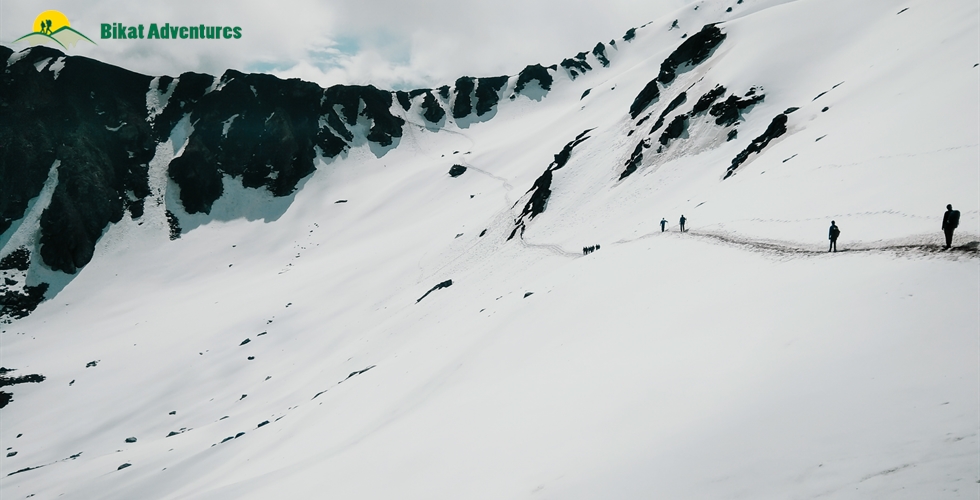
Sar Pass Trek
For all adventure souls who like snow and high mountains
Available Batches
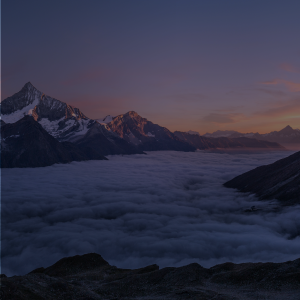
Brief Description
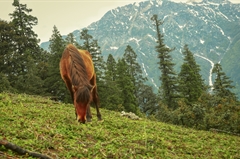
Brief Itinerary
Detailed itinerary, what's included.
- Veg Food (Day 1 Lunch till Day 5 Breakfast). Three Meals a day.
- Forest Permits/Camping Charges/Permits, Trek Permit Fee/IMF Permission (Upto the amount charged for Indian nationals).
- Camping tents, Temp rated sleeping bags, mattress
- Safety Equipment includes static rescue rope, seat harness, carabiners, pulleys
- Mountaineering course certified Trek Leader with Wilderness Emergency Responder & Rescue.
- First Aid Certified Local guide, cook, helpers
- Porters or mules for carrying common luggage
- Last day transportation from Barshaini to Kasol
What's Not Included
- Meals during road journeys
- Any kind of Insurance
- Any expense of personal nature
- Carriage of personal rucksack
- Meals during Hotel Stay
- Any expense not specified in the inclusion list
Are you Eligible for this Adventure?
Max Altitude

BRS Level Required
Sar Pass Trek is a level 3 adventure on the Bikat Rating Scale.
Although fairly easy, any kind of activity in high altitude requires a certain level of physical fitness and endurance for it to be a pleasant experience.
If you do not know what level of BRS trek would suit you best, worry not! Fill out this Form:

we will send you a progression chart to help you comfortably get out of your comfort zone in order to level up and ultimately reach your highest potential in the big, bad world of outdoor adventure.
Packing List
This is a list of essential items for individuals doing the trek with Bikat Adventures. This list contains only those items which the participants are required to bring with them. The list excludes those items which are provided by Bikat Adventures on the trek. We have divided the items into five categories. All the items in the list are essential except for those marked as optional.
Trekking Gear
- Ruck sack bag with rain cover. Qty -1
- Day Pack Bag - Recommended for treks with summit day
- Head Torch with spare Batteries. Qty -1
- U V protection sunglasses. Qty -1 Here is how you can choose the best sunglasses for trekking.
- Water Bottles: 2 bottles of 1 liter each
- Non-skid, deep treaded, high-ankle trekking shoes Qty -1
- Pair of light weight Slipper/Sandals Qty -1
- Quick Dry Warm lower or Track Pants. Qty - 2
- Full sleeves T-shirts/ Sweatshirts. 1 for every 2 days of trekking
- Pair of thick woolen socks. 1 pair for every two days of trekking
- Thermal Body warmer Upper & Lower. Qty-1
- Undergarments. Qty - 1 for every day of trekking
- Warm jacket closed at wrist & neck .Qty-1
- Full sleeves sweater. Qty -1
- Rain wear ( Jacket & Pants ) . Qty-1
- Pair of waterproof, warm gloves. Qty-1
- Woolen cap. Qty-1
- Sun shielding Hat. Qty -1
- Personal toiletries kit (Small Towel, Toilet paper, paper soap, Bar soap, toothbrush, toothpaste, cold cream, etc.)
- Sun screen lotion small pack. Qty -1 Here is your Sun Protection 101 to stay safe in the bright sunny outdoors.
- Lip Balm small pack. Qty-1
- Small size, Light weight & Leak proof lunch box. Qty-1
- Plate. Qty- 1
- Spoon.Qty-1
- Tea/Coffee (plastic) Mug.Qty-1
Miscellaneous
- Camera (Optional)
- Carry your medicines in plenty in case you have any specific ailment. Consult your doctor before joining the trek.
- Dry fruits, Nuts, Chocolate bars (Optional)
Frequently Asked Questions
Eligibility, is this adventure good for me, what’s a good fitness benchmark for this adventure, what skills do i need to complete this adventure, what is the minimum and maximum age limit, about the activity, where is it located, what are some of its highlights, what are some of its challenges, what is the best season for this, what is the accommodation type, what is the temperature like here, is it technically challenging, connectivity, how do i reach the starting point, is there cellular network available throughout, where is the nearest atm, if i choose to travel to the base with you, what is the pick-up point, what time is the drop-off on the last day, what are the nearby attractions that i can explore, equipment & gear, what equipment is provided to us, what can i rent from you, where will i receive the rented items, where do i have to return the rented items, what gear do i need to bring, are there local shops to rent/buy equipment, facilities & additional services, can i offload my bag, can i leave any extra luggage i carry at the base of this adventure, what are the meals like, what are the washroom/ toilet facilities like, what should i do if i get my period on this adventure, what are the medical facilities available to me on this adventure, are there any electricity charging points on this adventure, mandatory documents, what documents do i need to carry, do i need insurance for this, do i need a permit for this, certification, do you provide a certificate of completion, when and how will i get the certificate of completion, international travel, will i need a visa, when should i apply for the visa, what kinds of insurance do i need to travel here, what is the specialty of this when compared to other mountain ranges, till which month can i make a booking for this, what is the qualification of the outdoor leader provided to us, how do you choose your outdoor leaders, is it safe for women, what is the ratio of outdoor leader to participants, what do you do in case of an emergency, what are the rescue options on this adventure, how do you choose your equipment, can i attempt this adventure if i have a specific medical condition, sustainability, what kind of camping do you practice on your outdoor adventures, why are you against fixed camping in the outdoors, how do you manage overcrowding on certain trails, what are some things to remember when using a dry toilet, why should i avoid wet wipes in the outdoors, where should i dispose of my sanitary waste if i am on my period, why should i carry my own utensils on an outdoor adventure, booking process, what happens after i make the payment, do you create a whatsapp group of participants before the start date of the activity, do i need to submit a medical certificate, do i need to submit an undertaking form.
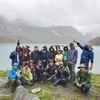
Small Group Size
Our batch sizes are capped at 15 for smaller treks with the trek leader and trekker ratio of 1:8. This ratio, in our years of experience, has proven to deliver the best trekking experience for individuals as well as groups. Capping the size of the group ensures individual attention to each trekker so that no signs of distress or need during the trek go unnoticed. It also helps to form a more cohesive cohort with better group energy which helps define the rhythm and pace of days on the trek. As you go higher up on the BRS scale, since the stakes are higher, expeditions have an even smaller group size with the ratio of expedition leader to climber set at 1:2.
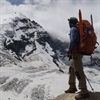
Qualified Trek Leaders
We follow a rigorous regime of hiring and training our experts in the field. Each trek leader is a certified mountaineer with years of experience in the field. In addition to their qualification, they also go through practical and situational training to tackle any and all kinds of sudden conditions that may present themselves on the ground. Being unpredictable is the core nature of the mountains but being ready for any circumstance as best as possible is a controllable asset that we try to nurture. Our field experts are also trained in basic medicine and first-aid response. Watch: Forerunners - The Making of A Trek Leader At Bikat Adventures
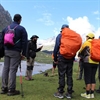
Guided Progression
Since Bikat Adventures is a learning-based organization, we help you climb up the ladder of difficulty within the sphere of outdoor adventure systematically. Our on-ground training modules are designed to handhold you through the upskilling process so that you are ready to take on bigger challenges.
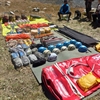
Equipment Quality and Check
All the gear used on our treks and expeditions is tried and tested, maintained for good quality, and is overall top-notch in quality and condition. We are continually looking to obtain the best of everything there is in the market so as to ensure optimum safety.
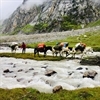
Support Systems
Along with the staff you see on-ground, we have a team of superheroes working in the background to give you the best experience possible. Our background team also comprises local staff from each area who know the region best. Having local support helps with studying the area, pre-planning, execution, and in receiving timely support in case of emergencies in these remote locations.

Communication
Our on-field staff is in constant contact with our teams based in primary locations so as to eliminate any avoidable delay in reaching additional help and support when required. We try to use the best tools for communication available, including satellite phones, in regions where they are not restricted.
What our customers Say

Cancellation Policy
Cash refund
Cancellations up to 30 days prior to departure date
5% deduction
Cancellations between 30 days to 15 days prior to departure date
50% deduction
Cancellations within 15 days prior to departure date
Voucher refund
Cancellations up to 5 days prior to departure date
No Deduction
Cancellations within 5 days prior to departure date
- Cash refund is applicable only in case of bookings made without using any promotional offer code or vouchers
- This is only a brief of cancellation terms. For finer details please refer Detailed Cancellation Policy.
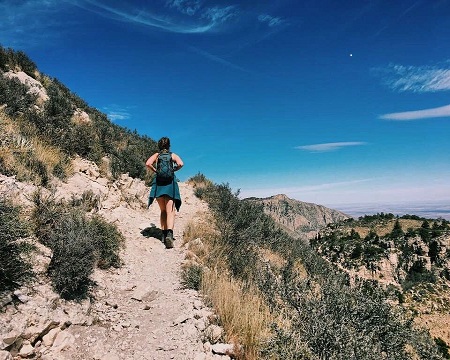
Subscribe for latest updates & offers
Similar adventures.
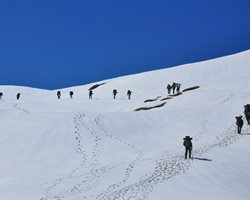
Panwali Kantha Trek
Uttarakhand
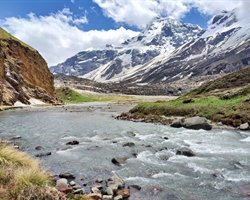
Dev Kyara Trek
Hidden gem of uttarakhand.
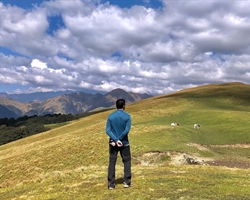
Ali Bedni Bugyal Trek
The next chapter of roopkund, enter your email, events by categories.

Mountaineering

Scuba Diving
Events by months.
- January July
- February August
- March September
- April October
- May November
- June December
Events By Nights
- 5 & More Night
- Environmental Policy
- Privacy Policy
- Term & Conditions
- Work With Us
- Address: 303, 3rd Floor, Tower B4, Spaze Itech Park, Sector 49. Gurgaon
- Pre Sale - 7838148127 , Post Sale - 8588878499, 9667639126
Bikat Adventures
- Cancellation & Refunds
- Content Sharing
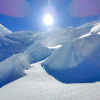
© 2024 Bikat Adventures - All Rights Reserved
Powered by: novel knett software solutions, submit enquiry.
Sar Pass Trek
🗓 Best Time To Visit: May to October
⏰ Open Hours: N/A
🏞 Things To Do: Trekking, Photography, Camping, Nature Walks
💰 Budget: INR 8000 to 12000 for guided treks
🧳 Traveller Types: Adventure Seekers, Nature Lovers, Photographers
🔍 Known For: Snow-capped peaks, Meadows, Dense Forest, Breathtaking views
🚉 Distances: Kasol to Bhuntar Airport (31.2 km), Kasol to Joginder Nagar Railway Station (144.8 km), Kasol to Manali (74.6 km)
🧗♀️ Trek Difficulty: Moderate
🏔 Trek Altitude: 13,800 ft
🚶♂️ Trek Duration: 4 to 5 days
🌡 Weather: Pleasant in summers (10-25°C), Cold in winters (-10 to 10°C)
Are you looking for a thrilling and scenic trek in the Himalayas? Do you want to experience the beauty and diversity of nature, culture, and adventure in one trip? If yes, then you should definitely consider the Sar Pass Trek in Kasol, Himachal Pradesh, India.
The Sar Pass Trek is one of the most popular and rewarding treks in the Parvati Valley. It takes you through lush green forests, alpine meadows, snow-capped mountains, and sparkling streams. You will also get to witness the charming villages, friendly locals, and rich traditions of the region. The Sar Pass Trek is a perfect blend of challenge and fun for anyone who loves nature and trekking.
In this article, we will provide you with a complete guide to the Sar Pass Trek, covering everything you need to know before you embark on this Himalayan adventure. So, let’s get started!
How to Reach
The starting point of the Sar Pass Trek is Kasol, a small and picturesque town in the Kullu district of Himachal Pradesh. Kasol is also known as the mini-Israel of India, as it attracts a lot of Israeli tourists and backpackers. Kasol is famous for its cafes, markets, and hippie vibe.
To reach Kasol, you have several options depending on your mode of transport. Here are some of them:
The nearest airport to Kasol is Bhuntar Airport , which is about 31 km away. You can take a flight from Delhi or Chandigarh to Bhuntar Airport and then hire a taxi or take a bus to Kasol. The flight duration from Delhi to Bhuntar is about 1 hour and 20 minutes, while from Chandigarh it is about 45 minutes. The taxi fare from Bhuntar to Kasol is around Rs 1000-1500, while the bus fare is around Rs 50-100.
The nearest railway station to Kasol is Joginder Nagar Railway Station, which is about 144 km away. You can take a train from Delhi or Chandigarh to Joginder Nagar Railway Station and then hire a taxi or take a bus to Kasol. The train duration from Delhi to Joginder Nagar is about 10 hours, while from Chandigarh it is about 6 hours. The taxi fare from Joginder Nagar to Kasol is around Rs 3000-4000, while the bus fare is around Rs 200-300.
You can also reach Kasol by road from Delhi or Chandigarh by taking a private car or a bus. The road distance from Delhi to Kasol is about 517 km, while from Chandigarh it is about 268 km. The road journey from Delhi to Kasol takes about 12 hours, while from Chandigarh it takes about 7 hours. The car rental cost from Delhi or Chandigarh to Kasol is around Rs 8000-10000 per day, while the bus ticket cost is around Rs 800-1200 per person.
The Sar Pass Trek is a 5-day trek that covers a total distance of 48 km. The trek starts from Kasol and ends at Barshaini Village. The trek passes through several beautiful places such as Grahan Village, Mung Thach Campsite, Nagaru Campsite, Sar Pass Top, and Biskeri Thach Campsite. Here is the detailed day-wise description of the Sar Pass Trek itinerary:
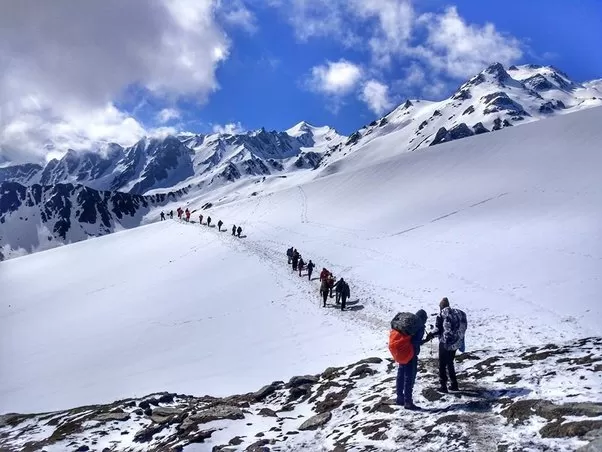
Day 1: Kasol to Grahan Village (10 km | 5 hours | 7700 ft)
The first day of the trek begins with a short drive from Kasol to the trekking point near Parvati River. From there, you will start walking along the river bank, crossing several bridges and enjoying the views of the valley. You will also pass through some apple orchards and pine forests on your way.
After about 4 hours of trekking, you will reach Grahan Village, which is your first campsite for the night. Grahan Village is a quaint and colorful village that is home to the locals of the Parvati Valley. You will get to interact with them and learn about their culture and lifestyle. You will also get to taste some of their delicious local cuisine for dinner.
Also check out: Sar Pass: Reminiscing my first trekking trip
Day 2: Grahan Village to Mung Thach Campsite (7 km | 5 hours | 11200 ft)
The second day of the trek starts with a steep ascent from Grahan Village to the higher altitudes of the valley. You will trek through dense forests of rhododendron, oak, and deodar trees, which are full of birds and animals. You will also encounter some snow patches as you climb higher.
After about 5 hours of trekking, you will reach Mung Thach Campsite, which is your second campsite for the night. Mung Thach Campsite is a flat and open meadow that offers stunning views of the snow-capped peaks and the valley below. You will also get to witness a spectacular sunset and a starry night from here.
Day 3: Mung Thach Campsite to Nagaru Campsite (7 km | 6 hours | 12500 ft)
The third day of the trek is the most challenging and rewarding one, as you will trek to the highest point of the Sar Pass Trek, which is Nagaru Campsite. You will trek through some steep and slippery slopes, rocky terrains, and narrow ridges, which will test your stamina and skills. You will also cross some frozen streams and snowfields, which will add to the thrill and fun.
After about 6 hours of trekking, you will reach Nagaru Campsite, which is your third campsite for the night. Nagaru Campsite is a small and windy patch of land that overlooks the majestic mountains and the valley. You will also get to see a breathtaking sunrise and a panoramic view of the Sar Pass from here.
Day 4: Nagaru Campsite to Sar Pass Top to Biskeri Thach Campsite (14 km | 8 hours | 13800 ft)
The fourth day of the trek is the most exciting and memorable one, as you will trek to the Sar Pass Top, which is the ultimate destination of the Sar Pass Trek. You will trek through some steep and snowy slopes, which will require some caution and guidance. You will also experience some adrenaline rush as you slide down some snow slopes, which will make you feel like a child again.
After about 4 hours of trekking, you will reach Sar Pass Top, which is the highest point of the Sar Pass Trek at an altitude of 13800 ft. Sar Pass Top is a narrow pass that connects the Parvati Valley with the Tosh Valley. You will get to see a magnificent view of both the valleys and the surrounding peaks from here. You will also feel a sense of achievement and pride as you hoist the Indian flag and take some photos at the Sar Pass Top.
After spending some time at the Sar Pass Top, you will descend to Biskeri Thach Campsite, which is your fourth campsite for the night. Biskeri Thach Campsite is a large and green meadow that offers a contrast to the snow-covered landscape you have seen so far. You will also get to see some beautiful flowers and grasses here.
Day 5: Biskeri Thach Campsite to Barshaini Village (10 km | 4 hours | 8000 ft)
The fifth and final day of the trek is an easy and relaxing one, as you will trek downhill from Biskeri Thach Campsite to Barshaini Village. You will trek through some pine forests, waterfalls, and villages, which will give you a glimpse of the rural life of Himachal Pradesh. You will also pass by some famous attractions such as Tosh Village, Kalga Village, Pulga Village, and Manikaran Sahib.
After about 4 hours of trekking, you will reach Barshaini Village, which is the end point of the Sar Pass Trek. Barshaini Village is a small and lively village that is situated at the confluence of Parvati River and Tosh River. You will take a bus or a taxi from Barshaini Village to Kasol, where you can celebrate your successful completion of the Sar Pass Trek with your fellow trekkers.
Price and Booking
The price of the Sar Pass Trek varies depending on several factors such as season, group size, operator, inclusions and exclusions, etc. However, on average, you can expect to pay around Rs 10000-15000 per person for a 5-day Sar Pass Trek package.
Things to Carry
The things to carry for the Sar Pass Trek are very important, as they can make or break your trekking experience. You should pack wisely and efficiently for the Sar Pass Trek, keeping in mind the weather conditions, altitude changes, and duration of the trek. You should also carry only the essential items that you need for the trek and avoid any unnecessary or extra items that can add to your weight and hassle.
Here is a list of essential items that you should carry for the Sar Pass Trek. We have categorized them into mandatory and optional items for your convenience.
Mandatory Items
Clothing: You should carry warm layers, waterproof jacket, fleece jacket, thermal wear, trekking pants, woolen socks, gloves, cap, sunglasses, etc. You should also carry a change of clothes for each day of the trek and avoid cotton clothes as they can get wet and cold easily.
Footwear: You should carry sturdy trekking shoes with good grip and ankle support. You should also carry spare sandals or slippers for campsite use.
Accessories: You should carry a backpack with rain cover, trekking poles, water bottle or hydration pack, headlamp or torch, power bank or solar charger, camera or phone, etc. You should also carry some plastic bags or ziplock bags to store your wet clothes or trash.
Toiletries: You should carry sunscreen lotion, lip balm, moisturizer, wet wipes, sanitizer, toilet paper, towel, soap, toothbrush, toothpaste, etc. You should also carry some biodegradable products to minimize your environmental impact.
Personal medication: You should carry prescription medicines if any, painkillers, anti-allergic pills, anti-diarrhea pills, oral rehydration salts, band-aids, antiseptic cream, etc. You should also consult your doctor before the trek and carry a medical certificate or fitness certificate if required.
Documents: You should carry valid ID proof such as Aadhar card or passport, trekking permit or forest entry fee receipt, insurance policy if any, etc. You should also carry some cash for emergency use.
You may also like to check out: SAR PASS: Trek to the Himalayas
Optional Items
Snacks: You can carry some snacks such as chocolates, dry fruits, energy bars, cookies, etc. to munch on during the trek. They can help you boost your energy and morale.
Books: You can carry some books such as novels, magazines, comics, etc. to read during your leisure time at the campsite. They can help you relax and unwind.
Games: You can carry some games such as cards, chess, ludo, etc. to play with your fellow trekkers at the campsite. They can help you bond and have fun.
Music: You can carry some music such as songs, podcasts, audiobooks, etc. to listen to during your trek or at the campsite. They can help you enjoy and motivate yourself.
Best Time To Visit
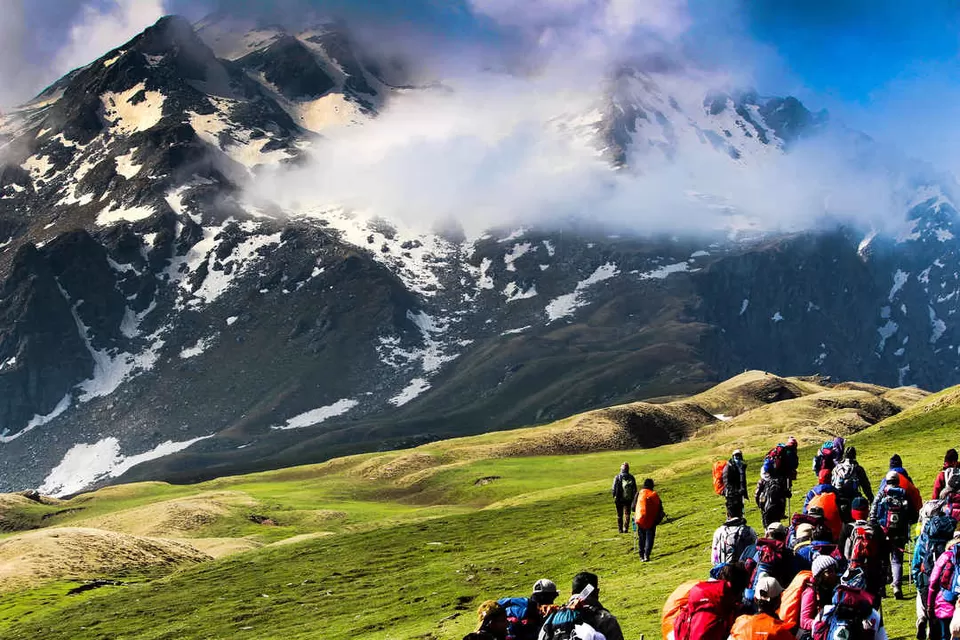
The best time to visit the Sar Pass Trek is from May to October , as the weather is pleasant, the skies are clear, and the views are breathtaking. You can enjoy the beauty and diversity of nature, culture, and adventure during these months. However, you should also check the weather forecast before starting the trek, as the weather conditions can be unpredictable in the mountains.
The Sar Pass Trek is a complete guide to the Himalayan adventure that you have been dreaming of. It is a trek that will challenge you, thrill you, and reward you with unforgettable memories and experiences.
You will get to see the beauty and diversity of nature, culture, and adventure in one trip. You will also get to learn and grow as a trekker and a traveller.
Don’t miss this opportunity to explore the Himalayas like never before. Book your Sar Pass Trek with Tripoto now and get ready for the adventure of a lifetime!
Sar Pass Trek Reviews

Places To Visit In Himachal Pradesh
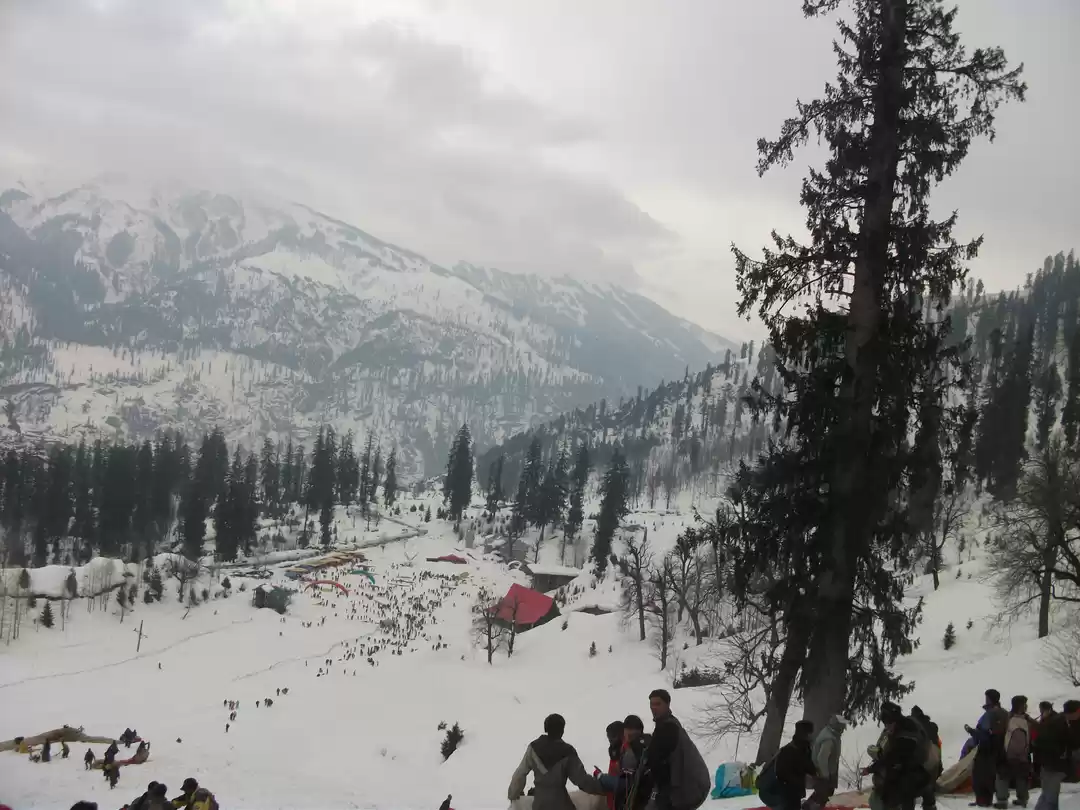
Travel Blogs for Sar Pass Trek
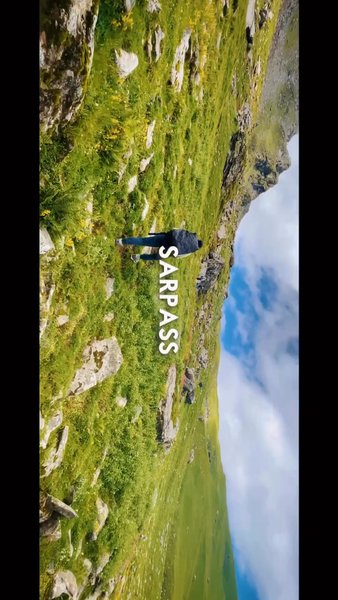

- Call Us +91 94590-18019 / 9816682570
- Mail Us [email protected]

Special Offer
Search Your package
Have A Query!
sar pass trek
5 days/4 nights, 16°c to 3°c, himachal pradesh, fixed departure dates sar pass trek.
- Date: 01 May to 05 May Available
- Date: 02 May to 06 May Available
- Date: 03 May to 07 May Available
- Date: 04 May to 08 May Available
- Date: 05 May to 09 May Available
- Date: 06 May to 10 May Available
- Date: 07 May to 11 May Available
- Date: 08 May to 12 May Available
- Date: 09 May to 13 May Available
- Date: 10 May to 14 May Available
- Date: 11 May to 15 May Available
- Date: 12 May to 16 May Available
- Date: 13 May to 17 May Available

Package Price
Sar pass trek - trekking near kasol.

The Sar Pass is located 14,000 feet above sea level. It is one of Himachal Pradesh's simpler treks. For this Trek in Himachal, no prior experience is necessary. The Sar Pass walk begins in Kasol and concludes in the Kullu valley at Barshaini.
A 48 km Trek leads to Sar Pass in Himachal Pradesh. The trekking routes pass through pine forests, snow-covered mountains, stunning meadows, and some of the most breathtaking scenery. The Sar Pass hike allows you to discover the Himalayas' untamed and unusual flora. A sight to be noticed is pink rhododendrons painting the paths at numerous locations
One of the best hikes for novice hikers is the Sar Pass trip. Sar is the native word for lake. Because hikers must pass via a glacier lake, this journey is called Sar Pass. The Sar Pass hike is located in Himachal Pradesh's Parvati valley. Trekkers can experience a variety of landscapes along the Sar Pass trekking trail, including woods, adorable villages, meadows, and snow-capped mountains.
You can take in the beautiful vistas of the stunning snow-capped peaks on the Sar Pass hike. The journey to Sar officially begins in Kasol, a town renowned for its lovely evergreen forest and mountain streams. The Sar Pass walk is rated as simple to moderate in difficulty.
This walk is appropriate for families, school groups, and beginners. This Trek is simple to complete the first time.
Best Time To Visit Sar Pass Trek:
May through October are ideal for the Sar Pass walk because the skies are clear, and you can enjoy a breathtaking panoramic vista. The weather is erratic from October through December, and the paths will be heavily snowed. Therefore, the walk is typically not organized by companies at this time.
Short Itinerary
Day 00: arrival in kasol:, day 01: kasol to grahan village:, day 02: grahan to min thach:, day 03: min thach to nagaru:, day 04: nagaru - sar pass - bishkeri:, day 05: bishkeri to barshaini to manikaran/kasol:, detail itinerary.
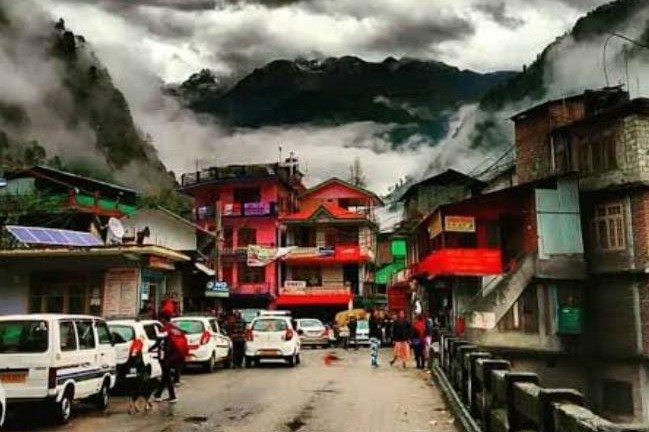
Day 00: Entry into Kasol
Once you get to Kasol, book a hotel, a homestay, or camping. You can stroll around, go shopping, make trip preparations, or even go to Manikaran.
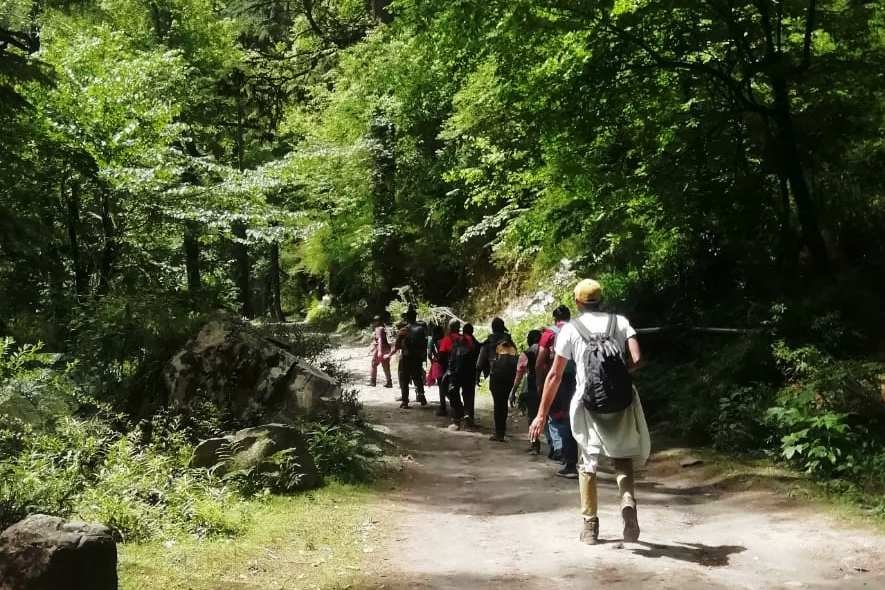
Day 01: Kasol to Grahan village
- Altitude: 1,700 m to 2,350 m
- Distance: 10 km
- Time taken: 4-5 hours
We will begin the trip from Kasol after a quick breakfast. The walk passes through waterfalls, streams, and dense, beautiful forests. The trail is easy at first, but soon it will encounter difficulties, including a rocky, steep road and a crossing of the Grahan Nallah. The trail gets steep as we move closer to the Grahan Settlement, and we can see the village.
The Rhododendron trees encircle the campsite in Grahan, which is close to the hamlet. The settlement of Grahan is hundreds of years old. Near the camp are charming traditional homes where one can spend lovely evenings and capture locals on camera.
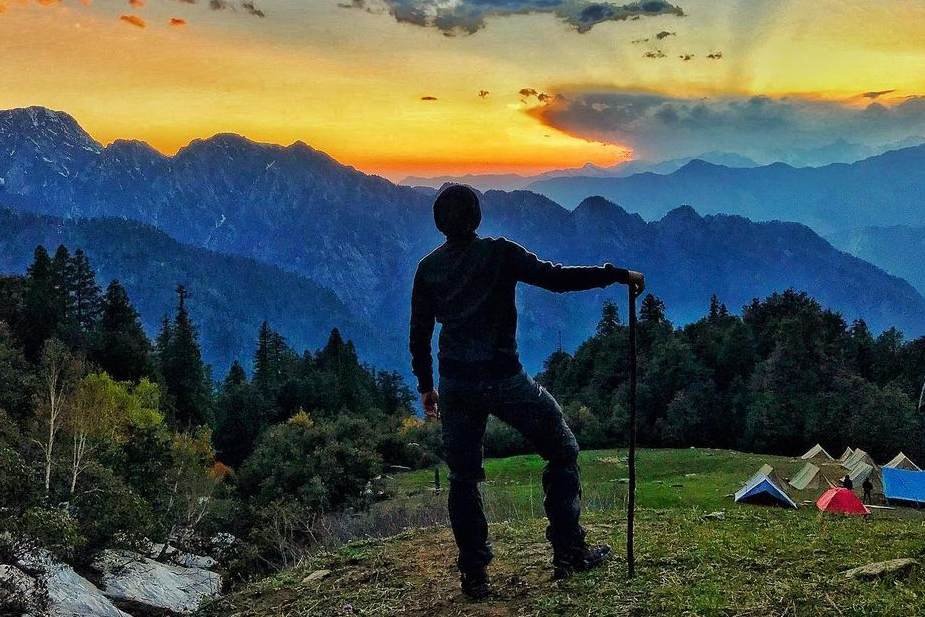
Day 02: Grahan to Min Thach
- Altitude: 2,350 m to 3,400 m
- Distance: 7 km
After breakfast, we will continue our 7-hour trip from Grahan to Min Thach (our next campsite). The residents typically transport their animals to higher pastures along the trail to Min Thach. The route has various plants and animals, including birds, insects, etc. The trail gets steeper and enters the trees as we climb higher.
A meadow-like area of land is accessible from the forest's trail. The flat rocks surround the mound on which the Min Thach is situated. This camp has beautiful sunrises and sunsets.
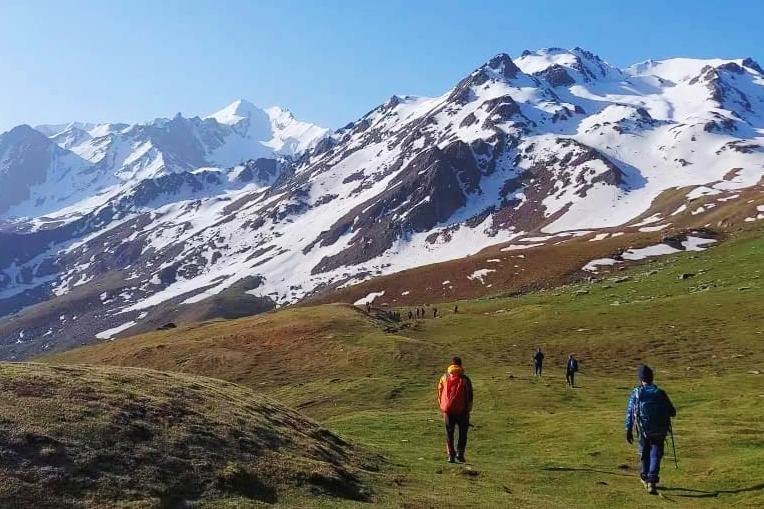
Day 03: Min Thach to Nagaru
- Altitude: 3,400 m to 3,800 m
- Distance: 8 km
- Time taken: 4-6 hours
We will continue our hike to Nagaru after an early breakfast. The route to Nagaru is moderately challenging and time-consuming as it ascends through pastoral woodlands to snow-covered meadows. As you climb higher, the air gets thinner, and you may experience mild symptoms of altitude sickness, such as headache and lightheadedness. Do as instructed by your trek leader or guide, and continue to drink enough fluids to prevent AMS.
Heights. Due to the blustery winds, it is the coldest campsite of the entire walk. At night, the temperature might fall below zero. One would enjoy breathtaking views of majestic mountains across the Parvati Valley once they arrived at the Nagaru campground. At this lovely campsite, take in the sunset's colorful painting of the sky and the starry night.
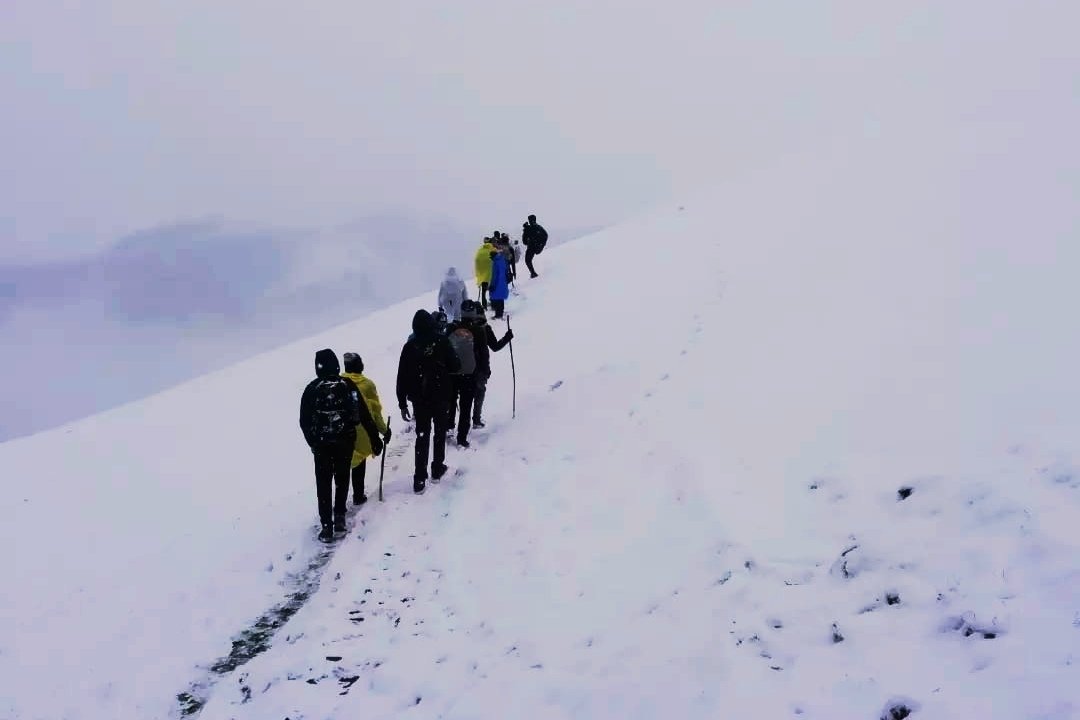
Day 04: Nagaru - Sar Pass - Bishkeri
- Altitude: 3800-4200-3350 meters above sea level
- Distance: 14 km
- Time taken: 6-8 hours
The longest and most important day of the Sar Pass Trek is today. We will begin our uphill, snow-covered walk after an early-morning breakfast. The trail is easy after ascending the Nagaru Ridge. A breathtaking view of Parvati valley's lovely meadows and soaring hills may be had by climbing higher to the pass. When you reach the summit of the Sar Pass, you can enjoy the delight of seeing the trail below and the impressive snow-capped peaks of the Himalayas. One might take their picnic lunch and spend some time at the Sar Pass snapping pictures.
The most excellent part of this walk is a terrific slope that is perfect for sliding after the pass and takes one a kilometer far in a matter of minutes. After that, continue your hike till you reach Bishkeri Thach by descending on softer slopes through rhododendron woods. The lush green meadows, wildflowers, and variety of birds at Bishkeri can re-energize your body and mind after a long, exhausting day. You will spend the night at the Bishkeri campground.
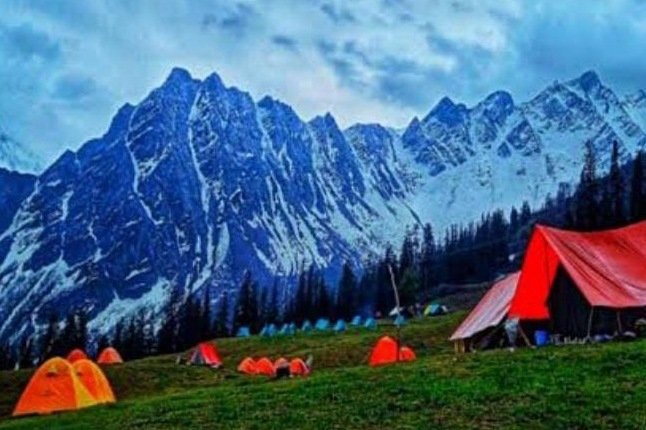
Day 05: Bishkeri to Barshaini to Manikaran/Kasol
- Altitude: 3,350 m to 2,400 m
are both uphill and downhill sections of the path from Bishkeri to Barshaini. On this route, one must take each sloped step with caution. Once more, moving slowly and steadily will make it easier to approach the road ahead. The trail will pass by numerous small creeks. You will arrive at Pulga village after a few hours of beautiful jungle trekking. After that, take a short walk to Tulga village. To get to Barshaini, cross the Parvati River and then continue climbing for a while. You can take a taxi or a bus from Barshaini to Manikaran/Kasol.
Inclusion And Exclusion
Inclusions:- .
- From Day 1 to Day 4, all stays will be in shared tents.
- All meals are provided from Day 1 Lunch through Day 5 Breakfast. All of Trek's meals will be vegetarian.
- Knowledgeable local workers who are skilled and familiar with the route.
- While on the Trek, restrooms, dining, and kitchen tents will be used.
- Cooks and helpers for lugging supplies like food, tents, utensils, and groceries
- Transportation from Barshaini to Kasol on Day 5
- All hike necessities are provided
- Accommodations: sleeping bags, mats, tents, etc.
- Safety gear includes a portable oxygen cylinder, micro spikes, gaiters, and a basic first aid kit.
- Permit with camping and forest fees included.
Exclusions:-
- Stay in Kasol.
- The GST taxes (5%) are not included in the Trek as mentioned above costs.
- Requirements for oneself
- Gear, such as trekking poles and gumboots
- nsurance - Personal and travel insurance
- Beverages: Mineral water bottles and other bottled or tinned drinks
- Snacks: protein or nutrition bars, chocolate, dry fruits, or dry fruit.
- Amusement - Camera or drone fees
- decisio Once you reach the beginning point of your Trek, you will not be eligible for a refund, rescheduling, or replacement for any services that you have not used due to "force majeure" or personal decision.
- The guest will be responsible for paying any additional expenses brought on by modifications to government guidelines for travel, expeditions, or COVID-19.
- Anything that needs to be listed as being included.
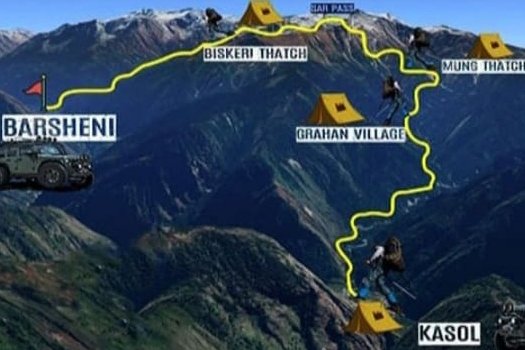
Fitness Required
Essential things to carry, things to be carried for sar pass trek.
- Jeans / trekking pants /2/3, Shirts / T-shirts /2/3
- A decent-quality windproof jacket (no flimsy windcheaters, please!) preferred to have a hood
- A wool sweater with full sleeves and a warm fleece.
- Thermal inner clothing (upper and lower), a scarf, and a muffler (optional)
- Wool socks, a wool cap, wool gloves, and ordinary socks (3-4 pairs)
- Comfy hiking or trekking shoes (Waterproof shoes with a thick sole are recommended)
- Lightweight slippers, sandals, and floaties
- Use a Poncho or raincoat small towel to dry quickly
- A strong water bottle (no empty Bisleri bottles, please).
- Cap or hat to shield your face from the harsh sun
- Polarized/UV-protective sunglasses, a trekking pole and a walking stick
- A torch or flashlight, lip balm, and sunscreen lotion (with extra batteries)
- Medication, if a specific prescription is needed
- Personal care products
- Hand Sanitizer
Frequently Asked Question
Q: Is the Sar Pass hike simple?
A: The Sar Pass is located 14,000 feet above sea level. It is one of Himachal Pradesh's simpler treks. For this Trek in Himachal, no prior experience is necessary.
Q: Is the trek to Sar Pass worthwhile?
A: Beginners also can choose the trek to Sar Pass. It is suitable for individuals who desire to explore various terrains. This trail provides hikers with a variety of experiences, including forests, meadows, cute villages, and snow-capped mountains.
Q: Can we trek to Sar Pass alone?
A: Yes, with help from Kasol, you may complete Sar Pass independently. The price is less high if there are 5 to 10 people at your party, but the cost increases if you travel alone with a guide.
Q: What are the allowed ages, both minimum and maximum?
A: The age requirement is nine years old. However, children between the ages of 9 and 17 should travel with a parent or legal guardian. If you are above 60, kindly bring a doctor's note stating that you are well enough to engage in adventurous activities like hiking.
Our Terms & Conditions
At Broza Adventures, we are glad to take you on our adventurous trips. When it comes to booking tickets, please make sure that you read the below-given Terms and Conditions so that there is confusion in the future.
You can book your tickets with us over email, telephone, or simply by online transaction through our website. However, before making any payment make sure that you reach out to us to confirm that there is gladly available for you in the team.
Terms and Conditions:-
• Booking form- While filling up the application form, make sure you provide all the details correctly which should be complete and true.
• Late Booking of the tickets- There is no extra charge for late booking but you have to make your payment in full while you are looking for any of the trips with Broza Adventures.
• Payment and deposit money- Along with the booking application form, you will have to make a payment of 25%of for the trip per person. The balance money can be paid once on the arrival or before departure. The money shall be sent through bank transfer to our account, the details of which will be provided to you.
• Booking confirmation - Once we have received your advance money, we will reserve your seat on our team and we will make all the necessary arrangements for the trip and send you the confirmation in writing.
• Changes in information
In case there is any change that affects the information that you have provided in the application form then you must immediately inform us through mail or telephone. Failure to do so may result in the levy of extra charges by the government authorities which should be borne by you.
• Baggage and Luggage
We always advise the trekkers and travelers to carry as less things as possible as it makes your trip super smooth and easy. You should make all your efforts to make sure that your baggage weight does not cross 15kg. In case you carry more than the prescribed limits then you shall be responsible for the extra charges of the porter.
• Forced Cancellation
In case there is any war, riot, or dispute in the country or any terrorist attack, abnormal weather conditions, or natural disaster then in that case we will have to change or even cancel your travel arrangements and we will not pay you the compensation for the same.
• Cancellation Charges and refund policy
In case you want to cancel your bookings then it must be communicated to us in writing. However, if you are canceling your trekking booked by you before the period of 30 days of trekking then there will be a 5% deduction from the total cost tour.
If you are canceling the trek between 15-30 of the trekking date then 50% of the amount shall be deducted.
In case of cancellation in less than 15 days of the trek then there will be no cash refund from our side.
• Self-responsibility
We accept your booking on the assumption that you are physically and mentally prepared for trekking and other adventurous activities. You must accept all the risks that may be involved. In case of any medical conditions or any serious ailment, you must inform us before the booking. We reserve the right to refuse your booking in case your medical conditions are really serious.
• Insurance
We at Broza Adventures, expect that you are covered by proper insurance during the time of your trip with us. Please make sure that your insurance policy includes medical expenses, injury expenses, or even death.
• Problems or Complaints
In case you face any problem or if you have any complaint during the trip then you can at any time inform this to our leaders who will be leading you and your problems will be solved without any delay.
All the interested trekkers are expected to read the above-mentioned terms and conditions properly and understand them properly before paying the trekking fee. During the road journey and other adventure treks, the participants are advised to follow all the safety measures as will be mentioned by our team. Also, you must take care of all the equipment that is issued to you by Broza Adventures at the start of the journey, failing which you will be liable for the losses.
You can also reach out to us in case you want any more information regarding the trek.
What our participants say about sar pass trek
- Date: 01 May to 05 May Available
- Date: 02 May to 06 May Available
- Date: 03 May to 07 May Available
- Date: 04 May to 08 May Available
- Date: 05 May to 09 May Available
- Date: 06 May to 10 May Available
- Date: 07 May to 11 May Available
- Date: 08 May to 12 May Available
- Date: 09 May to 13 May Available
- Date: 10 May to 14 May Available
- Date: 11 May to 15 May Available
- Date: 12 May to 16 May Available
- Date: 13 May to 17 May Available
Rate Us On Google / Click to read 250+ Reviews.
Other Treks Like sar pass trek
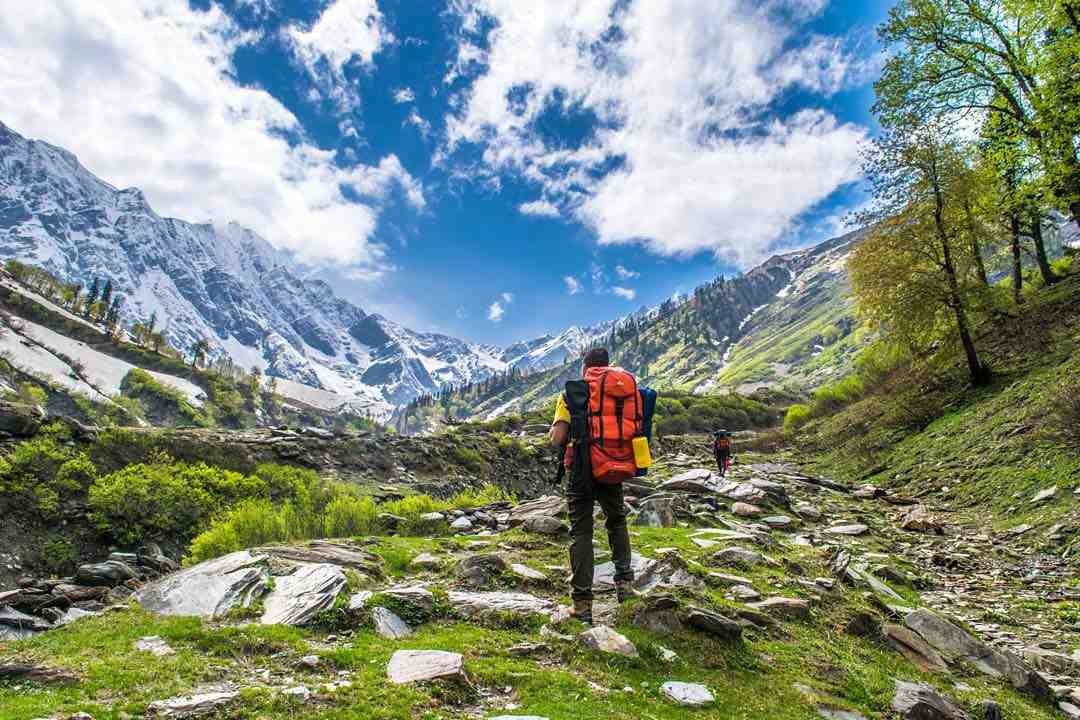
beas kund trek
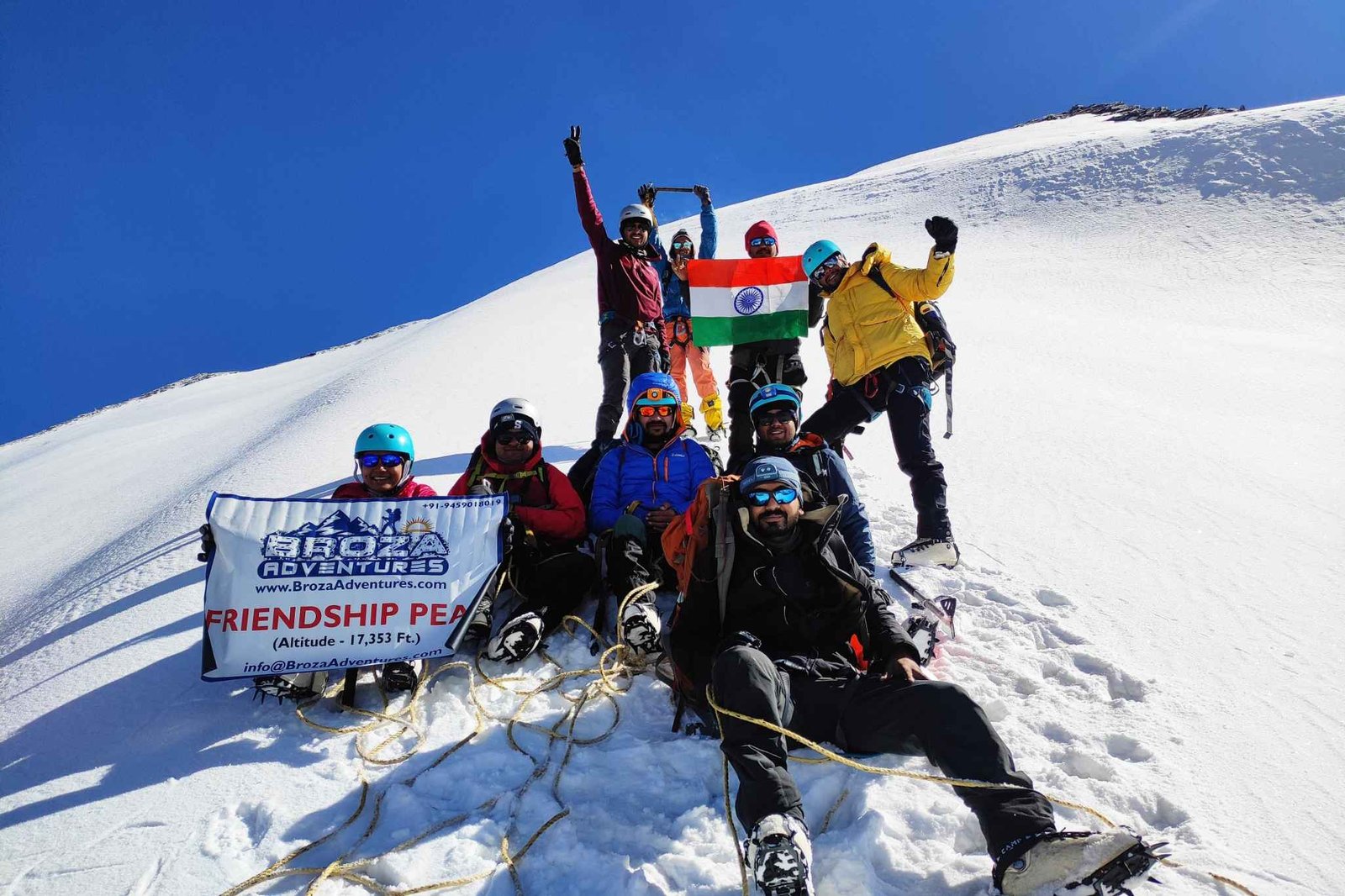
friendship peak expedition
Mount Friendshipp Peak in Manali becoming more famous for experience trekkers and beginners, this Expedition wil

rani sui lake trek
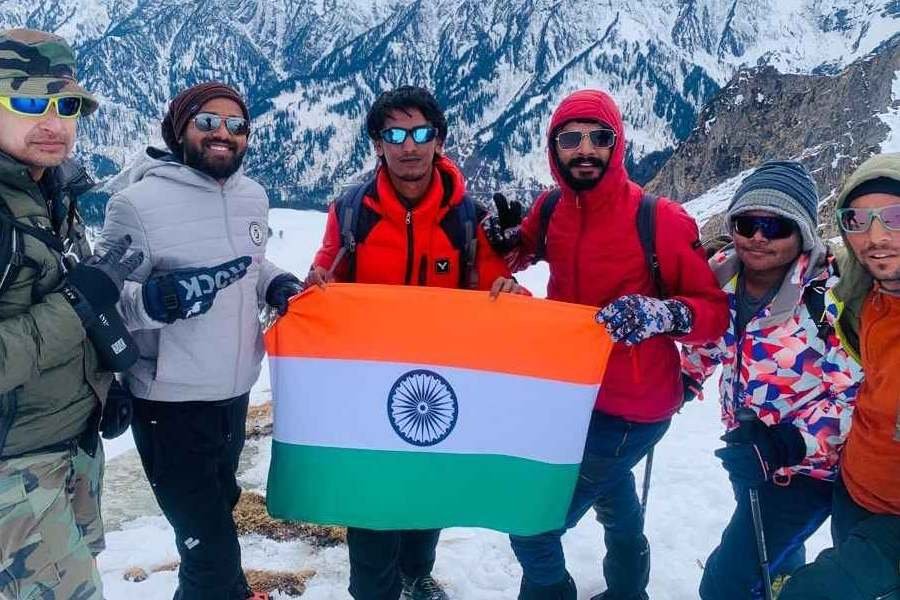
patalsu peak trek


Discover the beauty of the Himalayas through the Sar Pass Trek
Table of Contents
The time to cover the Sar Pass trek will take around 7 km distance and would take around 4 or 5 hours maximum. There are unique alpine trees that make the Sar Pass trek a beautiful one. The beautiful scenario of the Sar Pass trek is astonishing and every trekker must visit the Sar Pass trek by Goatourisum . During winters these green grasslands get transformed into breathtaking snow-covered grasslands and this place is best for monsoon.
Views from the summit of the sar pass trek.
When you reach the top of the Sar Pass trek then you can see a close view of the summits or peaks of the Himalayan mountains. The trek would take 4 to 5 days maximum for a medium-level trekker to complete. Though the Sar Pass Trek is a high-altitude lake trek, one can reach and enjoy the Sar Pass trek by easy or moderate trekking.
So, one day one can complete the Sar Pass trek. Consumption of alcohol is strictly prohibited in Graham Village. Mobile connectivity is intermittent in the Graham village and it is better to make your phone calls before beginning the trek. The climb to Moon Touch Camp starts towards the north of the grand campsite. Multaj campsite is important because it is the first to be fully excluded from civilization and unlike Graham into a zero network zone.

Scenario of the Sar Pass Trek
The dense forest is covered with silver birch oak and alpine trees with the sound of chirping birds. After crossing the forest you will move to Multaj campsite. It is a campsite that is placed on the patch of the mountain which is surrounded by many trees, free and open, vast and spacious. It truly offers a charming camping experience. A Cup of warm tea with friends is all you need to experience the beauty of the Himalayan ranges surrounding the campsite.
Exploring the beauty of the Sar Pass trek
The Sar Pass trek offers an absolute fling and is recommended for beginners and moderate-level trekkers. The routes of this Sar pass trekking enrich through the scenic views of green meadows with snow patches everywhere. The Sar Pass trekking originates from Kasol to Grahan village then to M multaj then to Nagaru and lastly to Biskeri to Barshaini.

Adventure of the Himalayas through the Sar Pass trek
The first route of this trek starts from Kasol to Grahan . Kasoo is a Himalayan hotspot for trekkers and backpackers and acts as a base for lots of amazing treks like the Sar Pass and Parvati Pass. The trek route originates from the castle and ends at four shires comprising four campsites in between. Graham Village is the first campsite.
The trail from the castle to Graham’s village goes through a lonely pine forest coupled with rocky terrain. After Graham Nala the trekking trail becomes quite appealing and goes deep into the forest away from the right bank of the river Burus also known as Lodendrons crows in the forest here. Graham is a beautiful village located at the height of 7700 feet and has around 50 houses with a population of 50 to 400 villagers.
Detailed guide of the Sar Pass trek
Consumption of alcohol is strictly prohibited in Graham Village. Mobile connectivity is intermittent in the Graham village and it is better to make your phone calls before beginning the trek. The climb to Moon Touch Camp starts towards the north of the grand campsite. Multaj campsite is important because it is the first to be fully excluded from civilization and unlike Graham into a zero network zone.
Are you looking for the best events in London? Here you find the best London Events Guide .

Best time for the Sar Pass trek
Summer season(may to june).
Summer months are best to plan the Sarr pass trek, the weather is pleasant during this time. This temperature remains mild during the day and the temperature falls during night time. During summer months the trails are clear of snow which makes the trekking experience easier. You can witness the blooming meadows, vibrant landscapes, and wonderful views.
Monsoon season(July to August)
It is advised to plan a trek during the monsoon season, during this time there is heavy rainfall in this region which can make it dangerous for trekkers. During monsoons, chances of landslides and floods increase and the trails also become slippery.
Post-monsoon season (September to October)
T he post-monsoon season is ideal for trekking as the monsoon makes the landscapes lush green again. You’ll not find much crowd as compared to the summer months. You can also witness vibrant blooming flowers on the trail of Sar Pass Trek. By the end of October, the temperature starts to drop during the night as the winter is coming so, you should prepare yourself according to chilly weather.

Sar pass trek difficulty level
The Sar Pass trek is rated moderately tough; hence it is recommended for people with earlier high-altitude trekking experience. The trail offers a variety of terrains comprising steep uphill and downhill sections and the possibility of snow along the way. In addition, the trail requires a high level of physical fitness and endurance.
Hikers should only acclimatize properly in the increasing altitude and that is over 13,000 feet. The weather is changeable and the terrain can be tough, thus one needs to be observant. Sar Pass trek is ideal for intermediate hikers yet it is not suitable for enthusiastic beginners. Partakers of this trek will not only enjoy the breathtaking scenery but also a sense of accomplishment and a touch of wild Himalayan landscape.
The trekking trail becomes steeper and leads into the woods and the path is confusing in some places. There are plenty of lovely spots among the trees with a nice shelter which makes you feel lost within the dense forest. One thing that adds charm to the trek is that so many birds of different kinds at Tali campsite sing in the pine forest on the first morning which is like an orchestra for the city dwellers. Many landscapes open to the mountains, which makes the adventure of the Sar Pass Trek very exciting.
Like it? Pin it here⇓! Follow us in Facebook , Twitter and Instagram !

Hi, we are Krasen and Ying Ying. Krasen is from Bulgaria, and Ying Ying is from China. We are passionate about geography and history, and we believe that the best way to experience it is by exploring the Earth in reality, not in a school, and not virtually.
So, we created this blog Journey Beyond the Horizon, where we share geographical knowledge, travel guides and tips how to experience it when you explore our planet, and a lot of inspiration.
And we wish you a happy journey, not just virtually, but most of all- in reality.
Related Posts

A journey to Tagong and its grasslands- a green paradise in Eastern Tibet, China

Discover Yilhun Lhatso in Chola Mountain- a fantastic hidden gem in Eastern Tibet
Leave a comment cancel reply.
Your email address will not be published. Required fields are marked *
Username or E-Mail
Forget Password?
Do not have an account?
Already a member.

- Benog Tibba Trek
- Bhadraj Forest and Temple
- Pari Tibba Trek
- Chhaskhet Nature Walk
- George Everest Nature Walk
- Mussoorie Walking Tour
- Mussoorie Heritage Walk – Landour Cantt
- Mussoorie Heritage Walk – Old Landour Bazaar
- Mussoorie Heritage Walk – Kulri & Camel`s Back
- Day Treks Near Mussoorie
- Day Trips from Mussoorie
- Jogini Waterfall Trek
- Shimla Day Hikes
- Nag Tibba Trek
- Chandrashila Trek
- Chopta Tungnath Chandrashila Trek
- Deoria Tal Chandrashila Trek
- Hatu Peak Trek
- Dalhousie Trek
- Triund Trek
- Kheerganga Trek
Kasol to Grahan Village trek
- Kedarkantha Trek
- Har Ki Dun Trek
- Valley Of Flowers Trek
- Bali Pass Trek
- Dodital Trek
- Ruinsara Tal Trek
Sar Pass Trek
Buran ghati trek.
- Hampta Pass Trek
- Gulabi Kantha Trek
- Panwali Kantha Trek
- Roopkund Trek
- Gangotri Gaumukh Tapovan Trek
- Gaumukh Tapovan Nandanvan Trek
- Yamunotri Saptarishi Kund Trek
- Nanda Devi Sanctuary Trek
- Bir Billing Trek
- Beas Kund Trek
- Bhrigu Lake Trek
- Jalori Pass Trek
- Janjehli Shikari Devi Trek
- Manimahesh Lake Trek
- Sangla Valley Trek
- Triund Indrahar Pass Trek
- Rupi Bhabha Wildlife Sanctuary Trek
- Kedarnath Yatra Package
- Char Dham Yatra Package
- Valley Of Flowers Trek Package
- Sar Pass Trek Package
- Kashmir Great Lakes Trek Package
- Srinagar Tour Package
- Kedarkantha Trek Package
- Nag Tibba Trek Package
- Chopta Chandrashila Trek Package
- Brahmatal Trek Package
- Dayara Bugyal Trek Package
- Kareri Lake Trek Package
- Kuari Pass Trek Package
- Kasol Kheerganga Trek Package
- TrailHikers Mountain Camps in Mussoorie
- Chauki Dhaulas Bike Trail
- Majhaun Bike Trail
- Purkal Rajpur Bike Trail
- George Everest Bike Trail
- Chhaskhet Bike Trail
- Mountain Quail Bike Trail
- Mountain Bike Tours
- Sainji Corn Village Tour
- Nag Tibba Village Stay In Uttarakhand
- Village Stays in India
- Best Treks Near Dehradun
- Day Hikes Near Mussoorie
- What To Expect On Nag Tibba Trek
- Best Things About Nag Tibba Trek
- Nag Tibba Trek Blog
Proceed Booking
Already a member.
Username or E-mail
Don't have an account? Create one.
Or continue as guest, adding item to wishlist requires an account, why book with us.
- Hassle free booking experience
- 24/7 Customer support
- Hand-picked tours & activities
- Trek insurance support
TrailHikers® | India's Premium Trekking & Adventure Tour Agency
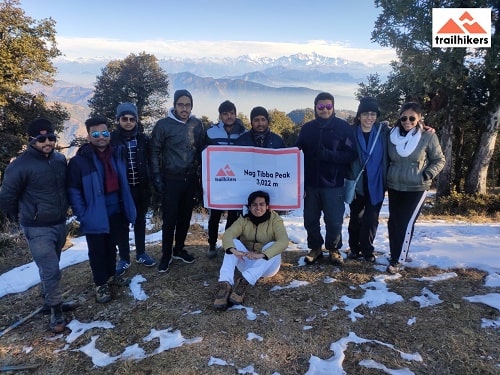
- 700+ Adventure tours
- Certified & experienced adventure team
- Premium trekking & camping services
- Highest safety standards with rescue & medical backup
Get A Call / WhatsApp
Our team will reach out to you on Call / WhatsApp within 12 hours !

Tour Details
TrailHikers® welcomes you to Sar Pass trek in May-June 2023. Sar Pass is one the most thrilling & adventurous treks located in the astounding Parvati Valley . Sar Pass trek has been widely cherished and adored for its mesmerizing snowy landscapes making the place a true destination for trekking and exploration activities.
Sar Pass trek is that ideal place to let come out all your fantasies related to snow and the snow-capped mountains. The place is having an eternal touch of nature which gives it an edge over other trekking sites . The place is calming and drenched in a wave of optimism making it more interesting.
₹ 5,999* per person
* 5% GST applicable
Read → INCLUSIONS / EXCLUSIONS
Upcoming Batches
May : Daily batches OPEN June : Daily batches OPEN
Custom dates available for groups of 5 persons or above !
Interested ? Lets plan your trip !
- Get Price Quote on WhatsApp +91-7895990850
Starting / End Point
Kasol / Barshaini, Himachal Pradesh
Start / Finish Day
Day 1 Kasol / Day 5 Barshaini village
Nearest Roadhead
Nearest railhead.
Chandigarh Railway Station
Nearest Airport
Bhuntar Airport (1 hr drive from Kasol)
- All snacks & packed veg. day meals on the trek (Day 1 Dinner to Day 5 Breakfast)
- homestay accommodation for 1 night (Grahan village on Day 1)
- Camping accommodation for 3 nights
- basic trek gear, gaiters, crampons as per snow conditions
- Forest trek permits
- Services of certified & experienced trek staff
- Transport from Barshaini to Kasol on Day 5
- any kind of road travel or transport to reach / depart from Kasol or beyond
- any kind of expense incurred in case a trekker drops out of the trek
- any kind of hotel / lodge stay
- any kind of personal expense on food or medicines
- any thing not mentioned in inclusions
Complementaries
- Soup / Hot drinks at campsite
- Extra snacks (biscuits/cookies)
- Camping accessories
Tour Highlights
Sar Pass trek is a 5-Day trekking adventure in the Parvati Vallley near Kasol , Himachal Pradesh . Sar Pass offers a complete hiking experience through dense forest walks, pristine Himalayan villages, wide panoramic views & adventurous summit of Sar Pass at 4,200 m . The best time for Sar Pass trek are the summer months of April , May & June .
- Trail through the dense forest & scenic Himalayan villages
- Ultra scenic panoramic views
- High altitude campsites
- Adventurous & challenging ascend to Sar Pass (4,200 m)
Sar Pass Trek Best Time
The best time to go for Sar pass trek is APRIL/MAY/JUNE which is also one of its highlights and it truly justifies the title of the highlight as it falls during the vacations making it even more enjoyable.
The complete season for Sar Pass trek ranges from the month of April to the month of October making it a perfect outing destination to get relaxed and refreshed. The months themselves portray the story of amusement and the interesting energies which make any tourist site blissful and soulful.
- Summer months April, May & June
- First week of July
- Post monsoon Sept-Oct
Day 01: Kasol to Grahan Village Distance: 7-8 km / Time taken: 4-5 hours
Starting time – 9:30 am
After a healthy breakfast, the trek starts after a brief orientation with guides and trek leaders Kasol To Grahan (7 km approx.)
– First days trek ascends to Grahan village which takes almost 4-5 hours from Kasol. Trail is covered with pine forest and is steep forward till Grahan Nahal. – After Grahan Nahal the trail becomes more rocky and steep. After an hour of trek, we will reach Grahan Village. Dinner and stay overnight at village homestay.
Inclusions on 1st Day – Evening Snacks – Dinner – Night Stay in homestay – services of trek guide & trek leader
Day 02: Grahan Village to Min Thatch Distance: 7-8 km / Time taken: 4-5 hours
Starting time – 8:30 am
After breakfast, trek starts to Min Thatch Grahan To Min Thatch (7 km approx.)
– During the trail, you will cross over the views of Min Thatch, Nagaru and Sar Pass top on the mountains. The steeper trail will take you to the woods. – Cross the lush green forest and reach Min Thatch. Admire the Chanderkhani stretch and many more ranges from the campsite at Min Thatch.
Inclusions on 2nd Day – Breakfast – Evening snacks & dinner – Stay in camping tents (sleeping bags, mats, tent provided) – services of trek guide & trek leader
Day 03: Min Thatch to Nagaru Distance: 8-9 km / Time taken: 4-6 hours
Starting Time – 9:30 am
After breakfast, trek to Nagaru through pastoral forest Min Thatch To Nagaru (8-9 km approx.)
– After a difficult trek for 4-6 hours, you will finally reach the Nagaru campsite. – Enjoy the mesmerizing vistas of the magnificent mountains across the Parvati valley. – See the small glittering lights of the Manikaran town as the night sets in. It gets extremely chilly in the evening.
Inclusions on 3rd Day – Breakfast – Evening snacks & dinner – Stay in camping tents (sleeping bags, mats, tents provided) – services of trek guide & trek leader
Day 04: Nagaru to Bishkeri Thatch via Sar Pass Distance: 12-13 km / Time taken: 7-9 hours
Rise and shine early in the morning to start your trek at 4 am Nagaru To Bishkeri via Sar Pass (12-13 km approx.)
– Climb up through snow trails and admire the dazzling peaks of Tosh Valley. – The exhilarating view on the top of Sar Pass (4,343 m) will leave you spellbound, so spend some more time experiencing the beauty of the top. – Try sliding through the snow with necessary precautions. Walk for an hour and cross some magical water streams to reach the Bishkeri Thatch campsite by evening.
Inclusions on 4th Day – Same as 3rd Day
Day 05: Bishkeri Thatch to Barshaini & Departure Distance: 9-10 km / Time taken: 4-6 hours
Bishkeri To Barshaini (9-10 km approx.)
– Start trekking downhill through the dense forest, crossing a stream, and then reach Pulga. – The twin village Pulga and Tulga are separated by a stream. Cross the bridge on the Parvati River to reach the Barshaini Village & from there you will be dropped at Kasol bus stand / Kasol market.
END OF TRIP !!!
Inclusion on 5th Day – Breakfast – services of trek guide & trek leader – Transport from Barshaini To Kasol
Is it necessary to hire a guide on this trek ?
Yes, it is absolutely essential to take a guide for Sar Pass trek whether you are solo or in a group.
What is the best time for Sar Pass trek ?
The best time to do Sar Pass trek is from April to June and September to October.
How difficult is Sar Pass trek ?
Sar Pass trek is an easy-moderate trail as it requires good endurance and stamina. During the trek, you gain almost 8,000 ft altitude with an average 5-6 hours of trek per day.
How long is Sar Pass trek ?
Sar Pass trek is approximately 45 km of trail on an easy-moderate gradient in a span of 5 days.
How high is Sar Pass ?
Sar Pass altitude is 4,220 m / 13,845 ft. The summit of Sar Pass is often snow bound till end of June or early July.
Is Sar Pass trek safe ?
Yes, overall Sar Pass trek is a safe Himalayan trail as per mountaineering standards.
Is this trek suitable for kids ?
It is ideally recommended for 15+ age group.
Is this trek safe for women & solo travelers ?
Yes, in fact all the treks in the mountain regions are quite safe for women & solo travelers. People of the region are very warm, caring & hospitable in nature.
Do we have to give tip money to guides / porters ?
Guides & porters in the region will never demand any tip money from you. They just need their daily wages paid by the trek operator. However, it is always encouraging if one can give a little tip to them if they provide good services.
Which currency is accepted during transit or in nearby villages on this trek ?
Indian currency is accepted
Related Tours
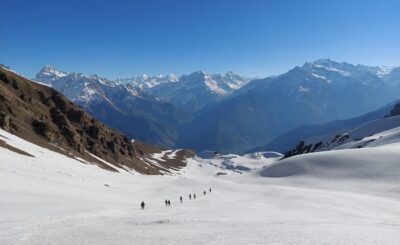
Camp Wildfox
Kiran Dhami
Sar Pass is undoubtedly one of the best mountain pass treks in the Indian Himalayas. It offers dense forest walks, ultra scenic valley views & an adventurous ascend to the Sar Pass top at 4,200 m. Superb trek with TrailHikers team !
Sumit Trivedi
Sar Pass trek is a perfect multi-day trek for beginners as well as seasoned hikers. The fact that some members in our group were beginners, but still completed & enjoyed the trail all the way up to Sar Pass. Thanks to very supportive & professional team of TrailHikers !
Akhil Kumar
Sar Pass trek has been a delightful Himalayan experience for all our group members. The trail has beautiful valley walks, wide panoramic views & thrilling summit of Sar Pass !
- 0 Shopping Cart ₹ 0.00 -->
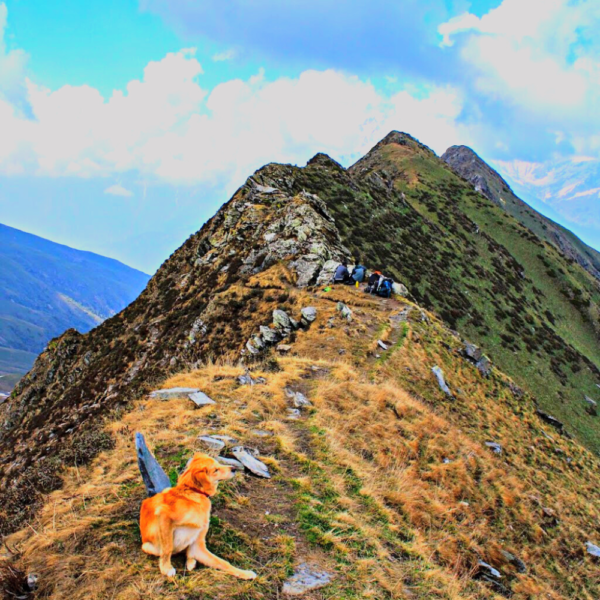
Sar Pass Trek 2023 5 Days 4 Nights May and June
₹ 14,000.00 ₹ 7,000.00
Description
- Reviews (0)
Sar Pass located in Parvati valley is a moderate to pro trek which covers beautiful Grahan village, Mung Thach, and Nagaru, the trek starts from Kasol and will take around 5 to 6 days to complete the trek. Sar Pass trek will let you experience the mesmerizing view of pine forest and rhododendrons. The first day’s stay will be at Grahan Village, which will take around 5-6 hours to reach. The trek allows the trekkers to witness the Himalayas covered in lush greens and pristine white, Grahan, a small village perched at the height of 2375 m in Parvati Valley, located in the Kullu, is among the favorite spots for Valley lovers. The Sar Pass trek is gaining popularity as a favorite amongst those seeking adventure in Kasol or Kullu.
At the elevation of 4200 m, Sar pass will let the trekkers experience, an elevation variation of 2000m in which trekkers will experience a breathtaking view of Grahan village, Nagaru Thach, Sar pass literally means “Lake located in the pass”
The total distance of the Sar pass Trek is 48 km at the elevation of 13,800 ft/ 4,275 mt, the average temperature of the region is 22°C (Max. During Day Time) to -5°C ( Min. During Night Time)the best time to trek the Sar pass is April to October, in winter the trek is not available due to heavy snowfall.
This is a basic Landing Package for Sar pass of 4N/5D. If you need pic and drop it from your location please call on our support number to custom your package. Kheerganga sometimes due to heavy snowfall is not available, in such cases as alternative options Grahan Village or Trek Tosh Valley Trek will be provided.
There are no reviews yet.
Your email address will not be published. Required fields are marked *
Name *
Email *
Save my name, email, and website in this browser for the next time I comment.
Your review *
Related products
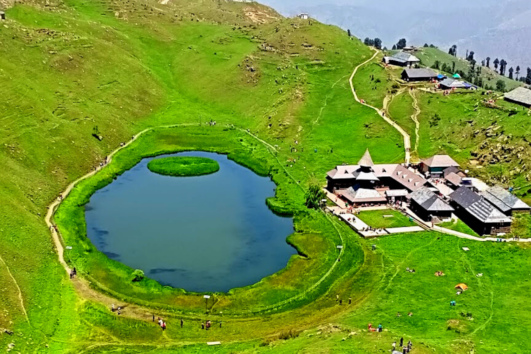
Parashar Lake Trek, Himachal 2023 Hike Himalayan at 2300₹ Only
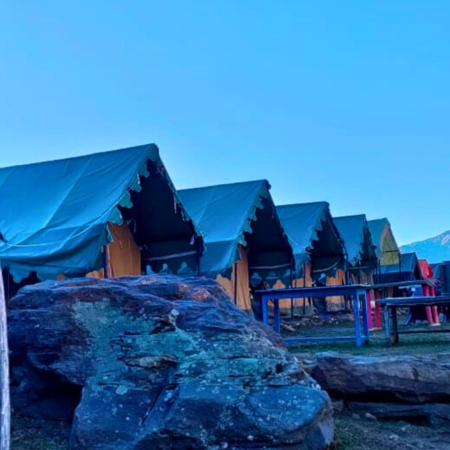
Kheer Ganga Trek 2023 2Days 1Night
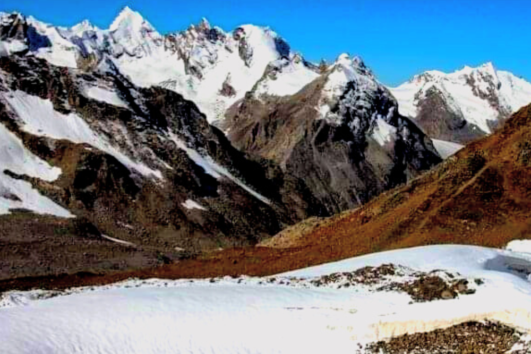
Pin Parvati Pass Trek 2023 Bookings Available
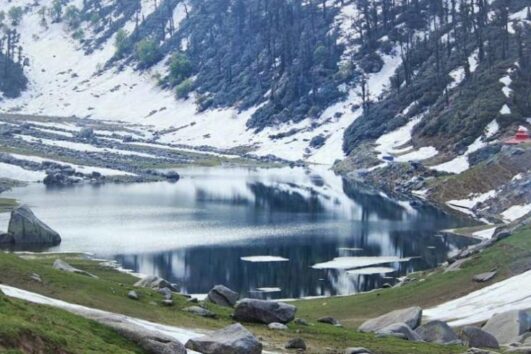
Kareri Lake Trek 2023
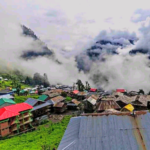
- +91 9015303301

- Himachal Pradesh
Sar Pass Trek, Kasol
from 3 reviews
4 Nights 5 Days
Specific Tour
Sar Pass Trek
Sar Pass Trek Overview
Sar pass trek is been counted amongst the most scintillating and most amazing places located in the astounding Parvati Valley .
Sar Pass trek is been widely cherished and adored for its mesmerizing snowy landscapes making the place a true destination for trekking and Exploration activities.
Sar pass trek is that ideal place to let come out all your fantasies related to snow and the snow-capped mountains. The place is having an eternal touch of nature which gives it an edge over other trekking sites.
The place is calming and drenched in a wave of optimism making it more interesting.
How long is Sar Pass Trek?
Sar pass Trek is almost 48km form Kasol to Barsheni
Height & Altitude of Sar Pass Trek
Sar pass trek is been blessed with a humongous and prestigious height which spans around 13,780 feet giving sheer goosebumps to the trekkers and backpackers.
The height does having a pivotal share in terms of trekking activities and tourism ones.
And Sar Pass having such a magical number which can easily allure any trekking undoubtedly. The Sar Pass Trek has always been that A listed name when it comes to trekking in Kullu valley and the height factor does play a much bigger role in setting up this feat.
Sar Pass trek altitude ranges between 4200m from sea level making it a pioneer trekking site and giving trekkers and tourists an open invitation to explore and trek on.
The altitude of the SarPass Trek is the most optimistic and enriching feature of the trek which is one of its highlights.
Sar Pass Trek Location
Distance of sar pass sar pass trek cost.
The super luxurious Sar pass trek is having a moderate distance spanning around 48kms making it a quite lengthy one. Though it might seem to be a giant trek it’s not, the trek is full of unparallel exploration and astounding sceneries. ft kms day
Sar pass trek’s whole distance is truly justifying one to its stipulated distance. The trek is having many super amazing and super wonderful sightings which makes it undoubtedly an ideal one in terms of tourism and trekking purpose.
sar pass trek sar pass trek sar pass trek sar pass trek sar pass trek sar pass trek sar pass trek sar pass trek
sarpass trek sarpass trek sarpass trek sarpass trek sarpass trek sarpass trek sarpass trek sarpass trek
Sar Pass Trek Route Map
Day 1 : Stay In Kasol For Acclimatization(Chalal Hike) sar pass trek
Highlights: 2/3 Km | 1/2 Hours | 1500m- 1600m|
Day 2: Move up: Kasol to Grahan Village sar pass trek
Highlights: 7/8 Km | 4/5 Hours | 1700m – 2350m|
Day 3: In the woods: Grahan to Min Thatch sa sar pass trekr pass trek
Highlights: 7/8 Kms | 4/5 hours | 2350 m – 3500m sar pass trek
Day 4: The cold trail: Min Thatch to Nagaru sar pass trek
Highlights: 4/6 Hours | 8/9 Kms | 3400 m – 3800m sar pass trek
Day 5: Snow trail: Nagaru – Sar Pass – Bishkeri sar pass trek
Highlights: 7-9hrs |12-13km | 3800m – 4182m – 3350m sar pass trek
Day 6: Finish your trek: Bishkeri to Barshaini and departure sar pass trek
Highlights: 4–6hrs | 9-10km| 3350m – 2400m sar pass trek
Sar Pass Trek Weather & Temperature
SarPass trek falls in that basket of multi-dimensional tourist destinations which having all-around features and the splendid balance which makes it more alluring.
The weather is a pretty nurturing one to go for trekking and exploration activities.
Weather at Sar pass trek having its own vibe which makes it a more attractive and super amazing thing.
Sar pass trek weather gives a much better perspective and the super awesome experience which worth every penny spent and its more enriching one to have.
Temperature At Sar pass Trek
Sar pass trek as such having the most optimistic temperature which suits it in a perfect way. Sar pass trek temperature lies between 10-20 degrees on normal sunny days making it far comforting.
The temperature always makes a greater impact when it comes to tourism and here the temperature plays a bigger part to attract tourists.
Best Time for Sar Pass Trek
The best time to go for Sar pass Trek is also one of its highlights and it truly justifies the title of the highlight as such it falls during the vacations making it even more enjoyable.
The Best time starts in the month of April and the season ends in the month of October making it a perfect outing destination to get relaxed and refreshed.
The months themselves portray the story of amusement and the interesting energies which make any tourist site blissful and soulful.
How difficult is Sar Pass Trek ?
The difficulty level of this prestigious and much-beloved trekking site lies between the Moderate Level making it a descent trekking site
. Sar Pass trek is having a pretty stupendous height which might give chills to the trekker but it’s a pretty moderate one to trek on and explore the scintillating venue which is wholly a super majestic experience.
Sar pass trek does testify your endurance level in a pretty decent manner which tourists and backpackers might be aware of difficulty. sarpass trek
Highlights of Sar Pass Trek
Sar pass trek is known for its snow-capped mountains and the widespread snowy land making it a ultimate destination for the tourists and the snow lovers. sarpass trek
The Sar Pass Trek is known for its scintillating landscapes and the picturesque sights which makes the place more blissful and the celebrative one.
The place is having many of the refreshing and the relaxing vibes all over blessing tourists and visitors with thesoulfulness and the sacredness.
Is the Sar Pass Trek for Beginners ?
Sar Pass Trek is been classified as the Easy to Moderately one which is known for testifying the sheer endurance levels. Sar pass trek brings that joy and excitement amongst the trekkers and tourists. sarpass trek
And when it comes to the beginners then this trek does flags off a challenge and the preconcieved notion of trekking skills. For the beginners its perfect to sharpen their trekking skills but they’ve to be much careful and concious about the trek as its moderately difficult one.
Activities in Sar Pass Trek by Each Day
Sar Pass Trek is an easy-moderate adventure trail in the Parvati Valley of Himachal, perching at an altitude of 14000 ft, it is one of the easy treks to consider for introduction to high altitude trekking. Let’s take a guided walk on how the Sar pass trek days look like it!
- Day 1 starts trekking from Kasol to Grahan Village covers around 7 to 8 Km consuming a time period of 4 to 5 Hours gaining an altitude of 1700m to 2350m
The starting point is from Kasol and you will be going up to Grahan village. Drive for the first few hours till the trekking starts. You might come across localities as the path is common means of connection. The entire scene till now will be that of natural green lands and blooming flowers.
Soon the gradient is going to change into rugged rocky and steep after crossing the Grahan Nallah. Once you are closer to the Grahan Village, the trek becomes pretty steep for a while and you can see the village.
An ancient village, Grahan village has traditional houses with beautiful evenings and you can click pictures of the village life near the camp. The beauty at the camp becomes more comfortable and scenic as one gets acquainted.
Rest up lazy soul, have your dinner and enjoy your first day at the trek.
- Day 2 starts trekking Into the woods from Grahan to Min Thatch covering a distance of 7 to 8 Kms consuming a time period of 4 to 5 hours gaining an altitude of 2350 m to 3500m.
Today’s trek is a 4-5 hours long stretch to Min-Thatch. Locals usually use this path to take their livestock to higher pastures for grazing. Meet and strike a conversation with them! The trail offers a great range of flora and fauna birds, insects, etc. As we go, it becomes steeper and leads into the woods.
You can stop for a bite and some rest at Ratapani. This area is like a wonderland of woods and you can feel the thick canopy walking with you. The trail through the forest eventually opens up to a grassy patch of land and after that, the forest will vanish slowly. Admire the open lands with thick green grass and the snow-capped mountains with the valley below.
Climb a steep section again to reach the Min Thach which is located on the hillock and is surrounded by flat rocks. The sunset and sunrises at this camp offer great views. End your day here with a beautiful night sky and cozy surroundings!
- Day 3 trek starts to The cold trail crossing Min Thatch to Nagaru Base Camp, consuming around 4 to 6 Hours covering distance 8 to 9 Kms and gaining 3400 m to 3800m.
You need to get up a little early and start your day since it is a long trek to Nagaru Base Camp. The trail today is comparatively steep than the previous route. The trail is covered with pastoral forests and snowy meadows which makes the path a little difficult to pass. The air up is a little bony and you might experience altitude sicknesses such as headache and dizziness.
This is normal, just keep your medical kit handy. Keep yourself hydrated and keep your hands, nose, eyes, and ears open to acclimatize better. In emergencies, Lazymonk guides will take of you including the first aid kit, portal oxygen, oximeter, and pulsometer.
When closer to the camp, you will start facing chilling winds and that’s how you will know that there is a decrease in the temperature as well. The coldest spot of the entire trek, the temperature might drop to zero here so bundle up yourself accordingly. At Nagaru, you can enjoy the mesmerizing view of the cold winter evening with the sunset painting the sky in hues.
- Day 4 summit day, trek through Snow trail crossing Nagaru to Sar Pass to Bishkeri consuming 7 to 9hrs covering a distance of 12 to 13km and gaining an altitude of 3800m to 4182m and declining 3350m sarpass trek
Another day of an early trek! The trail comes with snow and steep tracks on most of the route till the pass and beyond. After climbing the Nagaru ridge, the trail is moderate. On the way, there is a canteen near the lake where you can have Maggi, tea, and coffee. sarpass trek
Climbing higher to the pass offers mind-blowing views of the stunning meadows and towering peaks of Parvati valley. Walk slowly but steadily while climbing upwards and on the snow. As you approach the top, the gradient becomes steeper just a few meters below the pass. sarpass trek
That’s the only steep part that needed to be crossed for the day. Reaching the top of the pass will give you a feeling of satisfaction by looking at the mighty Himalayan snow-capped peaks, green meadows, and the trail below.
Spend time at the SarPass trek while enjoying your packed food and taking a lot of pictures. Start trekking down on gentler slopes through rhododendron trees till you reach Bishkeri Thach. After a long tiring day in the lush green meadows, wildflowers, and variety of birds at Bishkeri you can rejuvenate your body and mind while you rest. Camp here for a night at this soothing place. sarpass trek
- Day 5 Finish your trek crossing Bishkeri to Barshaini and departure consuming around 4 to 6hrs covering a distance of 9 to 10km declining altitude of 3350m to 2400m. sar pass trek 2021 sar pass trek duration
The trail from Bishkeri to Barshaini is mixed with downhill to moderate. On this route, you have to be careful while walking each step on the slope. Again walking slow and steady will help you to approach the road head easily.
Climb down through dense forests of Deodar oak and pine with little water streams along the way. On your way, enjoy beautiful meadows, huge trees, piles of fallen and rotten logs with a feeling of nostalgia. Herds of wild cows, bulls, and horses can be seen on lower pastures. sar p sarpass trek ass trek cost
A couple of tea shops will pass by, where you can enjoy your snack time. After hours of mesmerizing forest trek, you will reach Pulga village and from here there is a moderate walk to Tulga village. sarpass trek
From Tulga, you will have to cross the Parvati river and climb for a while to reach Barshaini. You can board a bus or drive-in back to Kasol from here. thach ft km sarpass trek s
We hope you enjoy it! sarpass trek
Things to Carry for Sar Pass Trek
Backpack 30/60 L
- External straps and loops and easy to open compartments access.
Water Bottle
- A reusable water bottle/hydration flask – 1.5-2L.k.
Energy Bars
- Nutrient-dense with oats, nuts, seeds, and fruit.
Weather Appropriate Clothing
- Warm and waterproof clothing for winters, wind and waterproof jackets.
Warm Jacket
- Fleece/padded jacket to keep you warm.
- A textured grip with rechargeable batteries.
Sun protection
- Sunscreen, wide-brim hat, and sunglasses.
Rain Protection
- Umbrella, opt for waterproof & windproof rain jacket for winters.
Trekking Boots
- Good grip, flexible sole, good ankle support, snug fit, water-resistance and are easy to wear/remove.
Extra Pair of Clothing
- When the weather changes in the mountains (as it happens every few hours), you can take off or put on layers as required.
- Lightweight – cotton/bamboo/linen/microfiber easy to dry.
Personal Hygiene Kit
- ” Hand sanitizer, biodegradable soap, toothbrush, toothpaste, cotton washcloth, toilet paper, a menstrual cup (if necessary) or feminine hygiene products, and a sealable plastic bag to carry them out.”
Mini First Aid Kit
- First aid for emergencies.
- Normal kitchen garbage bags to keep the trails you trek beautiful, clean, and free of garbage.
- With a flexible sole and good grip, water-resistant. sar pass trek
How to reach Sar Pass ? sar pass trek how
To reach Kasol by railways you’ve got to urge off at the closest railroad station to Kasol which is Joginder Nagar railroad station , about 144 km from the village of Kasol. sarpass trek
You’ll take a cab from the station to succeed in Kasol or a bus from the Joginder Nagar Bus Stand towards Manikaran which should take about 4.5 to five hours. sarpass trek
Check out More adventure activities In Himachal Pradesh sarpass trek
Sar pass Trek Blog
Hampta Pass Trek
Sarpass Trek
Sar Pass Trek is an easy-moderate adventure trail in the Parvati Valley of Himachal, perching at an altitude of 14000 ft, it is one of the easy treks to consider for introduction to high altitude trekking. Let’s take a guided walk on how the Sar pass Sar Pass Trek is an easy-moderate adventure trail in the Parvati Valley of Himachal, perching at an altitude of 14000 ft, it is one of the easy treks to consider for introduction to high altitude trekking. Let’s take a guided walk on how the Sar pass
Day 01 – Kasol and Trek to Grahan Village
Starting Time - 9:30 A.M After Healthy Breakfast, brief orientation with guides and trek leaders the trek starts. Kasol To Grahan (7K.M) - First day trek aims to Grahan village which consumes 3-4 hours from Kasol. Trail cover Pine forest and steep forward till Grahan Nahal. - After Grahan Nahal the trail becomes More rocky and sleepy. After a hour of trek we will reach Grahan Village. Dinner and stay overnight. Incusion on 2nd Day - Breakfast,Packed Lunch,Evening Snacks,Dinner - Stay In Homestay - Guide & Trek Leader
Day 02 – Grahan Village to Min Thatch
Starting Time - 8:30 A.M having breakfast trek starts to Min Thatch. Grahan To MIn Tanch (7K.M) - During the trails will cross over the view of Min Thatch, Nagaru and Sar top on the mountains. The steeper trail will take you to the woods. - Cross the lush green forest and reach Min Thatch. Admire the Chanderkhani stretch and many more ranges from the campsite at Min Thatch. Incusion on 3rd Day - Stay In Tent(Sleeping Bag,Matress,Tent) - Guide & Trek Leader - Breakfast,Packed Lunch,Evening Snacks,Dinner- Dinner - Gaiters
Day 03 – Min Thatch to Nagaru
Starting Time - 9:30 A.M After breakfast trek to Nagaru through Pastoral forest. Mintach To Nagaru(7K.M) - After a difficult trek for 4-5 hours, you will finally reach the Nagaru campsite. - Enjoy the mesmerizing vistas of the magnificent mountain across the Parvati valley. - See the small glittering lights of the Manikaran town as the night sets in. It gets extremely chilly in the evening. Incusion on 4th Day - Breakfast,Packed Lunch,Evening Snacks,Dinner - Stay In Tent(Sleeping Bag,Matress,Tent) - Guide & Trek Leader
Day 04 – Nagaru to Biskeri Thatch via Sar Pass
Starting Time - 9:30 A.M Rise and shine early in the morning to start your trek.(4A.M) Nagaru To Biskeri(7K.M) - Climb up through Sow trails and admire the dazzling peaks of Tosh Valley. - The exhilarating view on the top of Sar Pass will leave you spellbound Spend some more time experiencing the beauty of the top. - Try sliding through the snow with necessary precautions. Walk for an hour and cross some magical water streams to reach the Biskeri Thatch campsite by evening. Incusion on 5th Day - Breakfast,Packed Lunch,Evening Snacks,Dinner - Stay In Tent(Sleeping Bag,Matress,Tent) - Guide & Trek Leader
Day 05 – Biskeri Thatch to Barshaini and Departure
Starting Time - 9:30 A.M Biskeri To Barsheni(7K.M) - Start trekking downhill through the dense forest, crossing a stream, and then reach Pulga. - The twin village Pulga and Tulga are separated by a stream. Cross the bridge on the Parvati River to reach the Barshaini Village. Incusion on 6th Day - Transportation Form Barsheni To Kasol - Breakfast - Guide & Trek Leader
Included/Excluded
- Meals (Breakfast, Lunch, Snacks, Dinner)
- Tent On Sharing Basis
- Sleeping Bags and Sleeping mat
- Toilet tents
- Guides & Trek Leaders
- Transportation to and from Barshaini.
- Transfer / meals / accommodation aside from mentioned above
- Unforeseen handling costs thanks to weather disturbance, landslides, political unrest
- Personal expenses towards tips, telephone calls, laundry, beverage, insurance etc.
Difficulty Level
Best time to visit, tour's location, things to carry for sar pass trek.
View from the top is almost breath taking.
Don't miss this trek. must do.., write a review, leave a reply cancel reply.
Your email address will not be published. Required fields are marked *
You might also like
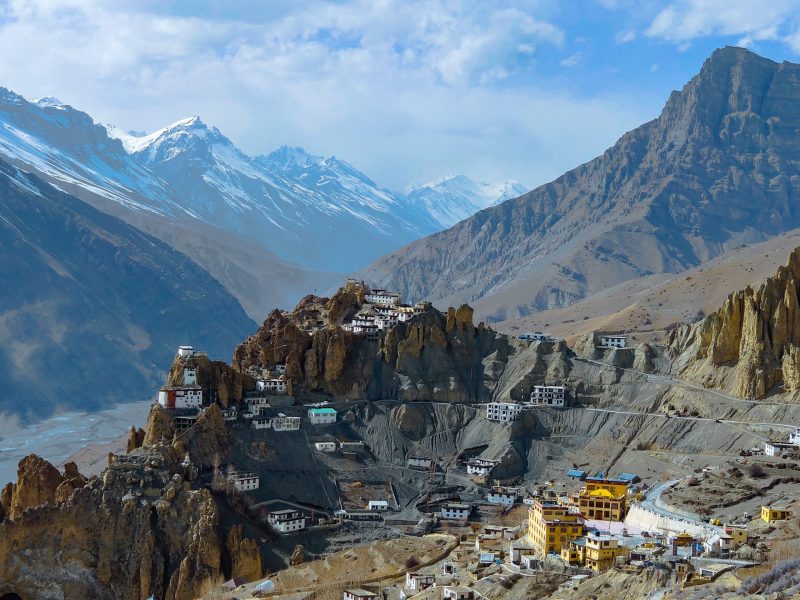
Spiti Valley Expedition
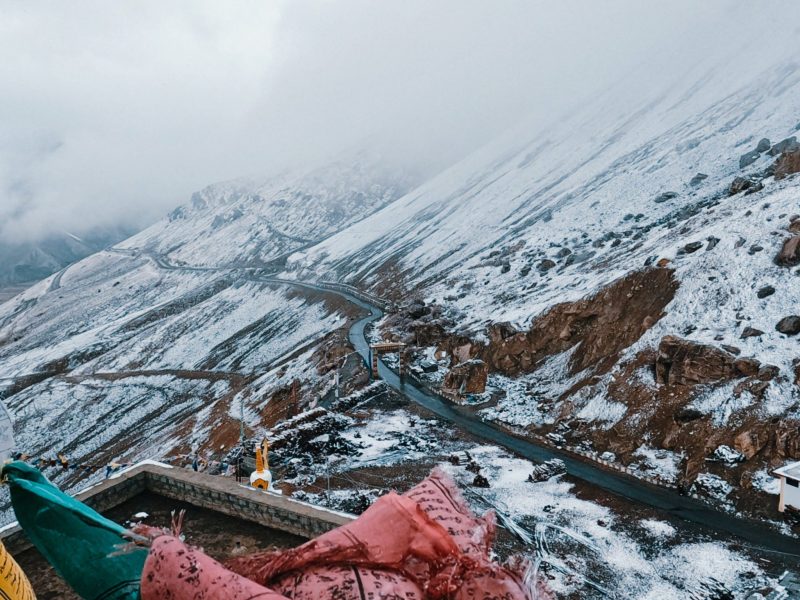
Spiti Winter Expedition
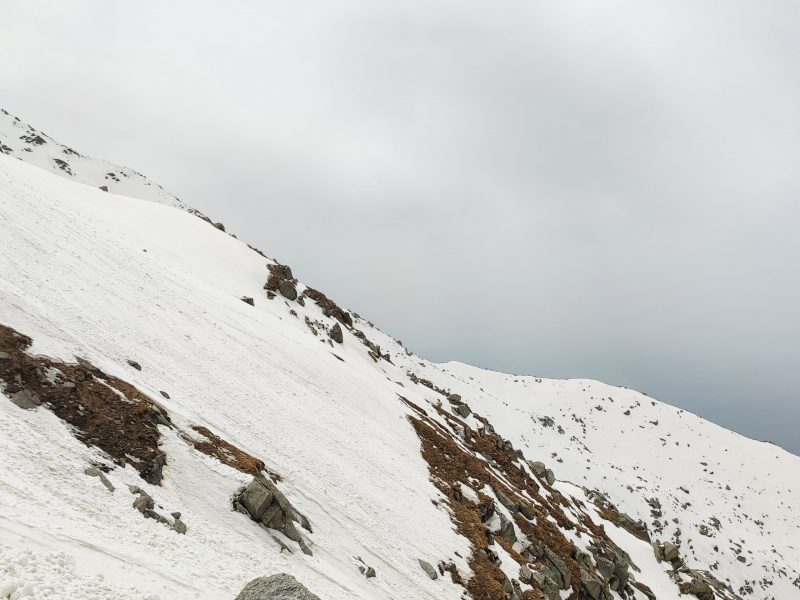
Moon Peak Expedition

Delhi To McLeod Ganj Camping
or continue with
Reset Password
Enter the e-mail address associated with the account. We'll e-mail a link to reset your password.
- River Rafting
- Rock Climbing
- Scuba Diving
- Wildlife Safari
- View All Tribes
- Ajeet Bajaj
- Amit Chowdhury
- Gayatri Sawhny
- Latika Rana
- Rajesh Kalra
- View All Gurus
activity guide
- Bungy Jumping
- Hot Air Ballooning
- View All Activity Guides
destination guide
- Lahaul and Spiti
- Lakshadweep
- Nubra Valley
- View All Destination Guides

NORTH INDIA
- Himachal Pradesh
- Uttarakhand
SOUTH INDIA
- Western Ghats
INTERNATIONAL
- South Africa
- United Kingdom

LAND ACTIVITIES
- Camel Safari
- Horse Safari
- Jeep Safari
- Mountaineering
- Motorsports
- Photography
AIR ACTIVITIES
- Bungee Jumping
- Paragliding
WATER ACTIVITIES
- River Cruising
- Family Outings
- Fixed Departures
- Weekend Getaways

` 7,999 ` 5,699 per person
Duration: 5 days, talk to an expert, 0120-6907340.
Trekking to the Himalayas in India is an experience of a lifetime and a mélange of adventure and self-realization! You’ll not only discover some beautiful places, but you will rediscover yourself amidst the beauty of the majestic Himalayan ranges! Just remember it’s not about the mountain we conquer, but ourselves. Every mountain is reachable if you just keep walking towards it. If your passion starts with adventure and trekking then this is the best way to get away from all that stress of the noisy cities. Take the adventure of trekking to Sar Pass , a place that offers eternal beauty, tranquility, and adventure.
Take in the beauty of enchanting vistas of Kasol and start walking towards Grahan Village through the verdant forest! The next day, the steeper trail into the forest will take you to the Nagaru Campsite. The enthralling views of Parvati Valley will leave you breathless. An early morning trek via Biskeri Thatch will take you to the magical Sar pass! Know more about other popular options for Trekking in Manali .
Detailed Itinerary for Sar Pass Trek:
Day 01: Kasol to Grahan Village (2347m) Distance/Duration - 7km / 4-5 Hours Grade - Easy Meet our team at the decided location in Kasol and start your exciting Sar pass trek! The easy trail towards Grahan village, which is frequently used by locals, will take you through pine forests. In a couple of hours, you will be able to cover much of the distance as the trail is easy to climb. After reaching the Grahan Nahal, the trail becomes rocky and steep. The locals say that the Rhododendron petals can be eaten whole and the syrup can be mixed with water to make a refreshing drink. You may definitely try that when in the Himalayas! The steep climb of an hour will take you to your destination for the day. Reach Grahan Village by evening and freshen up. Have your dinner and stay overnight in the camps. Day 02: Grahan Village to Min Thatch (11,150ft) Distance/Duration - 5km / 4-5 Hours Grade - Easy Start your trek towards the north of the camping ground at Grahan . You will bump into many locals on the way using the Min Thatch trail. After walking a little more, you will see the Min Thatch top, Nagaru top, and Sar top on the mountains. The trail will take you through the woods. Remember to stay with your group here as the trail becomes denser and a bit confusing. Cross the lush green forest and reach Min Thatch. Admire the Chanderkhani stretch and many more ranges from the campsite at Min Thatch. Have your dinner and stay overnight at the camps. Day 03: Min Thatch to Nagaru (3810m) Distance/Duration - 2km / 4-5 Hours Grade - Moderate Have your breakfast and trek through the pastoral forest covered with snow from Min Thatch to Nagaru. You will have to be careful on this trail as there are steep slopes and the snow will make the trek difficult here. After a relatively difficult trek for 4-5 hours, you will finally reach the Nagaru campsite. Enjoy the mesmerising vistas of magnificent mountains across the Parvati valley. See the small glittering lights of the Manikaran town as the night sets in. It gets extremely chilly in the evening. Stay overnight at the campsite. Day 04: Nagaru to Biskeri Thatch (3353m) via Sar Pass Distance/Duration - 6.5km / 6-8 Hours Grade - Moderate Rise and shine early morning to start your trek. Climb up through the snow trails and admire the dazzling peaks of Tosh Valley. After climbing for a few hours, you will reach the Sar Pass top (4222m). The exhilarating view from the top of Sar Pass will leave you spellbound! Spend some time there and take in the beauty of the place. Later, climb down towards Biskeri and enjoy the natural slide down to the valley.. The downhill slide is almost half a km and will provide you with an exhilarating adventure. Walk for an hour and cross some magical water streams to reach the Biskeri Thatch campsite by evening. Take a rest and have dinner. Stay overnight at the Biskeri Thatch campsite. Day 05: Biskeri Thatch to Kasol via Barshaini Distance/Duration - 5km Trek (4 Hours), 16km Drive (45 Minutes) Grade - Easy See the splendid views of lofty mountains and pine forests from Biskeri Thatch! Start trekking downhill through the dense forest, crossing a stream, and then reach Pulga. The twin villages Pulga and Tulga are separated by a stream. Cross the bridge on the Parvati River to reach the Barshaini Village. Your vehicle will be waiting for you there to drive you to Kasol. Your amazing trek to the Sar pass concludes here.
FAQs for Sar Pass Trek
1) What is the best season to visit Sar Pass? The best time to trek to Sar Pass is from Mid-April to June. Early in the season, the amount of snow on the passes and even the trail is much more than the latter part of the season. 2) What is the required level of fitness for the trek? Sar Pass Trek is moderate and having a decent level of fitness is important. The average number of hours spent trekking is around 6 to 7 and the trail is not so technical so anyone with little experience or even no experience can do this trek. Although, beginners are advised to prepare for a few weeks to gain the basic level of fitness. 3) What is the weather like during the open season? The weather, during the day, remains mostly pleasant throughout the open season but it gets relatively cold during the evenings and early mornings. The temperature during the trek stays between 12 degrees Celsius and 20 degrees Celsius during the daytime. At night, the temperature can range anywhere between -2 degrees Celsius and 6 degrees Celsius. Early in the season, there’s always a possibility of snowfall so carrying an extra layer of thermals and a raincoat is extremely important. 4) Can we rent/buy equipment for the trek in Kasol? Kasol is a popular destination for adventure travelers and acts as the base camp for the Sar Pass Trek. But being a small town, you may or may not find technical trekking equipment like shoes and trekking poles. It is advisable to bring the trekking gear with you before leaving for the base camp. 5) What makes Sar Pass an extremely popular trek? Although Sar Pass is only open for a few months every year, its popularity is no less than any summer Himalayan trek. It also happens to be one of the few treks where there’s a lot of snow even in the months of April and May. Sar Pass also has a long natural snow slide between the Sar Top and Biskeri Thatch. 6) Can I reach Kasol on Day 2 and start the trek? No, you need to spend at least one day in Kasol to get acclimatized before embarking on this Himalayan expedition. Starting the trek on the very first day of reaching the base camp will increase your chances of getting sick from Acute Mountain Sickness (AMS).
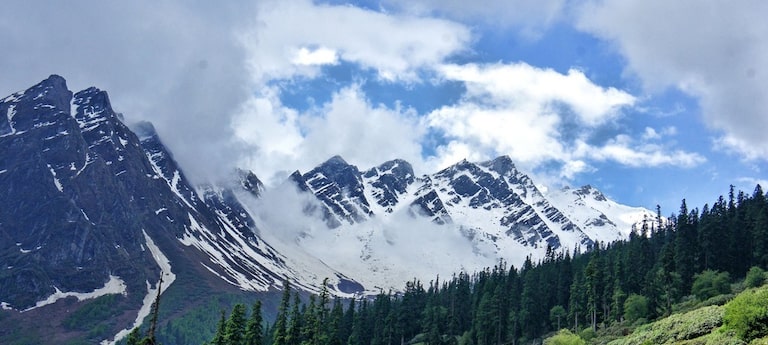
Package Details
Sar pass trek, price (per person): ` 7,999, duration: 5 days, cancellation policy | payment policy.
Arrival/ Finish Location - Kasol Level: Moderate Maximum Altitude: 13800 Feet Best Time to Go: April to June Region: Shivalik ranges, Himachal Pradesh Total Trekking Distance: Apprx 40 to 50 Kms
Inclusions:
Exclusions:.
- Accommodation - From Day 01 to day 04, stay is provided in sharing tents. Toilet tents are pitched at every campsite.
- Meals - Veg/Jain food from Day 01 Lunch to Day 05 Breakfast
- Trekking Stick: Wooden trekking stick is provided.
- Professional and Certified guides.
- Forest permission/camping charges.
- Availability of portable oxygen cylinder
- Transportation from Barshaini to Kasol.
- Transportation to reach Kasol
- Accommodation in Kasol - We recommend one night stay before the trek for acclimatization
- Travel insurance
- No Airfare or transportation or extra over and above the expedition
- Cost incured due to any Emergency
- Personal Porter Charges
- Bottled water.
- Any personal expense.
- Cost escalation due to change in itinerary Natural reason of unforeseen conditions like Landslides, Road Blockage, Bad Weather, Social or Political Unrest, Strikes, sudden shut down of any govt office etc
Reviews for Sar Pass Trek

have booked through Adventure Nation before when I went on my first trek. It had been amazing, I was expecting the same this time. And it was, the guides, the camps and the food, everything was perfect. Sar Pass is one of the beautiful treks I have been to, must go!
It couldn?t have been better. This is my third trek through you guys and I always get the best service. Camps and sleeping bags were clean. Wonderful experience.
My second trek through you guys! Couldn't have been more exhilarating an experience! Loved everything about it. Sar Pass trek in Kasol is a brilliant trek to go on if you're just starting out as a trekker. And make sure you visit at such a time that you get to see the snow trails because that is a beautiful sight to look at. But it will also make the trekking considerably difficult, especially right before you reach the campsite at Nagaru. So beware. Otherwise, this is the best trek you could ask for. And so budget-friendly! The way onward to Biskeri ridge is absolutely beautiful!
The food was great, the distances supposed to be trekked were fairly divided in six days. I loved how supportive the guides were through all of it. A lot of us on the Sar Pass trek were beginners so it was very important that they be a little more supportive and considerate than usual. We were all made feel safe and weren't made to exert more than needful and keep a moderate pace. I'd been to Kasol before so I could very well imagine what higher up would look like covered in snow. And it was better than what I had in mind! There's forests, wide and far reaching meadows with sky-high peaks in the backdrop, what's there not to like about this Sar Pass trek!!! Make sure to at least exercise for a few days before you are ready to go on this trek because even though it's a relatively simple trek, it can be difficult if you are not fit enough to do it.
This was my first time with Adventure Nation. I have been on total one trek before this one. Sar Pass trek was a great decision but I am all the more thankful to Adventure Nation for being so helpful throughout the process of booking. I have no complaints about the guides or the supplies made available to us on the trek. The sleeping bags, tents, food quality was better than expected. Definitely a one-time go! Only because of how beautiful the whole journey was!!! I loved trekking in Parvati valley in Himachal Pradesh. It was refreshing and so worth it! My best memory is looking at the sparsely but beautifully lit Manikaran town from above when we were on the Nagaru campsite. What a great view! Will recommend this trek and you guys to friends who want to start trekking! Thanks a lot!
Best trek in the Himachali region! The snow is everywhere! And it's so pretty to look at and walk on. The whole trek route was covered in snow when we visited this place but this trek isn't difficult to accomplish at all. I loved staying in Parvati Valley, one of the most beautiful places I have ever visited in my life. Would love to go back. You can also just plan a trip to Kasol and then go on this trek and come back to Kasol to stay there for a day or two because that place is also amazing and so cheap! Best experience money can buy!
Sar Pass trek is unimaginable in its beauty! What an experience it has been to be a part of your Sar Pass trek organized a while back. Thank you Adventure Nation. I found out about you through your Instagram. Special thanks to your operations team for resolving my booking issues immediately and guiding us thoroughly before we even got there! The guide was great, the food arrangement was also good. The trek is easy to do but my friend says it was a little difficult for him. There are certain parts of the trek that might be tough to scale for some people, if you are a beginner, but overall it is an easy and cherishable experience!
Sar Pass trek definitely brought some great experiences my way. Made some really good friends and we have already planned a trek soon to another place in Himachal Pradesh. I reached the pick up from Delhi on a bus and then taxi. The best part was I felt safe on the trek and the arrangements made were good. I loved the overall vibe of the place! It is a snow covered place and I just loved loved the beauty of it! The whole scene was enthralling. Thanks.
Camping in Ramsu and Grahan are phenomenal experiences. The art and the satisfaction of star gazing is dying in modern times but you gotta check out the starry skies when you are out there. You feel like you are one with the world. The campsites, even on ground level, are so beautiful. Basically, I had the time of my life!
Sar Pass trek is a fantastic trek if you want some easy to do adventure in Parvati valley. You can obviously taste the local cuisines also once you are out here. There are some really famous cafes that you should research about and check out. Love this place. Will always come back to it in times of need of an adventure.
Similar Adventures
Cancellation policy.
CANCELLATION POLICY
Cancellation charges per person
30 days or more before departure: 25% of total cost 29 - 20 days before departure: 50% of total cost Less than 20 days before departure: 100% of total cost
IF WE CHANGE OR CANCEL YOUR ADVENTURE HOLIDAY
We do plan the arrangements in advance. It is unlikely that we will have to make any changes to your travel arrangements. Occasionally, we may have to make changes due to Force Majeure Events and we reserve the right to do so at any time before or during the trip. If there are any changes, we will advise you of them at the earliest possible date before or during the trip based on the Force Majeure Events. We also reserve the right under Force Majeure Events to cancel your travel arrangements / offer alternative dates / revise the itinerary before or during the trip. Any additional cost incurred due to the above-mentioned reasons will have to be borne by the traveller himself. There shall be no refund to the traveller under Force Majeure Events.
Force Majeure Event shall mean and include any circumstance beyond the reasonable control of Adventure Nation, including without limitation, any act of nature or the public enemy, accident, explosion, fire, storm, earthquake, flood, drought, perils of the sea, casualty, strikes, lock-outs, labour troubles, riots, sabotage, terrorists acts, embargo, war (whether or not declared), governmental actions, delay in issuance or processing of Visa/permit, change of laws and regulations, orders, or decrees, or other causes of like or different character beyond the control of Adventure Nation.
IF YOU WANT TO CHANGE YOUR ADVENTURE HOLIDAY PLAN
After you make full or partial payment, if you wish to change your travel arrangements in any way (e.g. your chosen departure date or accommodation), we will do our utmost to make these changes but it may not always be possible. Any request for changes must be in writing from the person who made the booking. All cost incurred due to amendment will be borne by the traveller himself.
Payment Policy
46 Days or more before date of departure: 25% of total cost. 31 - 45 Days before date of departure: 50% of total cost. 30 days before date of departure: 100% of total cost.
Important: The booking stands liable to be cancelled if 100% payment is not received less than 30 days before date of departure.
- Submit Query
Provide your details, we'll call back
EMI Options
*Including GST
Sign in to your adventurenation account, login to your account, invalid email address or password, sign up and get the best adventure deals, sign up & get best deals.
- Accessible Adventures
- Adventure Running
- Off Roading
- Outdoor Photography
- Wind Surfing
Invite your friends.
Sent you a adventure nation request.
You have been invited to join adventurenation.com, a community for outdoors enthusiasts where you can join Tribes, interact with Gurus and get up to speed on adventure activities and destinations
Suggested Friends
- Trek & camping +917387642734
- Backapcking +9172086 20046
- [email protected]
- Mumbai Treks
- Himachal Tours
- Uttarakhand Tours
- Rajasthan Tours
- South Tours
- North - East Tours
- Himalayan Summer Treks
- Himalayan Winter Treks
- Spiti Valley
- Kedarkantha
- Har Ki Dun Trek
- Valley of Flowers Trek
- Malvan Tarkali
- We Are Hiring

- Sar Pass Trek
- Instant Confirmation
- Best Price Guaranteed
- 1000+ Happy Customers
- Upcoming trips in Mumbai
- Upcoming trips in Pune
- Upcoming trips in Delhi
- Upcoming trips in Bangalore
- Upcoming trips in Hyderabad
- Summer Treks in Himalayas
- Treks in Uttarakhand
- Sar Pass is a perfect trek for beginners. It’s apt for those who want to experience all kinds of terrain. Forests, meadows, quaint villages, or snow-covered mountains, this trail offers a gamut of experiences to trekkers. Prashant Jha, a post-graduate from BITS Pilani shares details of this well-explored trek, which lies in the Parvati valley of Himachal Pradesh.
- The trek starts from Kasol, which is a haven for backpackers from around the globe, and attracts large weekend crowds; many of which are the city youth, eager for a slice of the bohemian lifestyle. To cater to the tourists, the shops are well-stocked with both, necessities and luxuries.
- There are plenty of stay options – both, pocket-friendly and high-end, and one can choose from Israeli, Continental, Indian, and Chinese cuisines.
- Trek through forests, meadows, and quaint villages.
- Climb to the summit of Sar Pass at 13,799 feet for stunning views of snow-capped mountains.
- The trek starts from Kasol, which is a haven for backpackers from around the globe.
- This trail attracts large weekend crowds.
Basic information :
- Difficulty: Easy-Moderate
- Duration: 5 Days
- Max Altitude :13779 ft
- Base Camp: Kasol
- Best time to visit: May - October
Trek type: Forests, meadows & snow-covered mountains
Brief Itinerary:
Kasol to Kasol
- Day 01: Kasol to Grahan Village (2347m)
- Day 02: Grahan Village to Min Thatch (11,150ft)
- Day 03: Min Thatch to Nagaru (3810m)
- Day 04: Nagaru to Biskeri Thatch (3353m) via Sar Pass
- Day 05: Biskeri Thatch to Kasol via Barshaini
Delhi to Delhi
- Day 01: Departure from Delhi (5 PM)
- Day 02: Relax, Acclimatize, and Explore Kasol
- Day 03: Kasol (08 AM) to Grahan Village (2347m)
- Day 04: Grahan Village to Min Thatch (11,150ft)
- Day 05: Min Thatch to Nagaru (3810m)
- Day 06: Nagaru to Biskeri Thatch (3353m) via Sar Pass
- Day 07: Biskeri Thatch to Kasol via Barshaini, Depart for Delhi (08 PM)
- Day 08: Arrive in Delhi (08 AM)
- Kasol to Kasol: 5,999/-
- Delhi to Delhi: 9,499/-

Available Batches:
- April : 1, 2, 7, 8, 9, 14,15, 16, 21, 22, 23, 28, 29, 30
- May: 5, 6, 7, 12, 13, 14, 19, 20, 21, 26, 27, 28
- June : 2, 3, 4, 9, 10, 11, 16, 17, 18, 23, 24, 25
- July : 7, 8, 9, 14, 15, 16, 21, 22, 23, 28, 29, 30
- August : 4, 5, 6, 11, 12, 13, 14, 15, 16, 18, 19, 20, 25, 26, 27
- September : 1, 2, 3, 8, 9, 10, 15, 16, 17, 22, 23, 24, 29, 30
- Oct: 1, 2, 3
What is included in the tour
- Meals will be all veg Hot and delicious food will be served at Breakfast and Dinner.
- During the trek, packed food will be provided.
- From Day 1- Lunch to Day 5- Breakfast only.
- Forest Permits/Camping Charges, if any (Up to the amount charged for Indian nationals)
- Tented accommodations throughout the trek and guest houses
- Rent for camping equipment.
- Stay will be in tents on sharing basis i.e Double Sharing/ Triple Sharing
- Sleeping Bags and other necessities will be provided
What is NOT included in the tour
- Personal expenses.
- Insurance.
- Any Airfare / Rail fare.
- Other meals not mentioned in package inclusions
- Parking and monument entry fees during sightseeing.
- Additional accommodation.
- Extra luggage.
- Applicable GST
- Charges apply to all exclusive activities.
- Reprot at Majnu Ka Tilla at 05:00 PM
- Take a Volvo / Cab to Manali ( anywhere between 6:30 pm - 9:00 pm )
- Start the journey from Delhi to Kasol.
- Go to the local market to buy/rent any trekking equipment required.
- Relax and meet the team and get acclimatized
- Self explore Kasol
- Altitude: 1,700 m to 2,350 m
- Distance: 10 km
- Duration: 4-5 hours
- 08:00 AM Pickup from Kasol Market
- The trail from Kasol to Grahan is a marked one through forests, following the Grahan nalah . It starts from the center of Kasol and keeps to the true left of the nalah . The trail is easy to navigate and is frequently used by villagers. The gradient being gentle, one can effortlessly cover much distance in a matter of hours.
- The trail crosses the nalah and continues, before abruptly becoming rocky and climbing uphill, away from the right bank of the river. One may be led to believe that this is not the right path, but one must not go astray.
- Soon, the trees give way to grass and shrubs. One can see some fields as well and can spot bright-coloured tarpaulins. These are makeshift stalls with vendors selling refreshments like tea, omelets, and rhododendron syrup! Rhododendrons (locally known as b uras ) grow in forests that receive snowfall. Their bright red flowers bloom in spring and are collected to make syrup. Rhododendron petals can be eaten whole and the syrup can be mixed with water to make a refreshing drink (I discovered the benefits of rhododendron on my Har-ki-dun trip, where I happily chewed on a liberal amount of the tangy petals and felt energized immediately).
- After a steep climb of about an hour, look out for the village of Grahan, situated on the top of a hill. Camp there for the night. Accommodation is available in guest houses and there is a camping ground after crossing the village. There is a satellite phone in the village, and one may also get network coverage on cell phones.
- Altitude: 2,350 m to 3,400 m
- Distance: 7 km
- From the camping ground at Grahan, a trail goes north, climbing up gently. Villagers use this path often in the morning. This is the way to Min Thach.
- After walking for a while, the view opens up and a guide can point to you Min Thach, Nagaru, and Sar Top on the mountain to the right. The trail also becomes steeper and leads into the woods.
- After some time, you enter a dense forest; the thick canopy lets in very little sunlight. The slope becomes steeper still and the path is confusing in places.
- After toiling for a few hours, the forest opens up to a grassy patch on a ridge. This is Min Thach (“Thach “ means meadow in the local language; much like ‘ Kanda ’ or ‘ Bughyal; ’ it is where the villagers bring their cattle to graze).
- To the northwest, across the horizon, stretch Chanderkhani and other ranges. The ridge line continues to the east and rises up to a cliff covered in snow, on which sits the campsite of Nagaru (a guide can point it out).
- To the southeast of the ridge, lie forests. There is some cleared space to pitch a tent. A seasonal vendor’s hut may be found here; it sells tea, coffee, and omelets. Nearby is also a tap that supplies potable water. One can camp here for the night; the ridge will protect you from strong winds. A trench should be dug around the tents so as to allow the natural drainage of water in the event of rain, hail, or snow.
- Keeping one day to cover the distance from Grahan to Min Thach. It allows time for the body to acclimatize and warm up for the trek ahead. However, seasoned trekkers can also start early from Kasol, break for an early lunch at Grahan, and reach Min Thach post-noon.
- Altitude: 3,400 m to 3,800 m
- Distance: 8 km
- Duration: 4-6 hours
- From Min Thach, as the crow flies, Nagaru seems not far, but the route doesn’t go straight up the ridge line; instead, it veers up to the south (looking up at the cliffs, towards the right) and goes into the woods. Depending on the weather, one may find snow here. It is always advisable to start early, for the weather is generally favorable before noon and the snow becomes more slippery later into the day.
- After walking for a while, one comes to another ridge line – a rocky one overlooking a grassy meadow down in the distance. The ridge goes steeply up to the left (eastward), to the cliffs, atop which Nagaru sits. The path to Nagaru goes up this ridge and is well-marked for some hundred meters, after which the tree line ends and gives way to patches of grass and shrubs.
- If there is snow, then great caution has to be exercised, for this is the trickiest and riskiest part of the trek – the slope falls steeply to the valley below and may be slippery! The trail, even if marked, may not be visible in the snow. Here, having a guide and a trekking pole is of paramount importance; waterproof gloves will also come in handy. An ice axe may be used by the guide to chisel away snow for getting a foothold. The trekker would also need to employ proper technique – digging into the snow with his toes, and only once a firm foothold is established, putting the other foot ahead in the same fashion.
- After a couple of hours, you finally reach a welcoming patch of flatland on top of the hill – this is the Nagaru campsite. It feels like a different world! Facing north, one can see magnificent mountains rising steeply across the Parvati valley – with the town of Manikaran also visible. In the distance, to the northwest lie Chanderkhani and the ranges of the Beas valley. Down below, to the left, one can spot the campsite of Min Thach and the village of Grahan. To the south is a vast expanse of snow rolling up the hill. It is in this direction that one has to continue to reach Sar Pass. However, neither the pass nor the top of the mountain is visible yet.
- Though erratic, network coverage is available in some spots. A water tap can be seen near the western edge of the cliff and it may or may not be running, which is why water has to be carried from Min Thach. Camp must be established soon as the winds are very strong and the temperature dips very quickly after sunset.
- It gets very cold at night due to the wind chill factor and sometimes the winds are so strong that tents get blown away! It is advisable to retire early, to protect yourself from the cold. Besides, the next day involves an early start.
- Altitude: 3,800 m – 4,200 m – 3,350 m
- Distance: 14 km
- Duration: 6-8 hours
- Wake up before dawn. The previous day’s trek would have acclimatized you for today’s long trek – the same techniques need to be employed. The climb to Sar Pass follows the ridge line in a southward direction and is steep in some stretches. Feel free to keep up a slow but steady pace as you climb through the snow at a high altitude.
- The snow is easier to walk on and the heavenly surroundings keep one’s spirits high. After climbing up the hill seen from Nagaru, a higher hill that has to be climbed comes into view. A third of the distance to Sar Pass has been covered. To one’s right falls the cliff steeply to the valley below, the ridge is sharper and the climb steeper; so one must be careful. If there has been good snow recently, the climb is similar to what mountaineers are shown doing using ice axes and crampons!
- After climbing for what seems like a long time, one reaches the top of the hill and a sigh of relief and joy escapes as one beholds the view ahead. From the image searches on the web, one would know that this is Sar Pass! Sar Pass derives its name from ‘ Sar, ’ which means ‘pond,’ but the ‘Sar’ is mostly frozen till late in summer. The pass is not the kind one would have in mind – there is no saddle in the mountain range to cross.
- The view opens up eastward – the lofty peaks of the Tosh valley are now visible as well. To the south extends the white blanket of snow, flanked by snow-capped mountains – the highest of which seems to be within reach. However, it would take a couple of hours to summit and much distance has to be covered before the next camp.
- The onward route moves away from high ground, to the southeast, following the contours of the hill. With deep valleys on the left, one has to walk carefully. After some time, the path climbs up to a ridge running across, and one can see a flag tied to a ‘Trishul’ at the top. The slope is very steep in the last stretch and buried in the snow, one may find a rope, which can be held on to while climbing. This is a pass in the truer sense.
- As one reaches the top, the view is exhilarating. After a sharp drop of some hundred feet, unfolds a beautiful valley ahead (This was the highlight of my trek – I had braved snowfall and poor visibility, and my excitement reached a zenith when I reached the top and saw the surreal sight before me!). As one is soaking in the heavenly beauty of the place, a realization suddenly hits – there is no way to get down a hundred feet drops but by sliding!
- The slide is the most fun and completely harmless as long as some precautions are taken – loose belongings (phones, goggles) should be kept inside the bag and the legs should be kept tight together and not be dug in the snow if one wishes to slow down the speed; for this, elbows kept firmly by the side of the trunk can be pushed back into the snow.
- The slide takes one as far as a kilometer (depending on the snow conditions) to a gentler slope of the valley. After walking for some time, you come across another slope in the valley (not as steep as the first one), and depending upon the snow conditions, you can choose to slide again, for longer than a kilometer, till you reach level ground. The third change in slope (steeper than the second) comes not long after and can be covered by sliding again (if there is snow).
- The slide will take you past snow-covered trees, through a valley that has now narrowed, and bring into view to the left, a lovely meadow. This is the campsite of Biskeri Thach, which is reached after crossing a few streams.
- Biskeri presents a sublime view of the pine forests, the majestic mountains, and the lovely grasslands. The villages of Tosh, Pulga-Tulga, Bursheni, and Nakthan can be seen in the valley below. The grassland of Bun-Buni lies atop a ridge to the northeast. Nearby is a waterfall that comes down from the mountains that form a backdrop behind Biskeri. There is no dearth of water as a stream runs beside the campsite and there also is a water tap. Network coverage is also available.
- Altitude: 3,350 m to 2,400 m
- Duration: 4-5 hours
- From Biskeri, a steep path goes down, keeping to the left of the stream. After some time, cross the stream and walk across a plot of land with fencing. The trail ends here, so one has to go through the plot (search for a breach in the fence) to find the trail again, which leads into the dense forest.
- There are many trails here and only a guide can tell the right one, which keeps to the northeast. After descending into the dense forest for a good time, spot a crossing on a stream, with a campsite across. However, getting to the crossing is tricky! You have to rappel down twenty feet of rock with the help of a rope. After crossing the stream on wooden planks, climb up to the campsite that has a few vendor tents. The path to the village of Pulga goes to the left of the campsite.
- Soon after, one comes to grassland fringed by trees, which is one of the most beautiful places in the entire trek. The path continues through a dry channel into the woods, the descent becoming steep again. In some time, one reaches a clearing in the forest where trees have been felled. The path continues to go down past a fenced property and reaches a lumber yard belonging to the forest department. The track goes past, following a water pipeline that takes you to the village of Pulga.
- The twin villages of Pulga and Tulga are separated by a stream. From Tulga, one crosses a bridge on the river Parvati, which has been dammed ahead for a hydroelectric power project, to reach the village of Bursheni. Bursheni is the last village in the Parvati valley connected by road (a bumpy one) and is used as the road head for treks to Kheerganga, Mantalai Lake, Pin Parvati Pass, and for treks in the Tosh valley. You can get buses or taxis to Kasol, Bhuntar, and other places from here.
- Thus comes to end a trek, the memories of which would be cherished for a long.
- Take the 08:00 PM Bus to Delhi
- Reach Delhi around 08 AM
Things to carry:
- Trekking shoes: Carry waterproof trekking shoes with good grip and ankle support. Do not carry sports shoes.
- Three layers of warm clothes: Carry two or three-layer jackets, fleece jackets, and a padded jacket.
- Two/Three trek pants: Carry light cotton trek pants. Denim/jeans and shorts are not suitable for trekking.
- Three t-shirts (collared/dry-fit): Full-sleeved t-shirts that prevent sun burns on the neck and arms. Carry one or two dry-fit t-shirts.
- Thermals: Carry thermals (top and bottom).
- Sun Protection: Sunscreen, a wide-brim hat, and sunglasses are mandatory.
- Waterproof hand gloves: Carry waterproof gloves and avoid woolen gloves as they will get wet if you touch snow.
- Socks (3-4 pairs) and a pair of woolen socks: Apart from two sports socks, you can take a pair of woolen socks for the night.
- Headlamp/LED torch: Mandatory
- Raincoat/Ponchos: At high altitudes, snowfall, and rain are quite common and it’s mandatory to carry a poncho so that you don’t get wet. The trek will continue as planned even during rainfall.
- Lunch box and water bottle: Every participant should have their personal lunch box and a water bottle [insulated type].
- Energy Bars: Nutrient-dense with oats, nuts, seeds, and fruit.
- Personal Hygiene Kit: Hand sanitizer, biodegradable soap, toothbrush, toothpaste, cotton washcloth, toilet paper, a menstrual cup (if necessary), or feminine hygiene products, and a sealable plastic bag to carry them out.
- Mini First Aid Kit: First aid for emergencies
- Trash Bag: Normal kitchen garbage bags to keep the trails you trek beautiful, clean, and free of garbage.
- Slippers: With a flexible sole and good grip, water-resistant.
Payment Details :
UPI ID : 7387523876@upi
Net banking :
- Name- RAJBALA YADAV Bank name - HDFC BANK ACC No.- 50100308491863 IFSC code- HDFC0002501
- Name- NITIN YADAV Bank name - PUNJAB NATIONAL BANK ACC No.- 0530001500002688 IFSC code- PUNB0053000

Cancellation Policy:
- If cancellations are made 30 days before the start date of the trip, 50% of the total tour cost will be charged as cancellation fees.
- If cancellations are made within 0-30 days before the start date of the trip, 100% of the total tour cost will be charged as cancellation fees.
- In case of unforeseen weather conditions or government restrictions, certain activities may be canceled and in such cases, our service partner will try his best to provide an alternate feasible activity.
- For all the above choices, you can transfer your tickets to your friends. We would be more than happy to have them on board and you could save your hard-earned money.
Trekhievers Policies:
- Seats will be reserved only after full payment.
- Fees paid are non-refundable but transferable on the same event.
- A complete schedule of the trek will be given later to registered participants
- Organizers have all the right to modify or change the schedule in case
- Organizers hold the right to cancel any event and refund with prior notice.
- We strictly follow a no alcohol, no drugs, and no litter policy.
Disclaimer:
The tour is weather-based and depends on the weather conditions. There may be last-minute cancellations if weather conditions deteriorate.
Contact details:
Nitin: 7387523876 | akshay: 7397823876 | pravin: 7208620046.
Instagram - https://www.instagram.com/trekhieversofficial/
Facebook - https://www.facebook.com/trekhievers/
- INCLUSIONS/EXCLUSIONS
- PICKUP POINT
Awards, Affiliations & Press Coverage

OTHER POPULAR TOURS

Kalsubai Night Trek | Mumbai

Kalsubai Night Trek | Pune

Harishchandragad Night Trek | Mumbai
OTHER ACTIVITIES

- New Year's Tours
- Kerala Tours
- Winter Treks
B-502, Siddhart Heights, Oriental Gold Society, Aundh, Pune - 41100, Maharashtra, India
- Privacy Policy
- Cancellation & Refund Policy
- Terms & Condition
Online booking system by Vacation Labs | © 2024 Trekhievers
Upcoming tours
.png?w=auto&h=400)
15 Best Treks in May
About treks in may.
Witness the magical beauty of the Himalayas come alive as you embark on thrilling treks in May. With the onset of the summer season in the Himalayas, the trekking trails see pleasant weather conditions and lush greenery adorning the mountains, valleys, and meadows, making May one of the best months for trekking here.
The best treks in May are spread through the Indian states of Uttarakhand, Himachal and Sikkim, with some high-altitude treks even offering snow-filled adventures. Admire the local traditions and scenic beauty of Uttarakhand as you go for the treks of Dayara Bugyal, Har ki Dun, Rupin Pass, Bali Pass, and Gaumukh Tapovan. Listen to fascinating myths and legends from highly experienced guides as you camp and trek in Himachal’s iconic treks of Kheerganga, Hampta Pass, Buran Ghati, Triund, Friendship Peak, Sar Pass, and Indrahar Pass. And if you are looking for an offbeat Himalayan trek experience, try Sikkim’s Goecha La and Dzongri treks.
Popular Treks to do in May
Himalayan treks in May are a must-try experience and offer an unforgettable experience for beginners as well as experienced trekkers. From snow-capped mountain ranges and lush green meadows to calm rivers and beautiful lakes, nature at its finest and pristine state can be witnessed on treks of Dayara Bugyal, Rupin Pass, Bali Pass, and Buran Ghati, among others. Spread across the Indian states of Uttarakhand, Himachal and Sikkim, the best treks in May are a stunning combination of natural adventures and local cultural traditions. Listen to fascinating myths and legends of the most popular Himalayan treks as you trek across villages, temples, and sacred pilgrimage destinations at Har ki Dun, Kheerganga, Gaumukh Tapovan and Triund. Admire the most well-known Himalayan peaks like Mt Everest and Mt Kanchenjunga on the Everest Base Camp Trek, Goecha La Trek and Dzongri Trek as you witness the beauty of iconic passes and valleys, like the Hampta Pass and Lahaul-Spiti valley on the Hampta Pass and Sar Pass treks. Moderate temperatures, mild weather conditions, clear skies and bright sunshine make May one of the best months to explore the mesmerising beauty of India’s world-renowned treks.
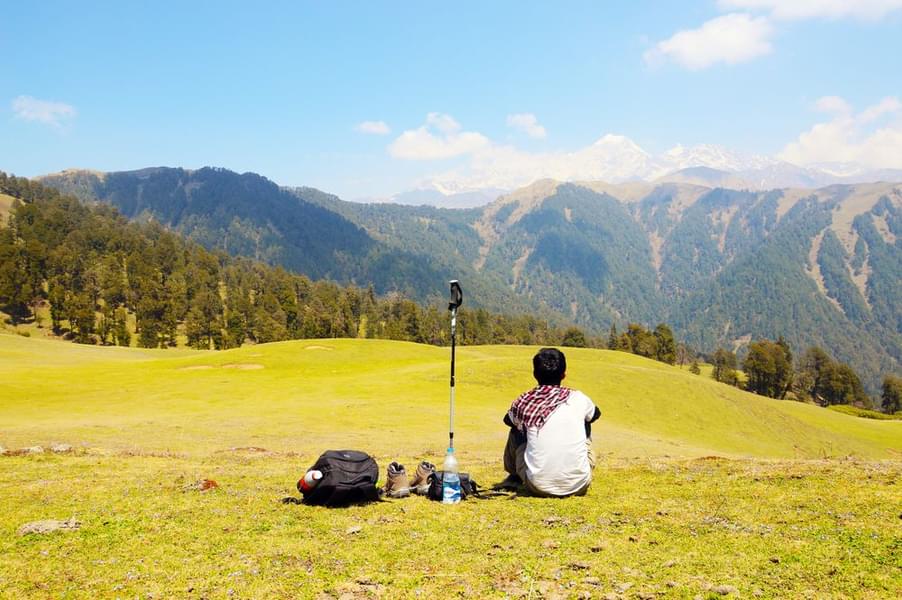
If you are looking for an offbeat Himalayan trek, the Dayara Bugyal trek is the perfect experience for you. One of the unique Uttarakhand treks in May, the trail is an easy-to-moderate trek that sees few trekkers despite its proximity to Gangotri. The six-day trek has stunning views of the Himalayas, as well as lush meadows and mesmerising campsites. Dayara Bugyal is highly suitable for amateur trekkers and families with kids.
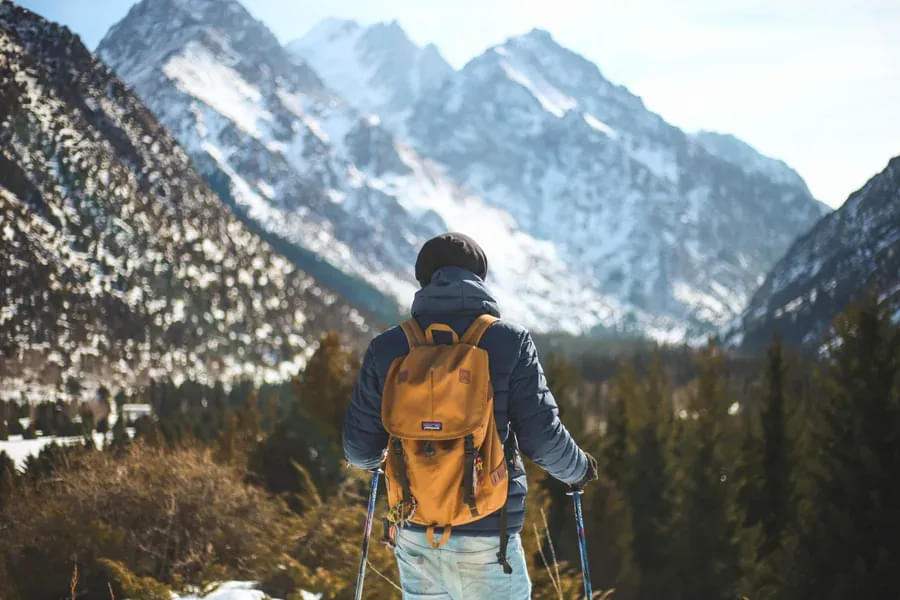
Renowned as the oldest Himalayan trek, Har ki Dun ranks among the most popular treks in May. With its ancient cultural traditions, the trail attracts trekkers looking for an adventure filled with fascinating sights and stories. Cross old villages that date back many centuries as you interact with locals and admire the mighty mountains, valleys, and vibrant flora of Har ki Dun. Ranked as a moderate-difficulty trek, the Har ki Dun trek lasts eight days.
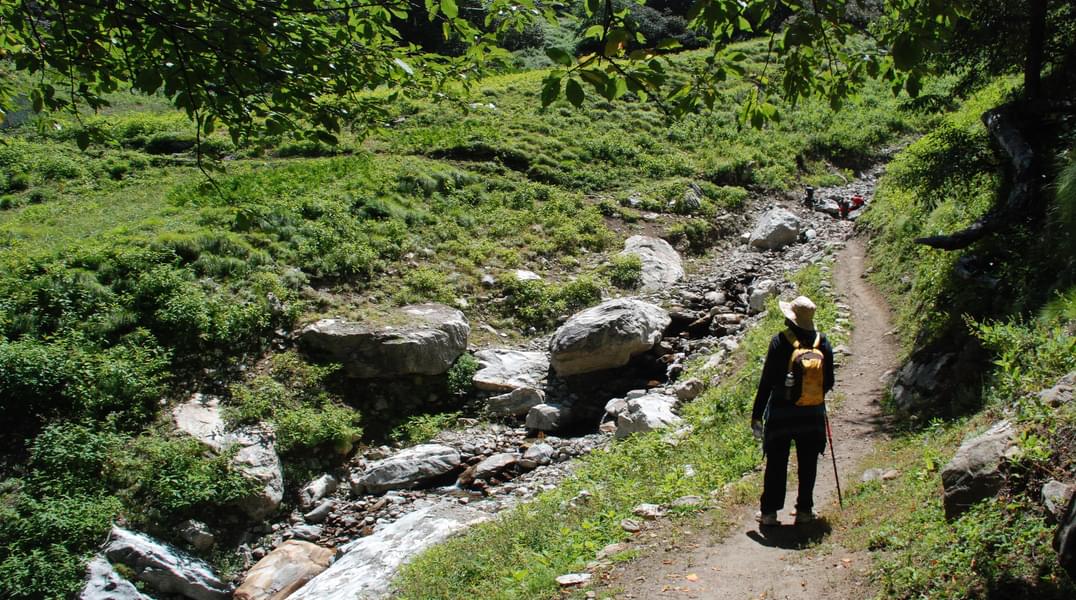
Among the many culturally vibrant Himalayan treks is the Kheerganga trek, one of the best treks in Himachal in May. From stunning meadows, pine forests, and small villages to mesmerising waterfalls and massive mountains, trek through the Parvati valley on this three-day experience. Witness the beauty of a cross-cultural experience as you watch ancient Indian traditions mix up with the hippie culture. Admire the exquisite Parvati Kund as you listen to fascinating stories from your guide.
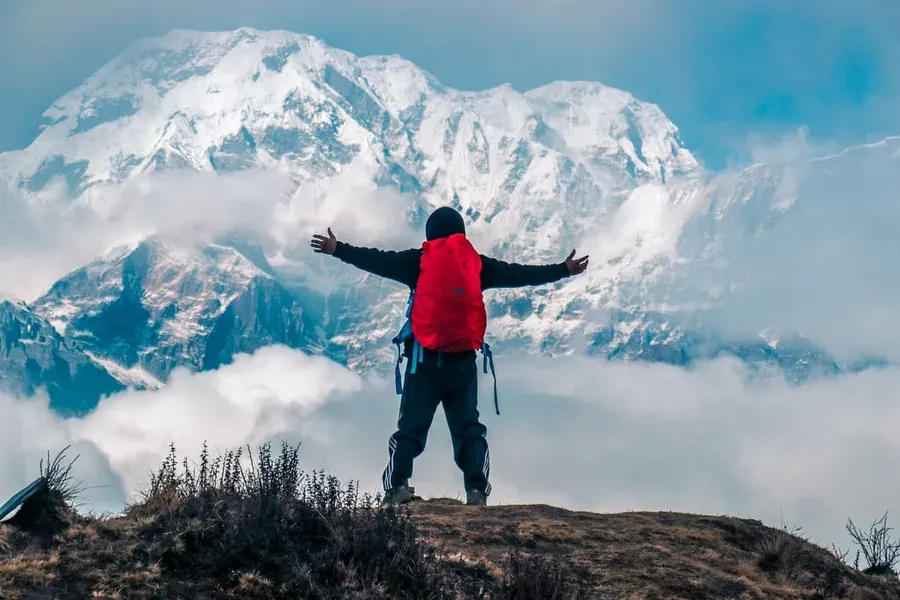
Embark on one of the most beautiful Uttarakhand treks in May as you go for the Rupin Pass trek. Ranked as a moderate-to-difficult trek, the seven-day experience is among the classic Himalayan treks with tons of surprises in store for trekkers. Explore the mesmerising beauty of the Himalayas with every step as you trek through hanging villages, glacial meadows, valleys, snowfields, waterfalls, snow bridges, forests, and the serene Rupin River.
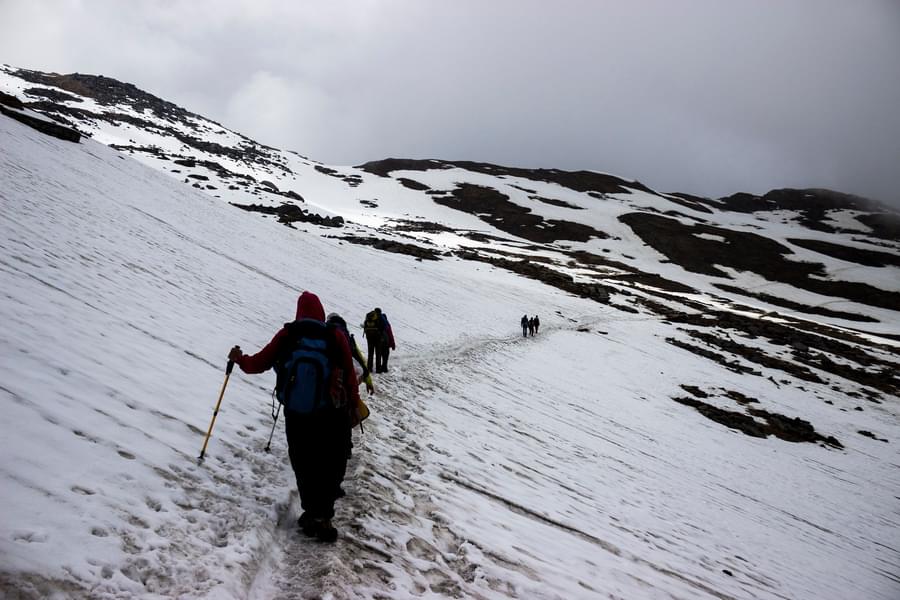
The eight-day Bali Pass trek is among the most stunning Uttarakhand treks in May and promises glimpses into the raw, unexplored side of the Himalayan ranges. Ranked as a difficult trek suitable only for experienced trekkers, Bali Pass is among the most thrilling Himalayan treks. Trek along the Tons and Ruinsara rivers and through the Ruinsara Valley and Devsu Thach. Enjoy 360-degree panoramic views of the Himalayan peaks of Kalanag, Bandarpoonch, and Swargarohini on the trek.
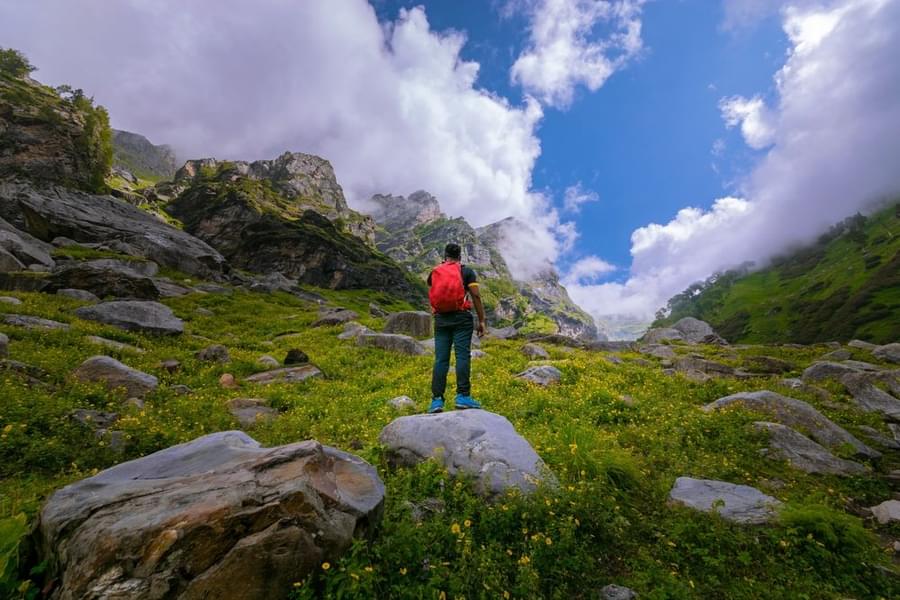
Explore one of the most thrilling treks in Himachal in May, the Hampta Pass Trek or Himachal’s Valley of Flowers. Witness the beauty of the vibrant and lively Kullu Valley and the rugged Lahaul Valley at this moderate-level trek. Experience six days of pure Himalayan magic as you trek amidst snow-covered mountains and green valleys. And as you reach the other end of Hampta Pass, be awed by the amazing views of the Spiti Valley.
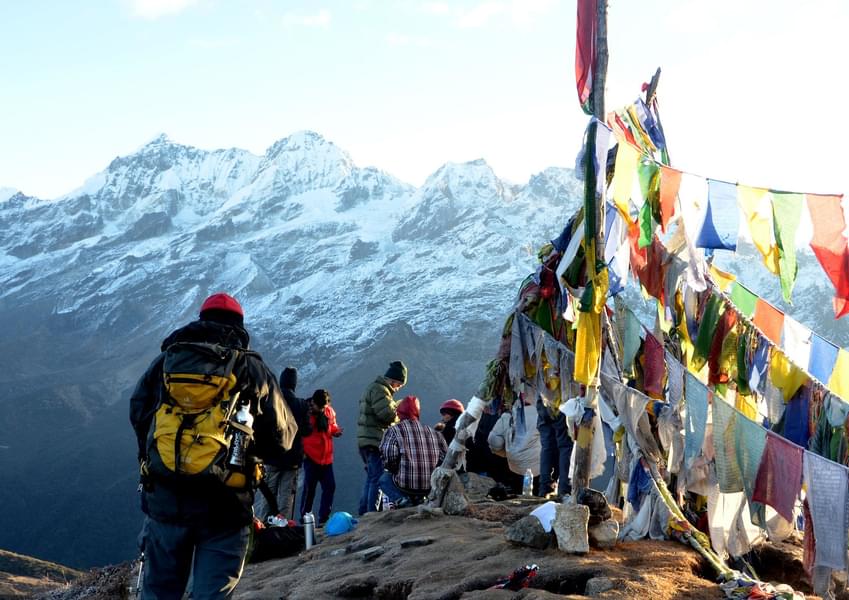
Renowned as one of the best treks in May, witness fifteen major Himalayan peaks from close quarters on the Goecha La Trek. From seeing the sunrise on Mt Kanchenjunga to mesmerising views of the Singalila Range from the Dzongri Top, get close to the iconic Nepalese mountain treks at the Goecha La Trek. With a moderate-to-difficult ranking, the trek also offers beautiful walks through rhododendron forests and sights of the stunning Samiti Lake.
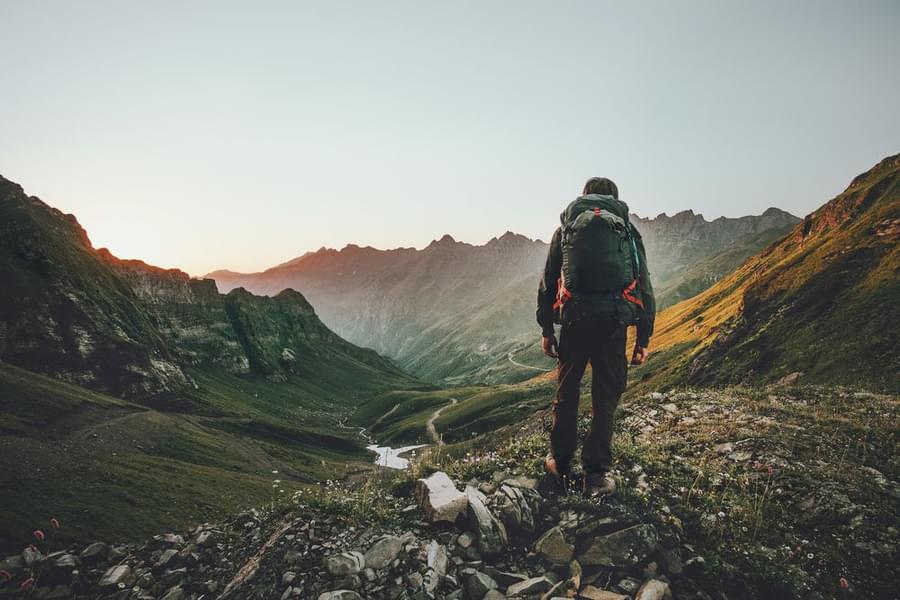
A moderate-to-difficult trek, Buran Ghati is among the most beautiful Himalayan adventures and one of the best treks to do in May. Explore the most stunning Himalayan forests and the lush meadows of Dayara as you sit back and relax under the stars at mesmerising campsites. An unmissable highlight of the trek is the pass crossing, where trekkers can witness snow even in the summer months at a height of 15,000 feet.
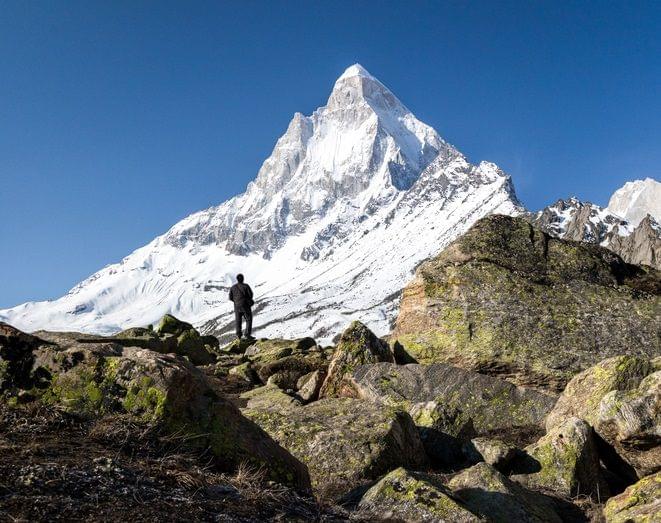
Witness the glacier which gives the mighty River Ganges life, the Gaumukh glacier, as you embark on the eight-day Gaumukh Tapovan trek. Ranked as a moderate-to-difficult trek, the trails also are the only way to witness Mt Shivling up close from base to summit. Other prominent sights include the famous Mt Meru, as well as the Bhagirathi River that originates at the Gaumukh glacier. Marvel at Mt Shivling at sunrise as you complete your trekking adventure.
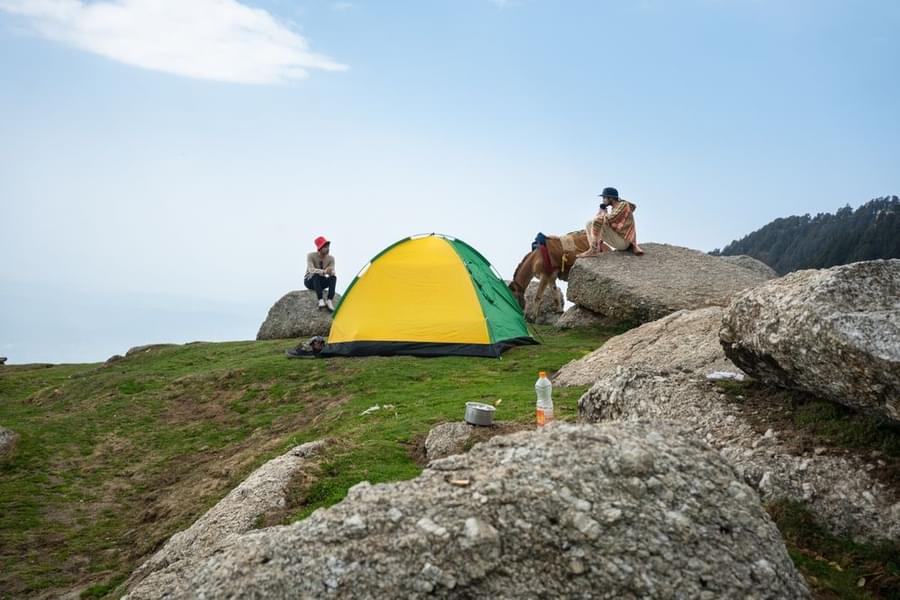
Embark on one of the easiest Himalayan treks at the Triund Trek, ranked among the best treks to do in May. Indulge in stunning views of the Dhauladhar range and Kangra valley on this two-day trek, which falls in the easy-to-moderate range of the trek difficulty scale. From beautiful pine, rhododendron, and coniferous forests to old villages, Triund has numerous fascinating stories and legends associated with the trek trails and highlights.
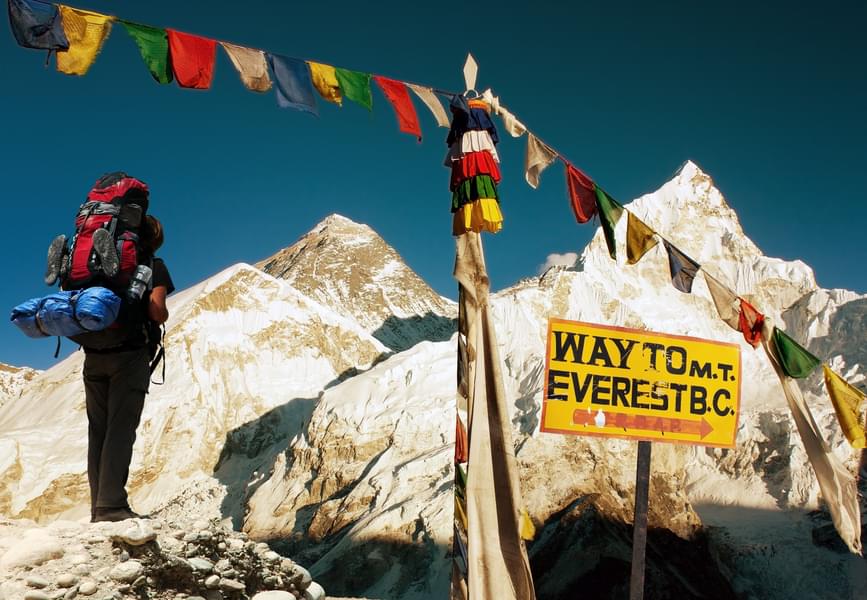
If you are looking for the ultimate Himalayan trekking adventure, nothing compares to the Everest Base Camp Trek. The two-week adventure, which ranks among the most thrilling and difficult Himalayan treks to do in May, attracts mountaineers from across the globe with its never-seen-before trails and stunning scenery. Admire the one-of-their-kind views of the world’s highest mountain as you trek through green farmlands, forests, and rivers to reach the barren, glacial landscape higher up.
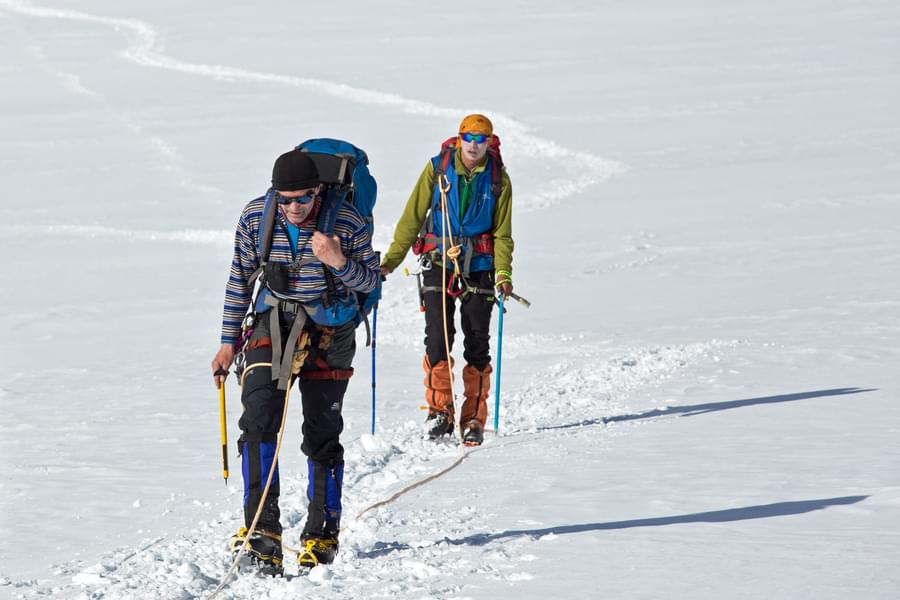
Climb up to one of the highest peaks of the Himalayan Pir Panjal range as you embark on the Friendship Peak trek, which is among the most popular treks in Himachal in May. As you trek through the adventurous trails over a period of nine days, witness the stunning beauty of the mountains, forests, streams, and the beautiful Solang Valley. Admire views of the Hanuman Tibba, Shitidhar, Deo Tibba and Indra Asan on this trek.
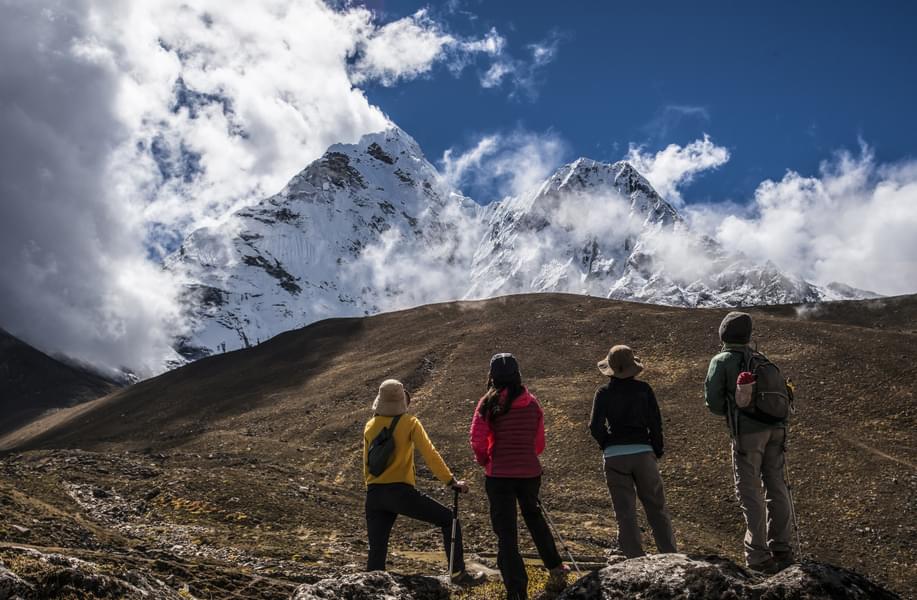
Experience the mesmerising beauty of Sikkimese Himalayan treks as you go for the Dzongri Trek, one of the best treks in May. Ranked as a moderate-difficulty trek, the adventure lasts ten days and covers Himalayan peaks like Mt Kabru, Mt Kanchenjunga, Mt Ratong, Mt Narsingh, Mt Pandim, and Mt Koktang. Walk through the rugged trails of this short high-elevation trek and be awed by the lush valleys, waterfalls, and streams here.
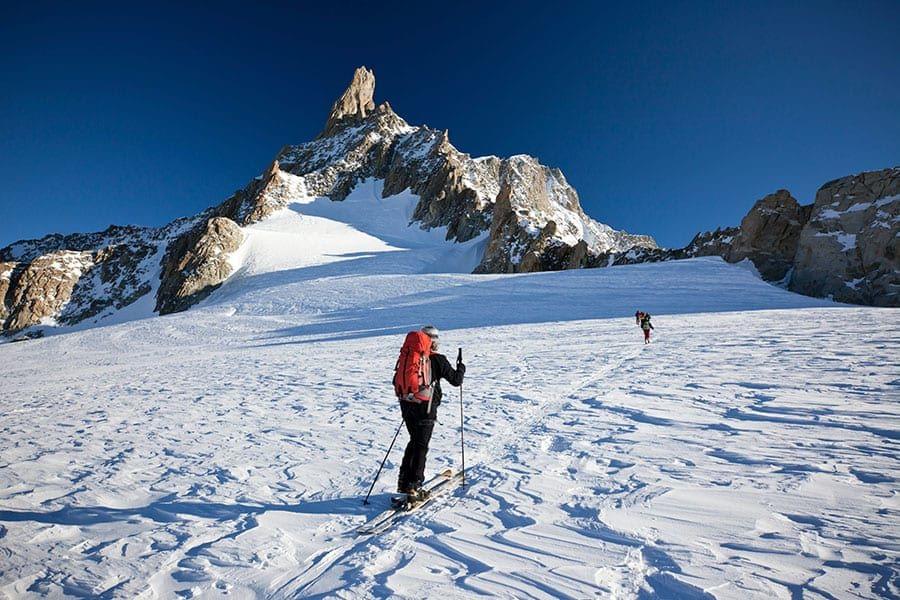
One of the best treks in May is the Sar Pass Trek, which traverses through the Parvati Valley along the mighty Parvati River. The five-day trek ranks as a moderate-difficulty trail, which offers magnificent views of the Himalayan mountains, forests, meadows, valleys, and ice-covered landscapes. Witness the frozen Sar Lake which gives the trek its name, along with exploring the local cultural traditions of the region with your highly experienced guides.
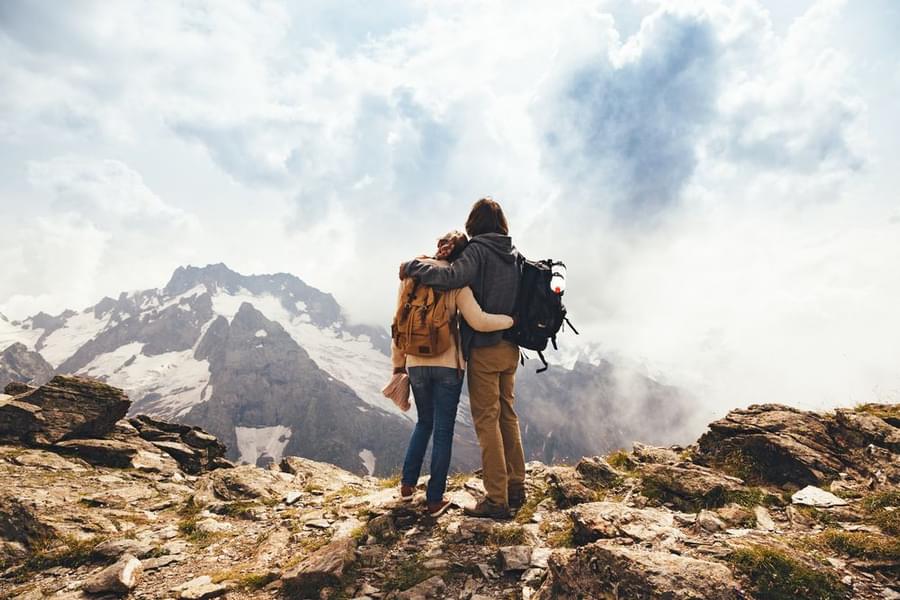
Ranked among the best treks in May, the Indrahar Pass Trek ranks among the moderate-to-difficult Himalayan adventures every trekker needs to experience. One of the most mesmerising treks on offer in Himachal, the four-day trek covers trails that have many steep ascents and sharp climbs. Admire the stunning views of the Dhauladhar mountain range, green valleys, and vibrant flora as you spot the beautiful pristine lakes of Mankini and Kareri.
Why May is the Best Time for Trekking?
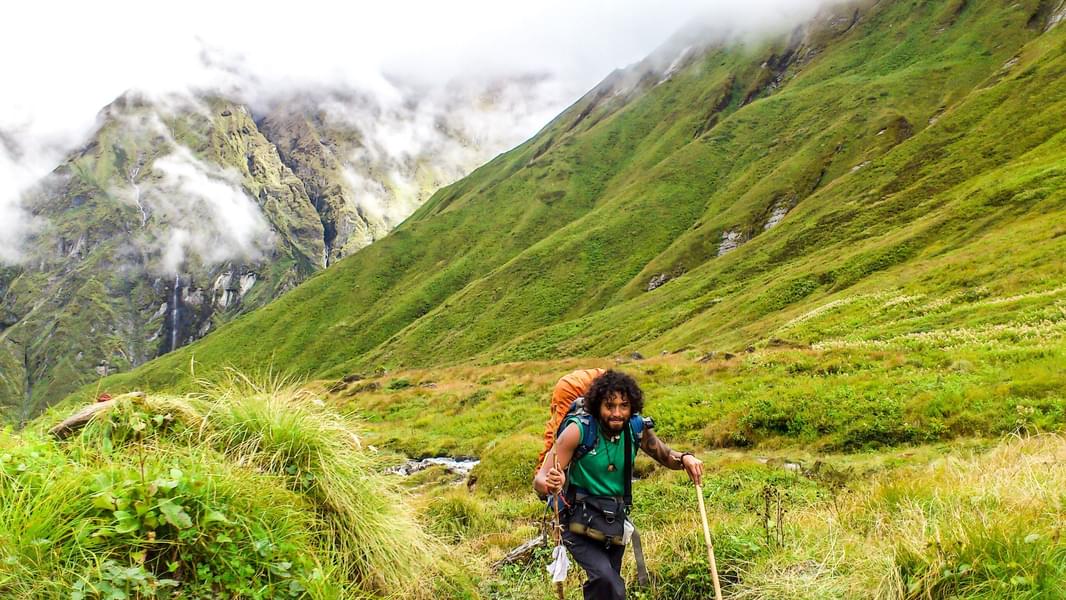
Treks in May are popular for a variety of reasons, the most prominent being the moderate temperatures in the Himalayan region. While much of India faces the peak summer season in May, the Himalayan ranges of Uttarakhand, Himachal, and Sikkim witness the beginning of the peak trekking season. Bright sunshine, clear skies, melting snow cover, and abundant greenery can be experienced on the trekking trails in May when the average temperatures hover around 25 degrees at the base camp and go lower as you climb higher up.
Trekkers can also encounter snow on some high-altitude Himalayan treks to do in May. The night temperatures are slightly cool while the day temperatures are warmer, making it ideal for trekking in mild weather conditions. As summer starts in the region in May, trekkers can still witness the remnants of vibrant spring blossoms and admire the flowing streams and rivers as glaciers melt in summer.
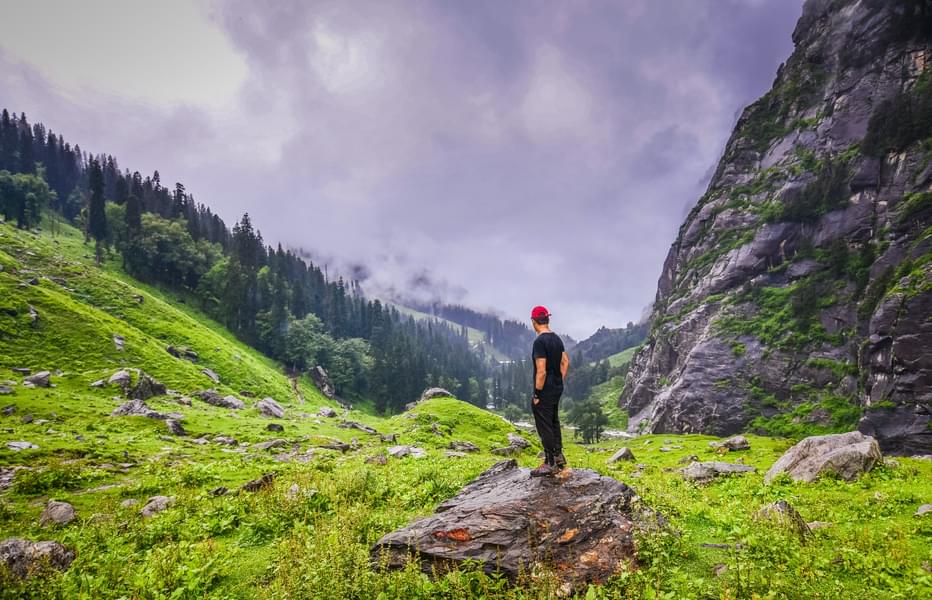
The Himalayas are renowned as snow-covered mountains, but when you go for treks in May, you would be able to witness a pristine landscape covered with lush greenery and vibrant flora. The lush green meadows of the best treks in May are a prominent highlight and draw trekkers from across the world. Admire the picture-perfect views of the mighty Himalayas rising beyond the vast green meadows and lush valleys. From exotic wildflowers to pine, oak, rhododendron, and coniferous forests, the beautiful flora one can witness on these Himalayan treks is unmatched. As the snow melts and temperatures get warmer in May, the floral blossoms bloom and spread colours and sweet fragrances throughout the Himalayan trails, making it the best time to go trekking for nature lovers. Trekkers can also indulge in local folklore and traditions as they learn about unique herbs and plants from their guide and locals.

The best treks in May offer the perfect weather conditions for adventurers. From bright sunshine to clear blue skies, as the summer season begins in the Himalayas, trekkers can experience the most popular trails in comfortable conditions.
The precipitation in May is low, which means trekkers can climb through dry lands without worrying about wet patches and sudden rainfall. As the nights are cool and days warm, walking through the terrain and resting at campsites become pleasant experiences. From lush green meadows and dense oak, pine, rhododendron and coniferous forests, trekkers can witness Himalayan flora at its most vibrant as they blossom fully in the warm weather of May. While the lower reaches have temperatures averaging around 25 degrees Celsius, it gets cooler as you climb higher up, with some high-altitude treks even having snow in the higher reaches. Witness the best of the Himalayan treks as you go for an adventure in the warm and dry weather of May.
FAQs About Treks in May
Which himalayan trek is best to do in may.
The best treks in May include the Dayara Bugyal Trek, Har ki Dun Trek, Kheerganga Trek, Rupin Pass Trek, Bali Pass Trek, Hampta Pass Trek, Goecha La Trek, Buran Ghati Trek, Gaumukh Tapovan Trek, Triund Trek, Everest Base Camp Trek, Friendship Peak Trek, Dzongri Trek, Sar Pass Trek, and the Indrahar Pass Trek.
Which Himalayan trek has snow in May?
The treks in May that have snow to offer to trekkers are those with altitudes higher than 13,000 feet. The Himalayan treks where one can find snow in May are Buran Ghati Trek, Goecha La Trek, Rupin Pass Trek, Gaumukh Tapovan Trek, and the Hampta Pass Trek.
Can you trek in Nepal in May?
Yes, you can trek in Nepal in May. Nepal is much sought-after for its iconic trekking trails that take trekkers close to the mighty Himalayan ranges, and May is among the best months to embark on such treks. The weather in Nepal in May is moderate, with mild temperatures, minimal rainfall, and fewer crowds.
Which treks in Himachal are best to do in May?
The best treks in Himachal in May include Kheerganga Trek, Hampta Pass Trek, Buran Ghati Trek, Triund Trek, Friendship Peak Trek, Sar Pass Trek, and Indrahar Pass Trek.
Which treks in Uttarakhand are best to do in May?
The best Uttarakhand treks in May include the Dayara Bugyal Trek, Har ki Dun Trek, Rupin Pass Trek, Bali Pass Trek, and Gaumukh Tapovan Trek.
More Treks in Himalayas
- State Wise Treks
- Challenging treks in Himalayas
- Treks in Summers
- Treks in Winters
- Treks in Monsoon
- Treks in Autumn
.png?w=auto&h=400)
The content and images used on this site are copyright protected and copyrights vests with the respective owners.

To Travel is to Live
SarPass Trek, Kasol
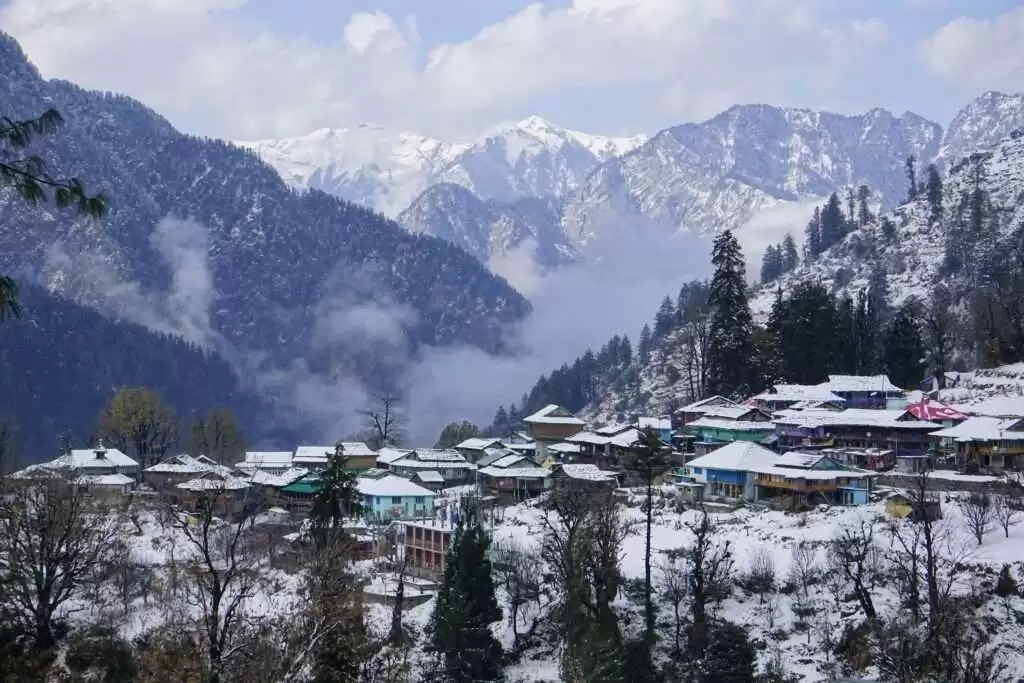
- Trek Reviews 4.7/5.0 (981 Reviews)
- Trek Height 13,800 feet (4,206 meters)
- Trek Distance 48 km
- Trek Duration 5 Days
Includes/Excludes
Start your Journey From Delhi By Evening
We Will Reaching Kasol by Morning 8 AM
Note :- WDRLUST is not responsible for the running, punctuality, etc of the bus.
(We do suggest to take 7N8D Package for better Experience)
Starting Time - 9:30 A.M
Brief orientation with guides and trek leaders the trek starts.
Kasol To Grahan (7K.M) - First day trek aims to Grahan village which consumes 3-4 hours from Kasol. Trail cover Pine forest and steep forward till Grahan Nahal. - After Grahan Nahal the trail becomes More rocky and sleepy. After a hour of trek we will reach Grahan Village. Dinner and stay overnight.
Starting Time - 8:30 A.M
having breakfast trek starts to Min Thatch.
Grahan To MIn Tanch (7K.M) - During the trails will cross over the view of Min Thatch, Nagaru and Sar top on the mountains. The steeper trail will take you to the woods. - Cross the lush green forest and reach Min Thatch. Admire the Chanderkhani stretch and many more ranges from the campsite at Min Thatch.
After breakfast trek to Nagaru through Pastoral forest.
Mintach To Nagaru(7K.M) - After a difficult trek for 4-5 hours, you will finally reach the Nagaru campsite. - Enjoy the mesmerizing vistas of the magnificent mountain across the Parvati valley. - See the small glittering lights of the Manikaran town as the night sets in. It gets extremely chilly in the evening.
Rise and shine early in the morning to start your trek.(4A.M)
Nagaru To Biskeri(7K.M) - Climb up through Sow trails and admire the dazzling peaks of Tosh Valley. - The exhilarating view on the top of Sar Pass will leave you spellbound Spend some more time experiencing the beauty of the top. - Try sliding through the snow with necessary precautions. Walk for an hour and cross some magical water streams to reach the Biskeri Thatch campsite by evening.
Biskeri To Barsheni(7K.M) - Start trekking downhill through the dense forest, crossing a stream, and then reach Pulga. - The twin village Pulga and Tulga are separated by a stream. Cross the bridge on the Parvati River to reach the Barshaini Village.
We are going to reach Delhi by Morning,
Inclusion/Exclusion
- Accommodation in Homestay or Camping
- 4 - (Dinner, Lunch, Breakfast, Evening snacks)
- All permits and Entry Fees
- Trek equipment( sleeping bag, tent, gaiter)
- Trek leaders & Guide
- Transport from Delhi to Delhi
- Anything apart from inclusion.
- Personal Expenses.
Sarpass Trek, Kasol
Sar pass is one of the most fascinating and amazing places in the amazing Parvati Valley.
Trek is highly appreciated and revered for its mesmerizing snow-covered landscape, which makes it a real destination for trekking and exploring.
Sar Pass is the ideal place to live out all your fantasies related to snow and the snow covered mountains.
The place has an eternal touch of nature which gives it an edge over other destinations.
The place is soothing and drenched with a wave of sanguinity, which makes it even more fascinating.
Height and Elevation of the Sar Pass
The SarPass Trek is situated at a notable altitude in the majestic Himalayan region. Here are the details regarding its altitude and elevation:
Altitude/Height:
Approximately 13,800 feet (4,206 meters) above sea level.
The Trek takes you through diverse landscapes, ranging from lower altitudes to the peak. The trek typically starts at an elevation of around 7,000 feet (2,134 meters) and gradually ascends to the highest point at 13,800 feet (4,206 meters).
Trail Highlights:
As you ascend through the varying elevations, you’ll traverse dense forests, serene meadows, and snow-clad stretches. The changing elevation adds to the trek’s appeal, offering different ecosystems and breathtaking views at every altitude.
Acclimatization:
Given the substantial elevation gain, proper acclimatization is crucial during the Trek. Trekkers often follow a gradual ascent strategy to allow their bodies to adjust to the increasing altitude, minimizing the risk of altitude-related issues.
High-Altitude Challenges:
The higher elevations bring cooler temperatures and thinner air, making the trek physically demanding. It’s essential for trekkers to be well-prepared with suitable gear, clothing, and an understanding of altitude-related challenges.
Sar Pass Summit:
Reaching the summit at 13,800 feet is a gratifying accomplishment. Trekkers are rewarded with breathtaking panoramic views of the surrounding peaks, valleys, and snow-capped landscapes, making the challenging ascent well worth the effort.
The altitude and elevation of the SarPass is not only define its physical demands but also contribute to the overall experience, creating lasting memories for those who undertake this Himalayan adventure.
Trek Location
The super luxurious trek has a moderate distance of about 48 km, making it relatively lengthy.
Even though it feels like a gigantic journey, it’ is not. The trip is full of unparalleled variety and amazing decor.
The trip offers numerous amazing and terrible sights, which makes it an ideal destination for tourism and tours.
Sar Pass Trek Weather & Temperature
The trek is one of those multi-dimensional destinations that all have their own peculiarities and a wonderful balance that makes them even more appealing.
The rainfall is sufficient to take a tour and explore the landscape. The weather in Sar Pass has its own mood that makes it a seductive and amazing thing.
The rain on Sar Pass trip provides a much better perspective and a great experience that is worth every penny spent and enriching.
Best Time to visit Sar Pass Trek
The Sar trek is best undertaken during specific seasons when the weather is favorable, and the trekking conditions are optimal. The ideal time to do the SarPas trek is during the late spring to early autumn months. Here are the best times to consider:
Late April to June:
- Weather: Late April to June marks the spring and early summer season. The weather is pleasant with daytime temperatures ranging from 12°C to 20°C.
- Landscape: The trail during this period is vibrant with blooming flowers and greenery. The meadows come to life, providing picturesque landscapes.
- Accessibility: The trekking paths are generally clear of snow, making it easier to navigate. However, early in the season, some patches of snow may still be encountered at higher altitudes.
September to October:
- Weather: Post-monsoon, the weather becomes clear and stable. Daytime temperatures range from 10°C to 15°C.
- Landscape: The landscapes are lush after the monsoon rains, and the skies are generally clear, offering excellent visibility.
- Accessibility: The trails are well-established, and the chances of encountering snow are minimal. The trekking conditions are generally favorable.
Considerations:
July and august (monsoon):.
Monsoon brings heavy rainfall, making the trails slippery and increasing the risk of landslides. Trekking during the monsoon is not advisable.
November to April (Winter):
Winter months bring snowfall, and the temperatures drop significantly, especially at higher altitudes. The trek becomes challenging and may not be suitable for everyone.
Always check the current weather conditions and the status of the trekking trail before planning your Sar Pass . Additionally, it’s advisable to go with a knowledgeable guide and be well-prepared for varying weather conditions during your trek.
Sar Pass trek distance
The trek is approximately 48 kilometers (29.8 miles) long. This distance includes both ascending and descending sections, covering a variety of terrains, landscapes, and altitudes.
The trek usually takes around 5 to 6 days to complete, depending on the itinerary chosen by trek organizers or individual trekkers.
Here’s a rough breakdown of the distance covered on each day of the Sar Pass trek:
The trek often begins from Kasol, and the first day may involve covering a moderate distance to reach the initial campsite. This distance is usually shorter to allow trekkers to acclimatize.
These days involve trekking through different landscapes, including dense forests, meadows, and steep ascents. Each day covers a varying distance to reach the designated campsites or halts.
The day of crossing Sar Pass itself, which is the highest point of the trek. Trekkers ascend to Pass and then descend to the next campsite, covering a significant distance on this day.
The final day may involve descending to the endpoint of the trek, which could be a village like Barshaini or another designated location.
It’s essential to note that these distances can vary based on the specific trekking route chosen and the itinerary planned by trek organizers. Trekkers should always check with their trek leaders or organizers for the most accurate and updated information regarding the trek distance and itinerary.
How difficult is the Sar Pass trek?
The difficulty level of this prestigious and highly rated trekking destination is in the medium range, which makes it a descent destination,
The journey to Sar Pass has a wonderful altitude that could send goosebumps down the spine of the climber,
but it’ is moderate enough to continue hiking and exploring the fascinating place that is a majestic experience.
The journey to Pass will test you in a way that could make excursionists and alpinists shy away from difficulties. sarpass trip
Is Sar Pass Trek something for newcomers?
The Sar Pass is classified as easy to relatively easy and is known to be a great place to stay.
The Sar Pass trip brings joy and excitement among the pedestrians and excursionists. sar pass trip.
And even for newcomers, this trip is a challenge and a preconceived notion about the touring experience.
For the newbies, the trip is perfect to improve their trekking skills, but they need to be very careful as it is a relatively delicate matter.
Things To Carry For Trek
- Backpack 65/90 L
- Water Bottle
- Energy Bars
- Weather Appropriate Clothing
- Warm Jacket
- Flee Jacket
- Sun protection
- Rain Protection
- Flashlight And Extra Batteries
- Extra Pair of Clothing
- Personal Hygiene Kit
- Mini First Aid Kit
- Personal Medication
- Moisture Cream
- Insect repellent
- An emergency whistle
Checkout Similar Treks Near Kasol
Trek to Indrahar pass
Unexplored Mcleodganj Triund Trek
The Sar Pass trek is located in the Parvati Valley of Himachal Pradesh, India.
The SarPass trek takes around 4-5 days.
The Sar Pass trek is blessed with a gigantic and prestigious altitude that spans around 13800ft.
The best time to visit Sar Pass is from April to November.
The starting point of the hike is Kasol, and the end point is Barsheni.
The Sar Pass trek visits a variety of landscapes, including deep woodlands, a snow-covered environment.
An individual typically pays around Rs 8000 to Rs 9500 per person for a trek from Delhi to Delhi
Star Trek: Discovery
Information
Accessibility.
Copyright © 2024 Apple Inc. All rights reserved.
Internet Service Terms Apple TV & Privacy Cookie Policy Support
- Solar Eclipse 2024
See the 2024 Solar Eclipse’s Path of Totality
A total solar eclipse is expected to pass through the United States on April 8, 2024, giving stargazers across the country the opportunity to view the celestial phenomenon in which the sun is completely covered by the moon.
The eclipse will enter the U.S. in Texas and exit in Maine. It is the last time a total solar eclipse will be visible in the contiguous United States until 2044.
Here's what to know about the path of the eclipse and where you can see it.
Read More : How Animals and Nature React to an Eclipse
Where can you see the total solar eclipse?
The eclipse will cross through North America, passing over parts of Mexico, the United States, and Canada.
The eclipse will enter the United States in Texas, and travel through Oklahoma, Arkansas, Missouri, Illinois, Kentucky, Indiana, Ohio, Pennsylvania, New York, Vermont, New Hampshire, and Maine. Small parts of Tennessee and Michigan will also experience the total solar eclipse.
Much of the eclipse's visibility depends on the weather. A cloudy day could prevent visitors from seeing the spectacle altogether.
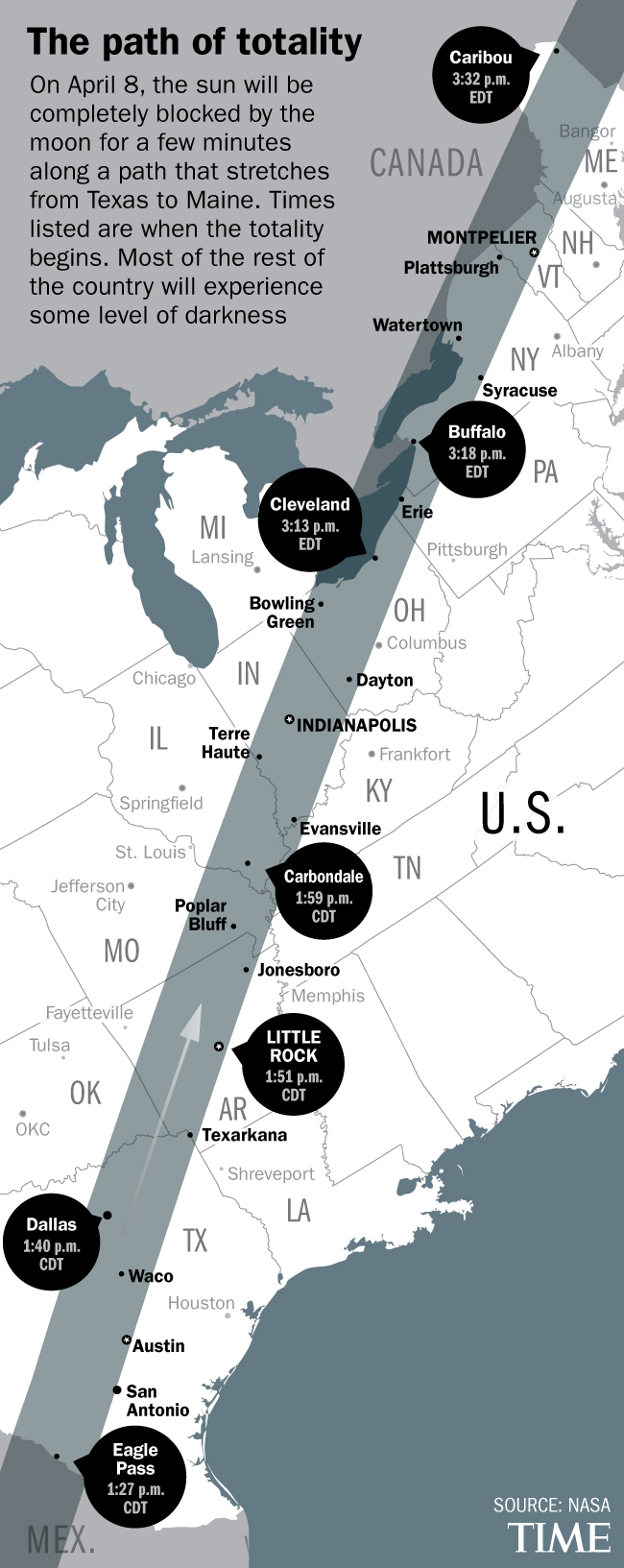
When does the solar eclipse start and end?
The solar eclipse will begin in Mexico’s Pacific coast at around 11:07 a.m. PDT. It will exit continental North America on the Atlantic coast of Newfoundland, Canada, at 5:16 p.m. NDT.
The longest duration of totality—which is when the moon completely covers the sun — will be 4 minutes, 28 seconds, near Torreón, Mexico. Most places along the path of totality will see a totality duration between 3.5 and 4 minutes.
Read More : The Eclipse Could Bring $1.5 Billion Into States on the Path of Totality
Where’s the best place to see the total solar eclipse?
The best place to witness the event is along the path of totality. Thirteen states will be along the path of totality, and many towns across the country are preparing for the deluge of visitors— planning eclipse watch parties and events in the days leading up to totality.
In Rochester, NY, the Rochester Museum and Science Center is hosting a multi-day festival that includes a range of events and activities. Russellville, Arkansas will host an event with activities including live music, science presentations, tethered hot-air balloon rides, and telescope viewings.
More Must-Reads From TIME
- Exclusive: Google Workers Revolt Over $1.2 Billion Contract With Israel
- Jane Fonda Champions Climate Action for Every Generation
- Stop Looking for Your Forever Home
- The Sympathizer Counters 50 Years of Hollywood Vietnam War Narratives
- The Bliss of Seeing the Eclipse From Cleveland
- Hormonal Birth Control Doesn’t Deserve Its Bad Reputation
- The Best TV Shows to Watch on Peacock
- Want Weekly Recs on What to Watch, Read, and More? Sign Up for Worth Your Time
Write to Simmone Shah at [email protected]
You May Also Like

COMMENTS
An ideal trek for beginners. Trek through forests, meadows and quaint villages. Climb to the summit of Sar Pass at 13,799 feet for stunning views of snow-capped mountains. The trek starts from Kasol, which is a haven for backpackers from around the globe. This trail attracts large weekend crowds.
The Sar Pass Trek is a popular trekking route in the Parvati Valley of Himachal Kasol - India. -2024- Complete information, Itinerary, Route, Map, Best Season ... As you ascend towards Sar Pass, the trail may become progressively steeper and more challenging. You'll navigate through rugged terrain, possibly encountering snowfields or icy ...
The best time to do Sar Pass Trek is from May to October as the skies are usually clear and you will get to see the amazing panoramic views. During the trek, you can enjoy the hospitality and the friendliness of the people in the Himalayan villages and get a peek into their everyday lifestyle. You will also spot the rich biodiversity of the place.
Yes, You can witness snow in the Sar Pass Trek in May at the higher altitude places like the Sar Pass (top), Nagaru, and Biskeri Thach. Thrillophilia's Sar Pass trek itinerary includes all these spots, where we provide camp stays for an enriching experience. During the peak summers in May, you can expect lush and vibrant valleys in the lower ...
The Sar Pass Trek in the Himalayas passes through lush forests of deodar, pine, and rhododendrons. The trek is 48 km long and located at 13,800 ft. This trek is ideal for people who are beginners at trekking and want to see the majestic Himalayan mountains up close. The trek starts from the Himalayan Hamlet 'Kasol' and ends at Barshaini ...
5 Day 4: Flag off and Trek to Grahan. 6 Day 5: Trek to Padri Campsite. 7 Day 6: Trek to Min Thatch. 8 Day 7: Trek to Nagaru. 9 Day 8: Summit Day and Trek to Biskeri Thatch: 10 Day 9: Trek to Bandhak Thatch. 11 Day 10: Trek to Barshaini. 12 Packing Checklist for Sar Pass- The Best Himalayan Trek for Beginners.
Trek Distance. The Sar Pass Trek covers a total distance of approximately 48 kilometres (30 miles). It is usually completed over 5-6 days, depending on the pace and acclimatization of the trekkers. Each day's distance varies, ranging from 6 to 12 kilometres (4 to 7.5 miles), offering a perfect balance of trekking challenges and exploration.
The best time to do the Sar Pass trek is during the summer and post-monsoon seasons, which are considered the ideal months for trekking in the region. The recommended time frame for the Sar Pass trek is from May to June and September to October. Here's a breakdown of the seasons: 1. Summer Season (May to June):
Altitude: 4223 m. Duration: 5 Days. Sar Pass is an old favorite of trekkers in Kullu Region. The trek is recommended for all adventure souls who like snow and high mountains, irrespective of the prior experience. Starting from Kasol, Sar pass trek takes you through thick pine forests, beautiful alpine meadows, quaint villages, snow-covered ...
The best time to visit the Sar Pass Trek is from May to October, as the weather is pleasant, the skies are clear, and the views are breathtaking. You can enjoy the beauty and diversity of nature, culture, and adventure during these months. However, you should also check the weather forecast before starting the trek, as the weather conditions ...
The Sar Pass walk is rated as simple to moderate in difficulty. This walk is appropriate for families, school groups, and beginners. This Trek is simple to complete the first time. Best Time To Visit Sar Pass Trek: May through October are ideal for the Sar Pass walk because the skies are clear, and you can enjoy a breathtaking panoramic vista.
The Sar Pass trek starts from Kasol and you have to head left towards Grahan Nallah. This 8 km trek will last 4-5 hours and you will be following the Grahan Nalah route. This is one of the most frequently used trails by the villagers and localities and trekkers will pass the beautiful pine forests before the trail becomes uphill. This trail is ...
Best time for the Sar Pass trek Summer season(May to June) Summer months are best to plan the Sarr pass trek, the weather is pleasant during this time. This temperature remains mild during the day and the temperature falls during night time. During summer months the trails are clear of snow which makes the trekking experience easier.
Sar Pass trek is a 5-Day trekking adventure in the Parvati Vallley near Kasol, Himachal Pradesh. Sar Pass offers a complete hiking experience through dense forest walks, pristine Himalayan villages, wide panoramic views & adventurous summit of Sar Pass at 4,200 m. The best time for Sar Pass trek are the summer months of April, May & June.
Malana & Waichin Valley Trek Parashar Lake Trek, Himachal 2023 Hike Himalayan at 2300₹ Only. Sar Pass Trek 2023 5Days 4 Nights Bookings Available Call/WhatsApp +91 6239 416 707 Batches in May and June 2023. Certified Guide, Stay and Food included.
The weather during the Sar Pass trek from May to October is very pleasant at the base camp Kasol. The average temperature ranges between 20 degree Celsius and 35 degree Celsius. At the higher camps, the average temperature ranges from 15 - 20 degrees Celcius during the day and can drop below 5 degrees during the night.
Day 3: In the woods: Grahan to Min Thatch sa sar pass trekr pass trek. Highlights: 7/8 Kms | 4/5 hours | 2350 m - 3500m sar pass trek. Day 4: The cold trail: Min Thatch to Nagaru sar pass trek. Highlights: 4/6 Hours | 8/9 Kms | 3400 m - 3800m sar pass trek. Day 5: Snow trail: Nagaru - Sar Pass - Bishkeri sar pass trek.
Detailed Itinerary for Sar Pass Trek: Day 01: Kasol to Grahan Village (2347m) Distance/Duration - 7km / 4-5 Hours ... Kasol is a popular destination for adventure travelers and acts as the base camp for the Sar Pass Trek. But being a small town, you may or may not find technical trekking equipment like shoes and trekking poles. It is advisable ...
Sar Pass is a perfect trek for beginners. It's apt for those who want to experience all kinds of terrain. Forests, meadows, quaint villages, or snow-covered mountains, this trail offers a gamut of experiences to trekkers. ... away from the right bank of the river. One may be led to believe that this is not the right path, but one must not go ...
One of the best treks in May is the Sar Pass Trek, which traverses through the Parvati Valley along the mighty Parvati River. The five-day trek ranks as a moderate-difficulty trail, which offers magnificent views of the Himalayan mountains, forests, meadows, valleys, and ice-covered landscapes. Witness the frozen Sar Lake which gives the trek ...
About this video:-The Sar pass trek, offering an absolute escapade, is recommended for beginners and moderate level trekkers.It routes through a series of sc...
Kasol and Trek to Grahan Village. Starting Time - 9:30 A.M. Brief orientation with guides and trek leaders the trek starts. Kasol To Grahan (7K.M) - First day trek aims to Grahan village which consumes 3-4 hours from Kasol. Trail cover Pine forest and steep forward till Grahan Nahal. - After Grahan Nahal the trail becomes More rocky and sleepy.
S5 E3: On Trill, Captain Burnham, Book, and Culber must pass a dangerous test to prove themselves worthy of the next clue. Adira reconnects with Gray and Saru's first day as ambassador is complicated by his engagement to T'Rina.
A total solar eclipse is expected to pass through the United States on April 8, 2024, giving stargazers across the country the opportunity to view the celestial phenomenon in which the sun is ...